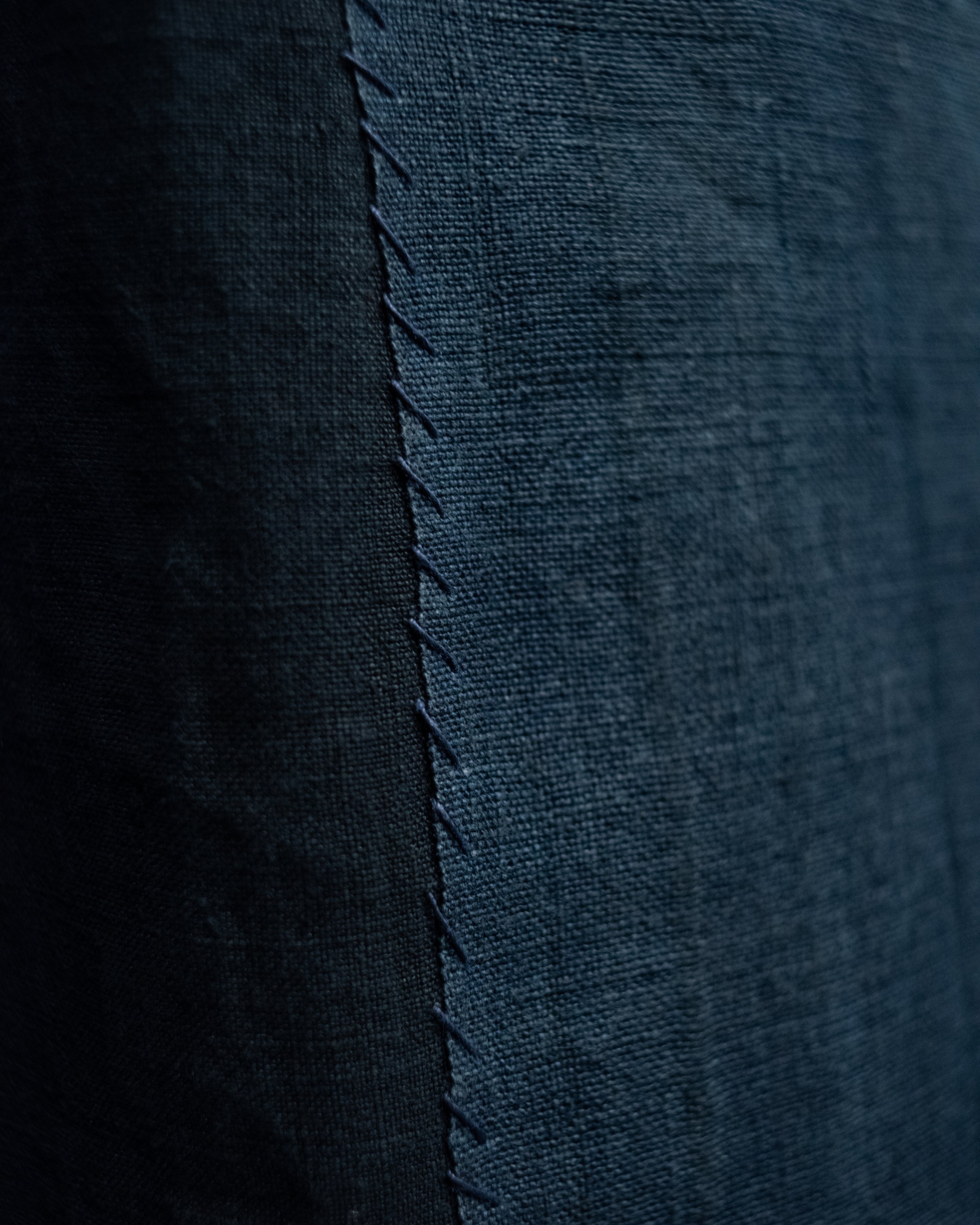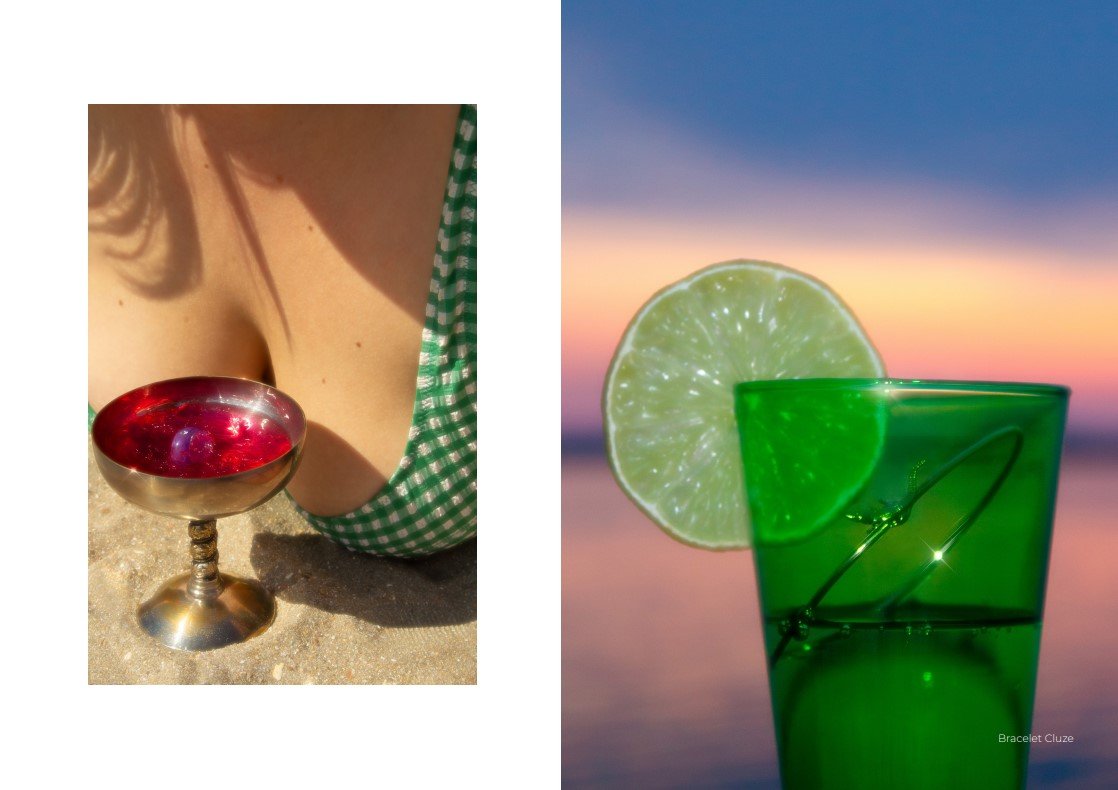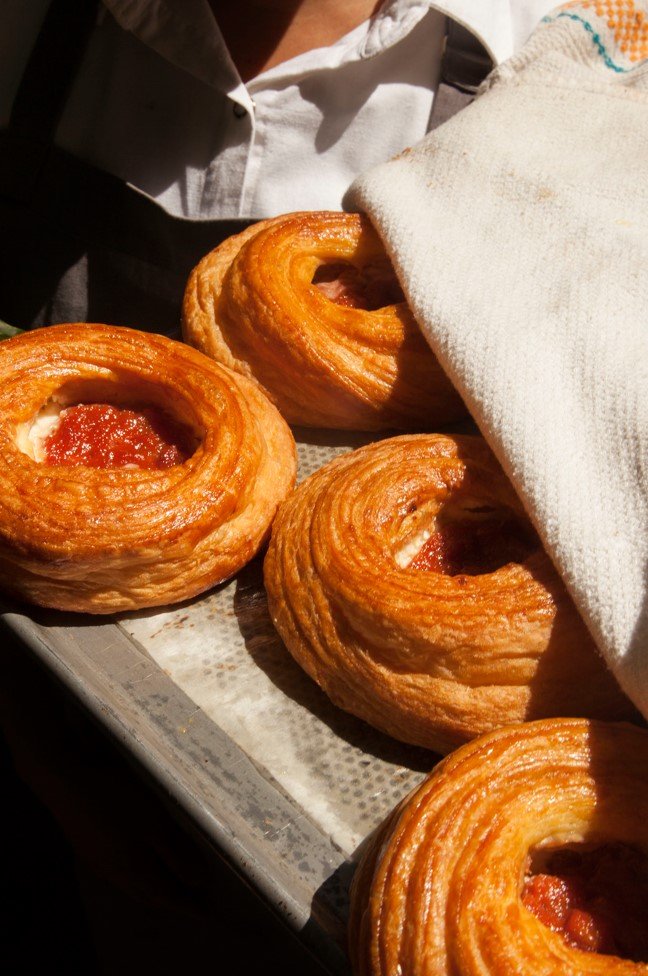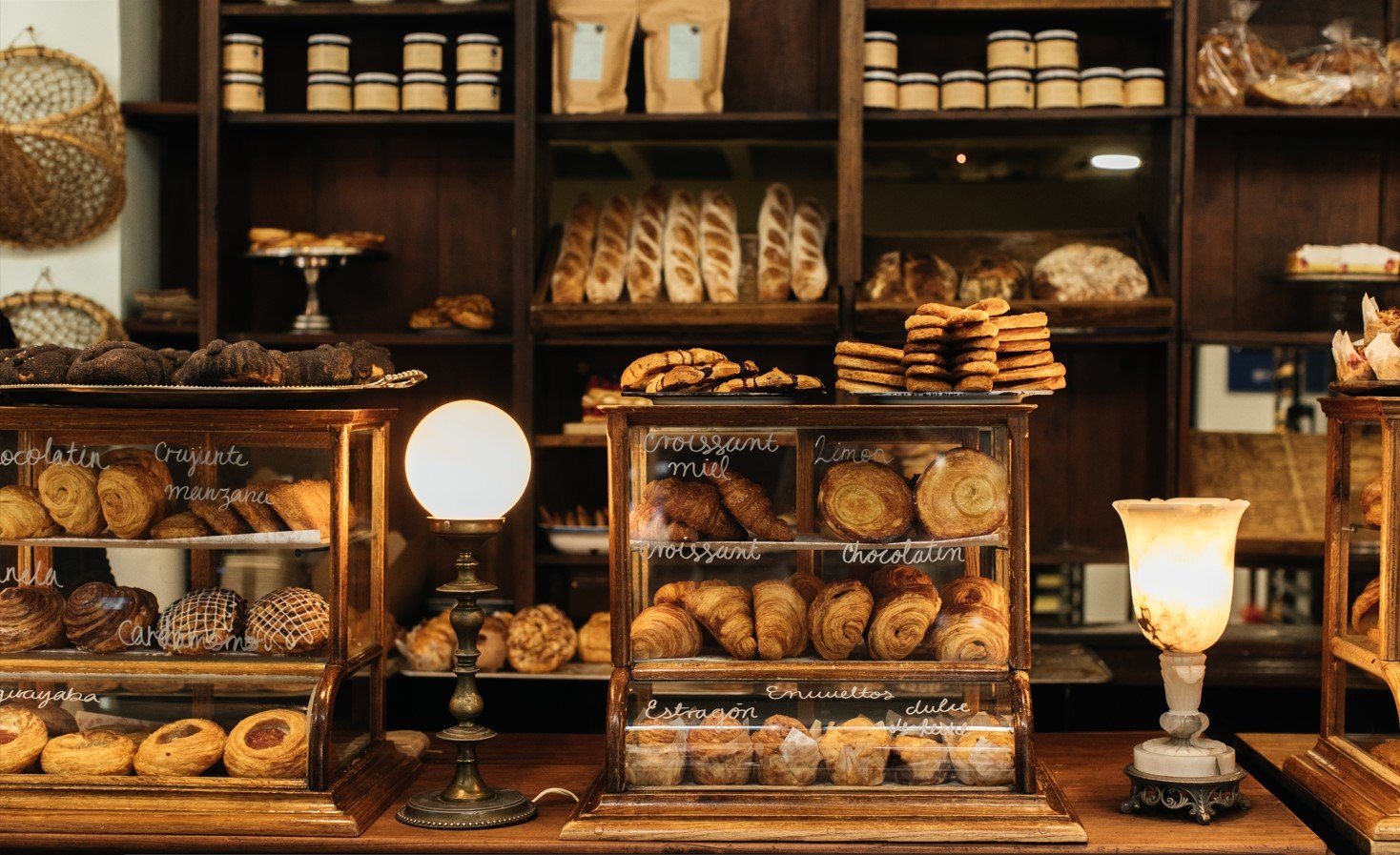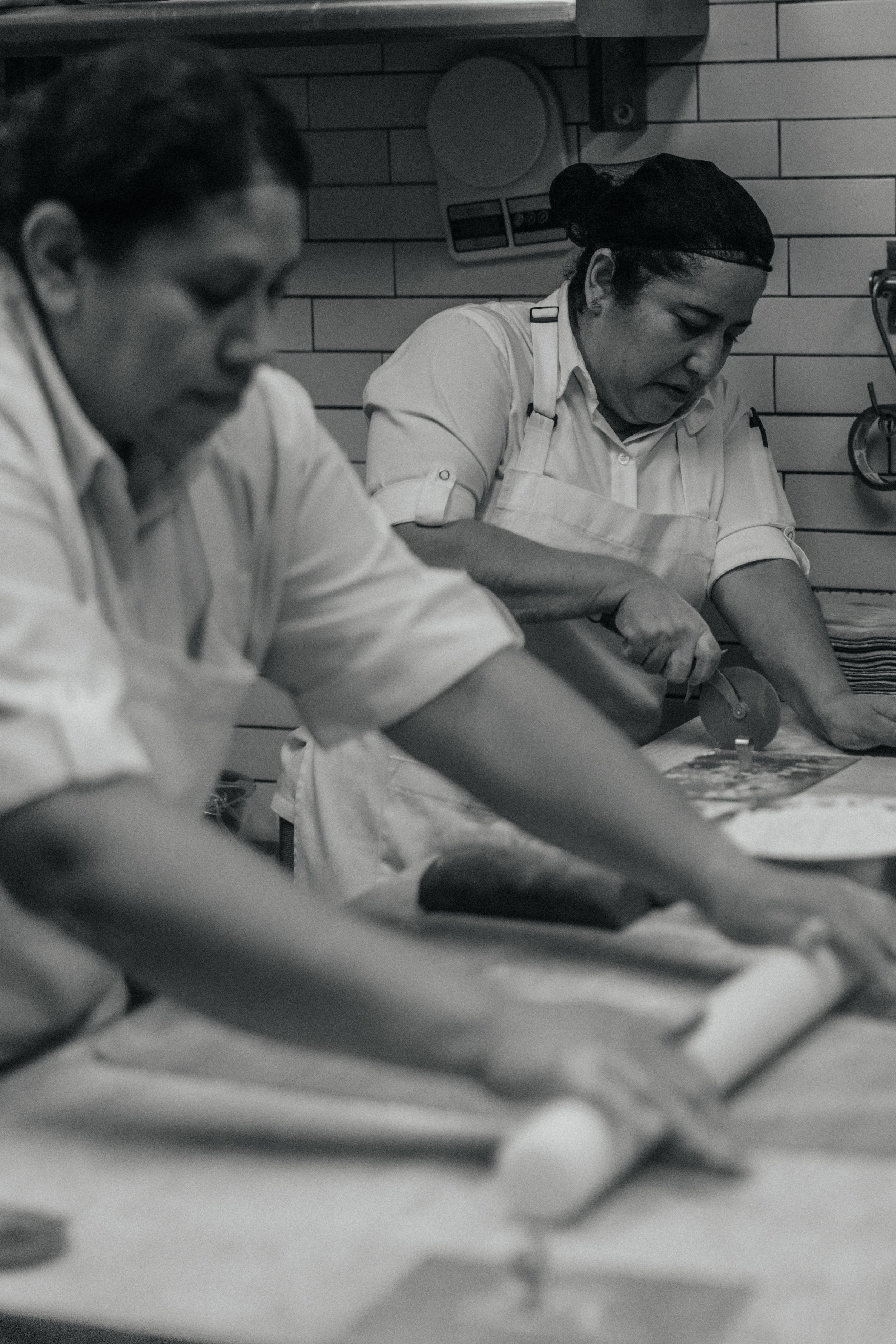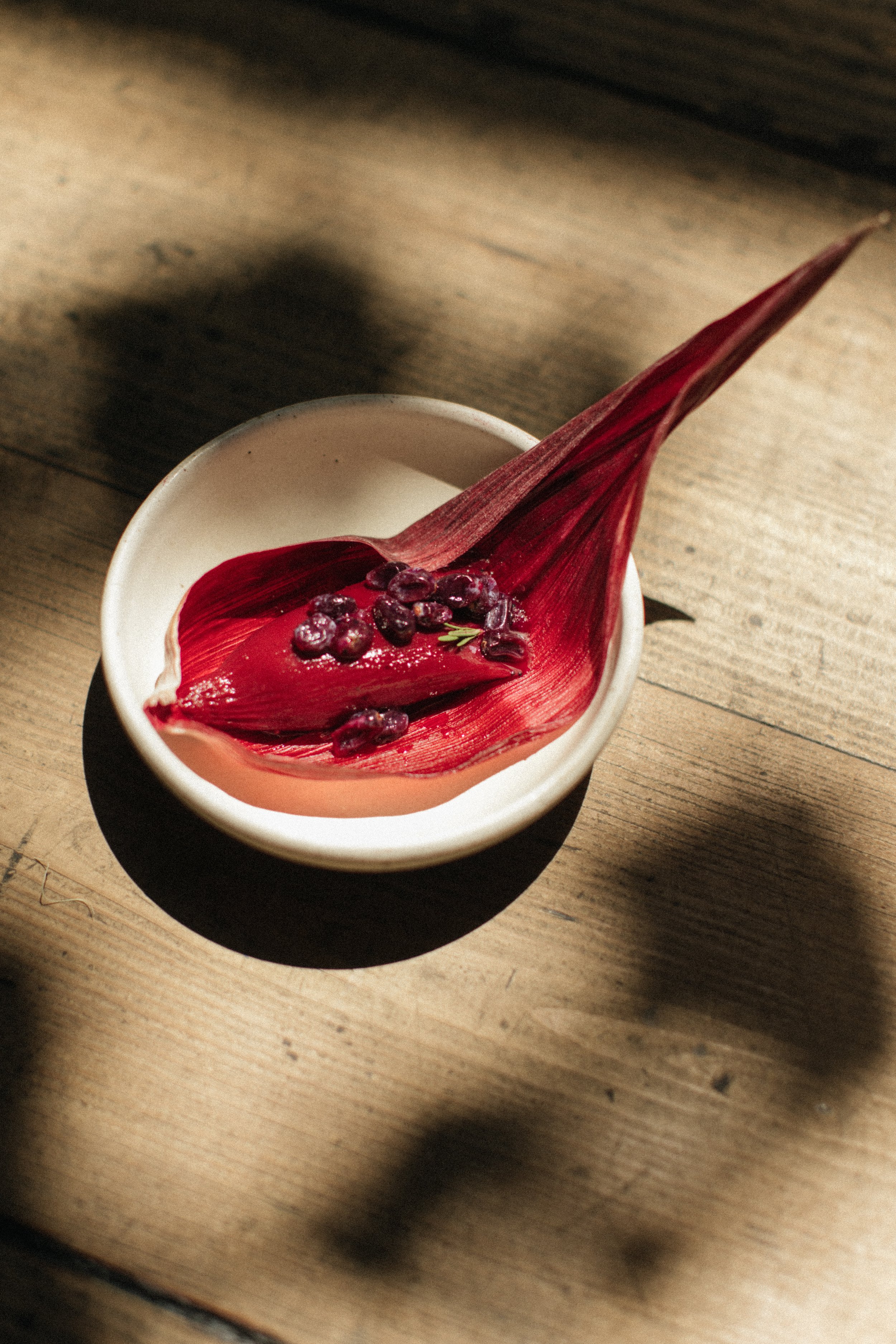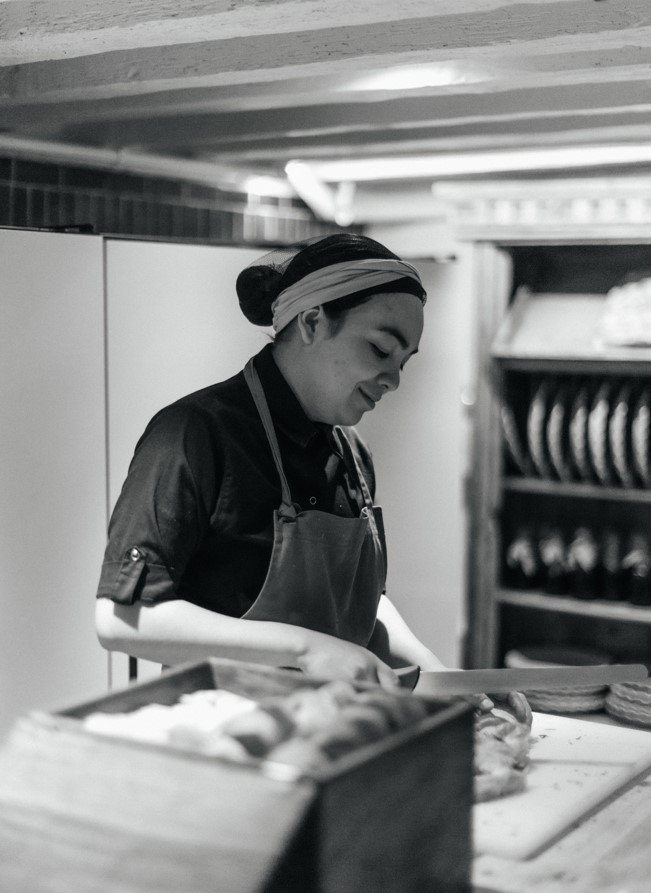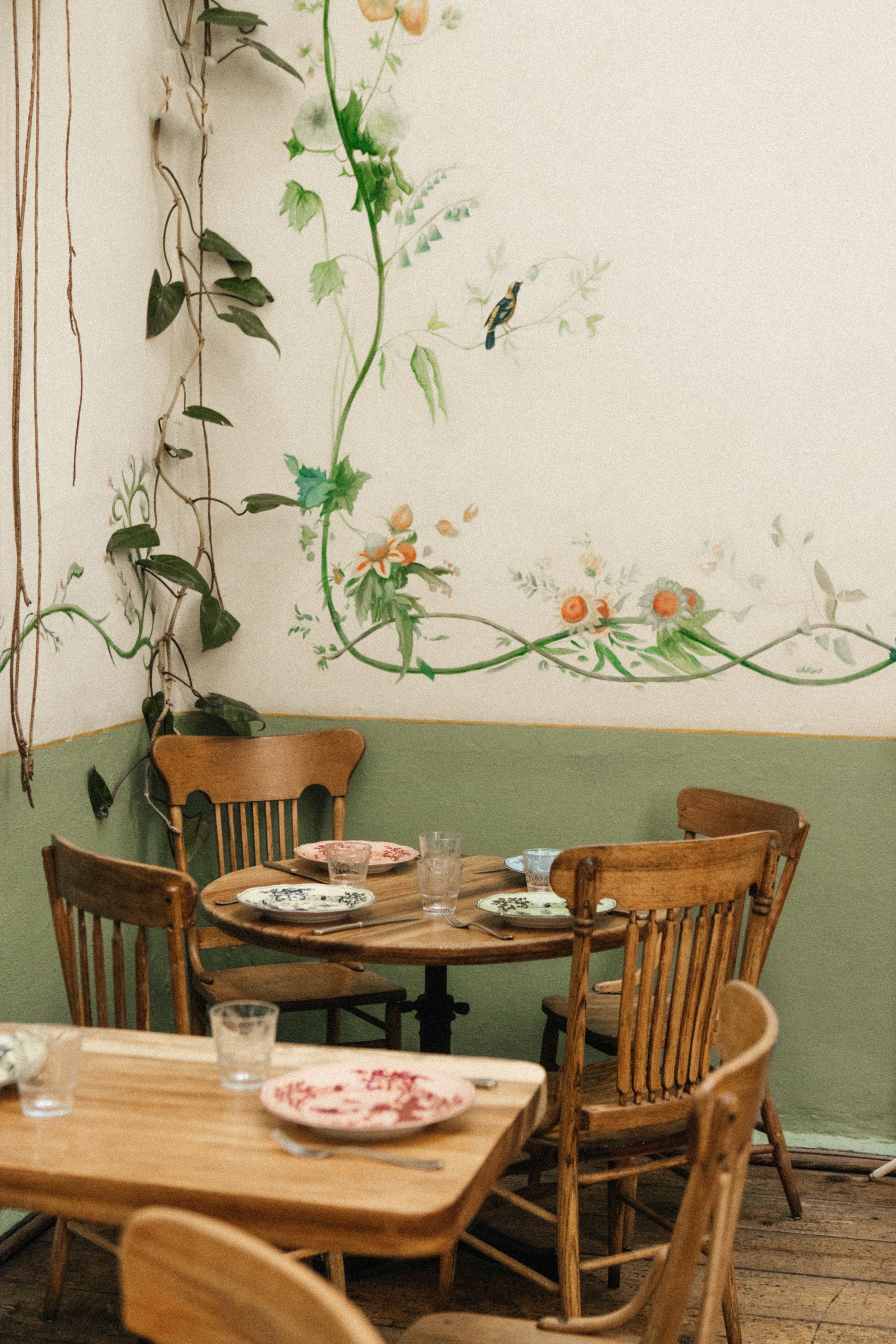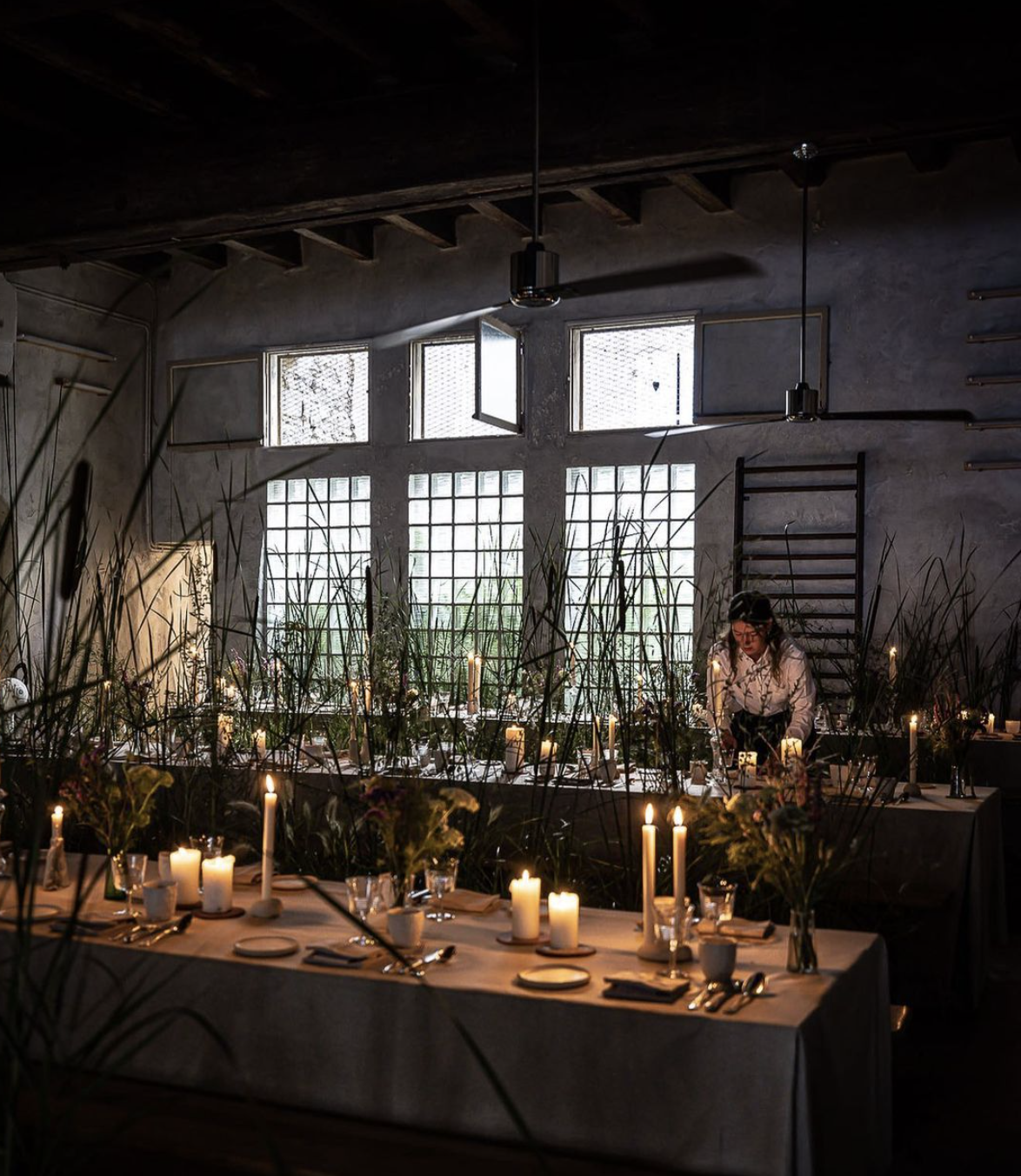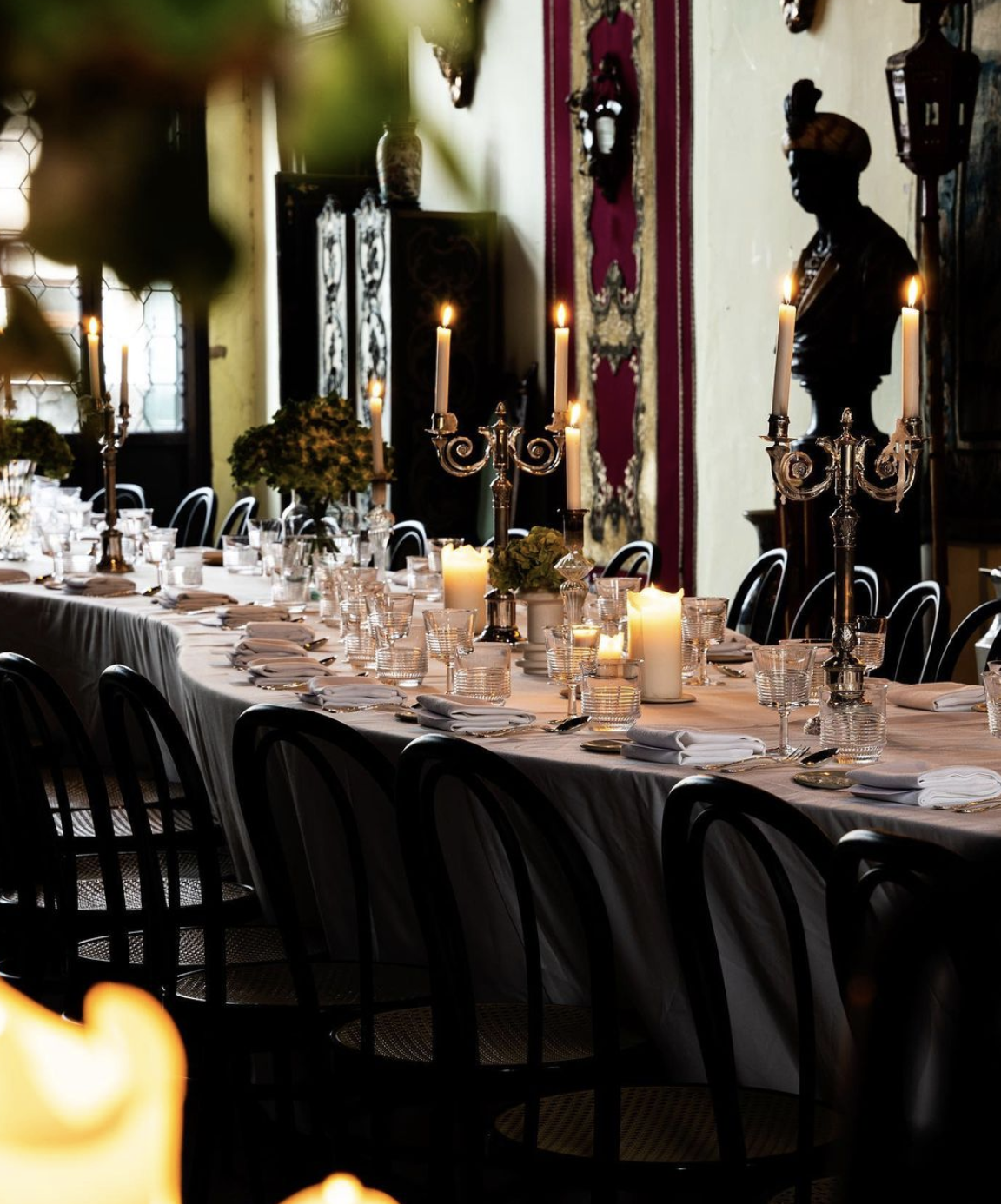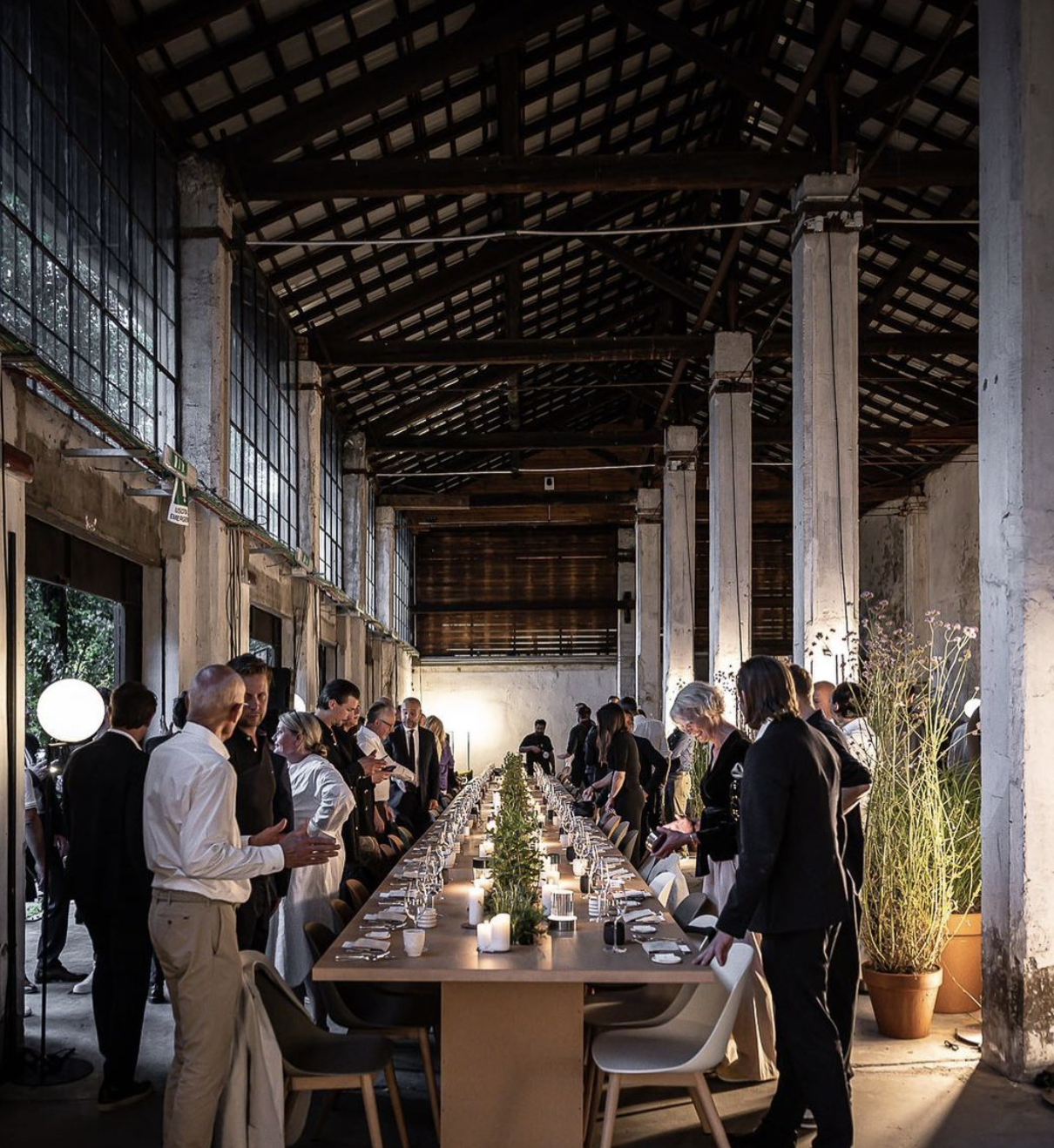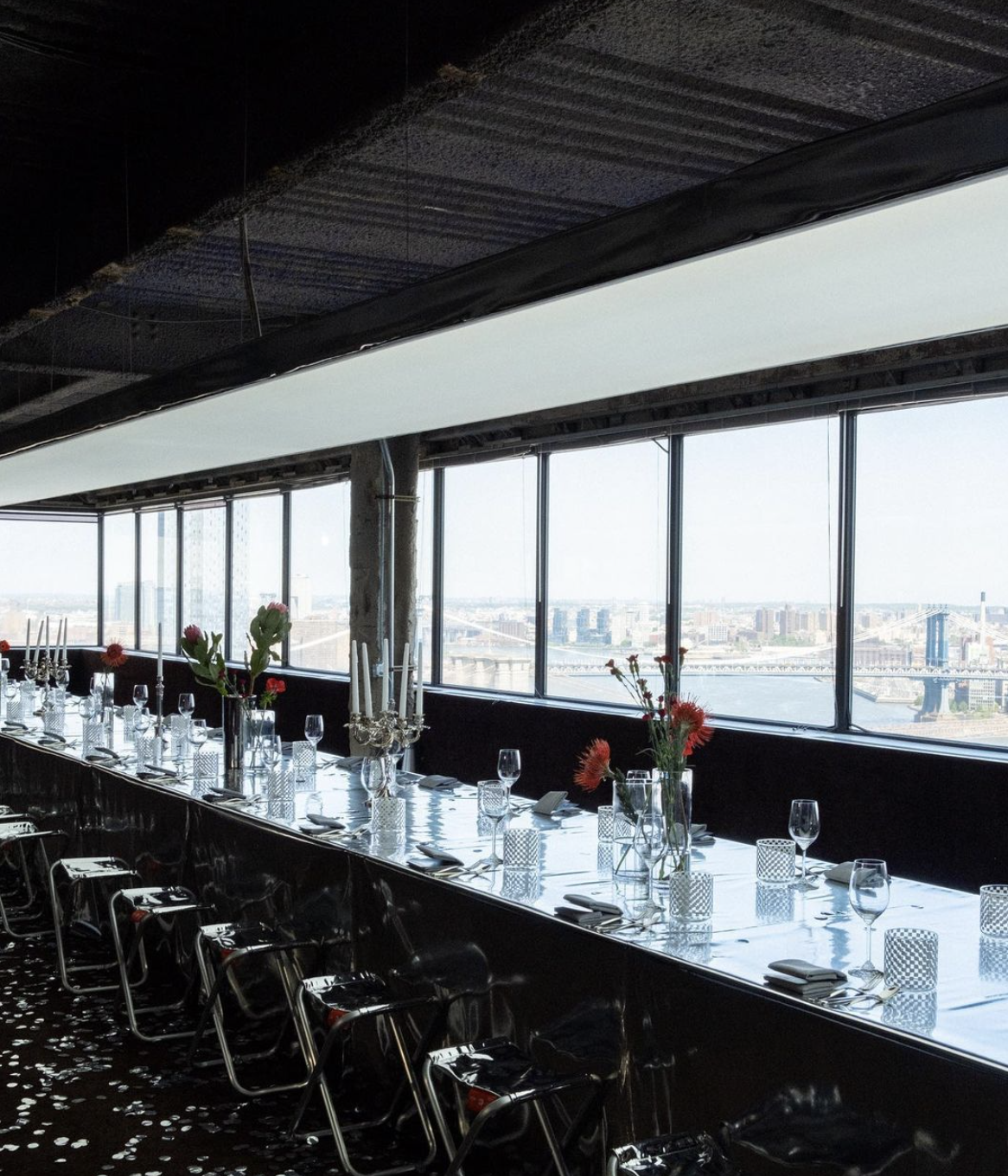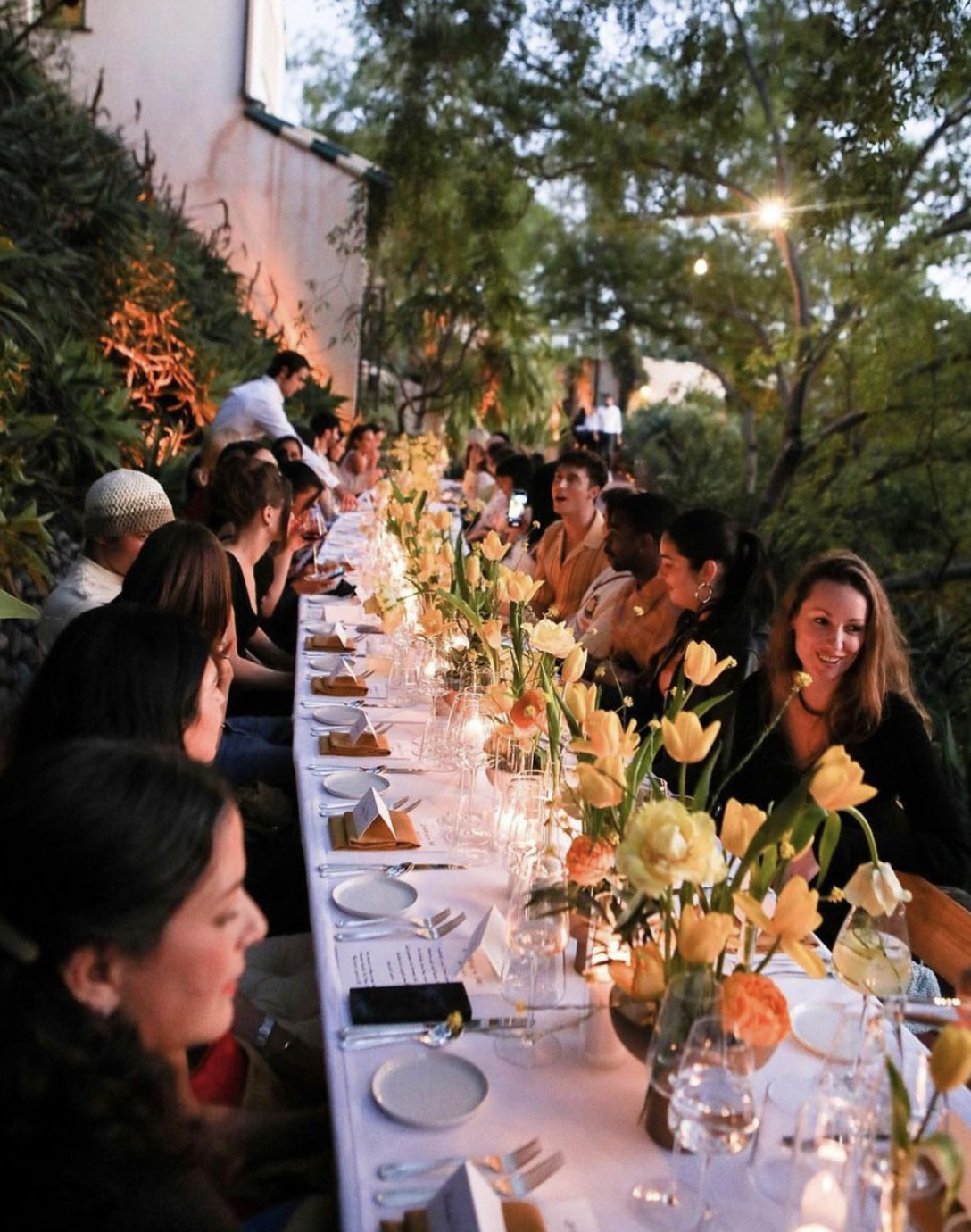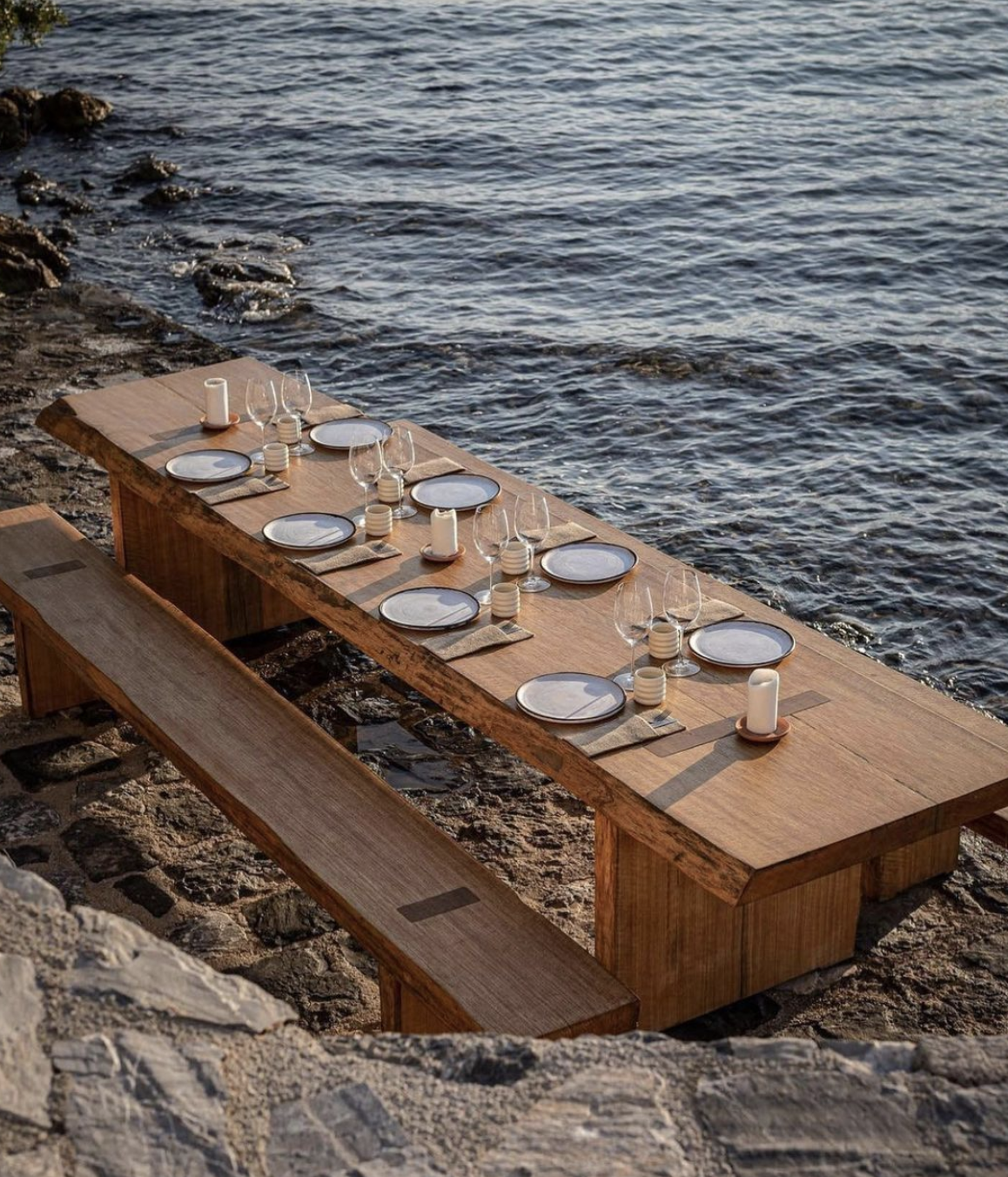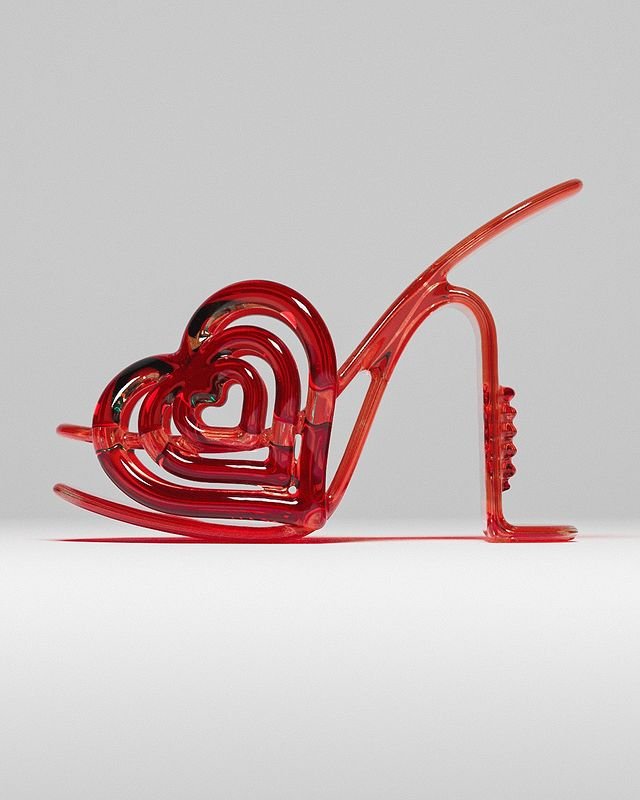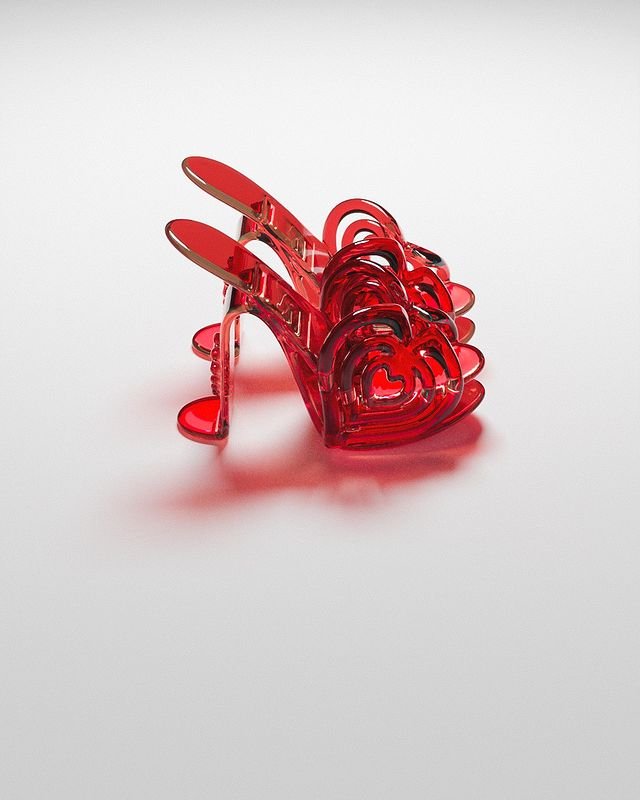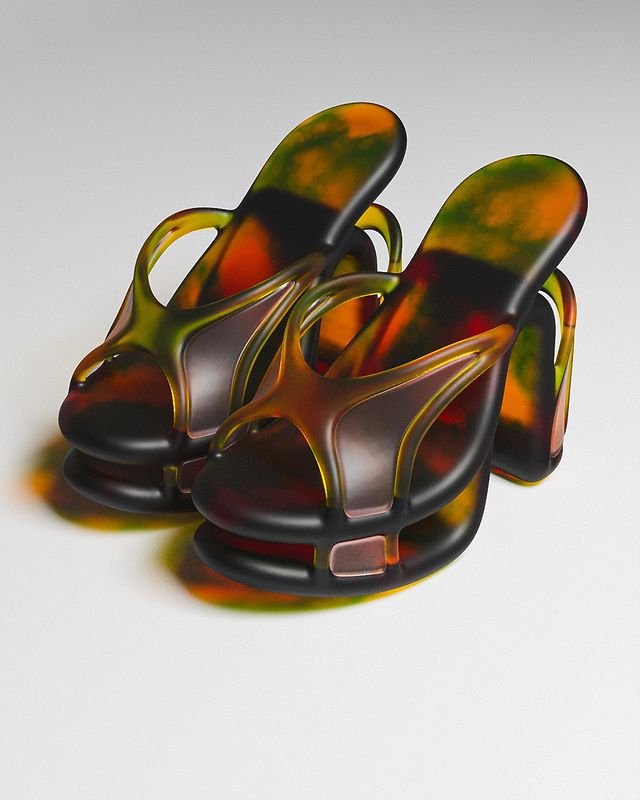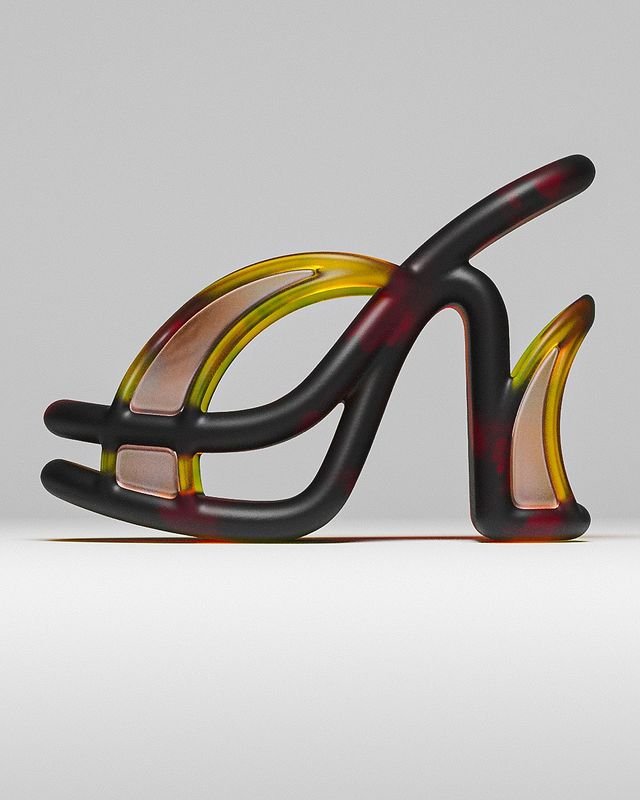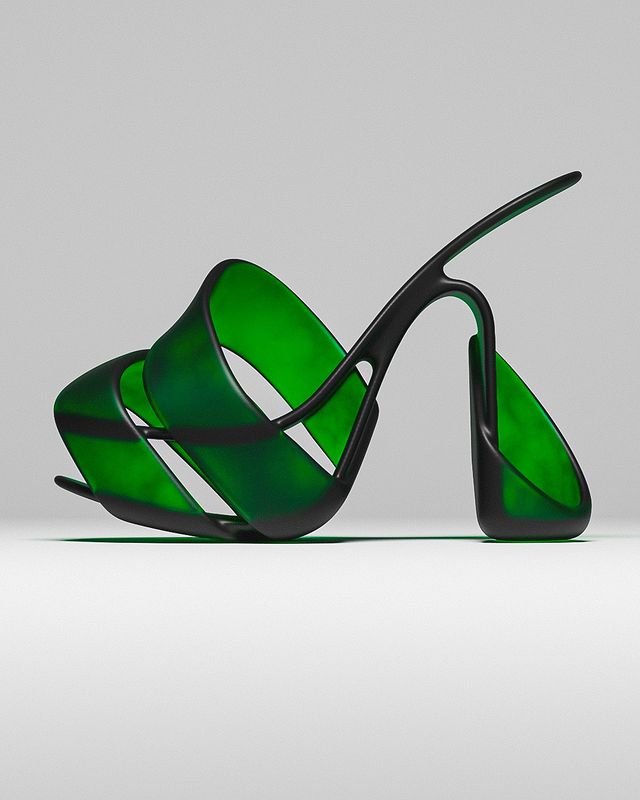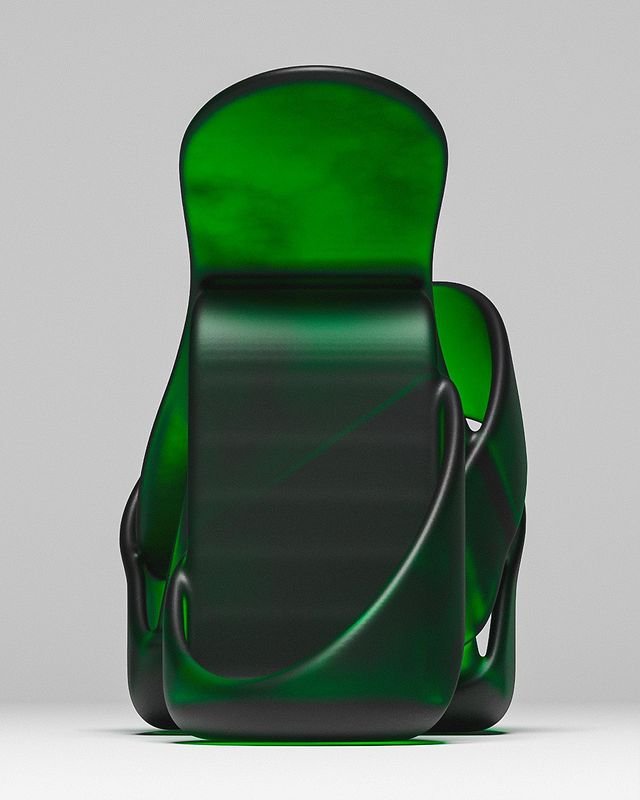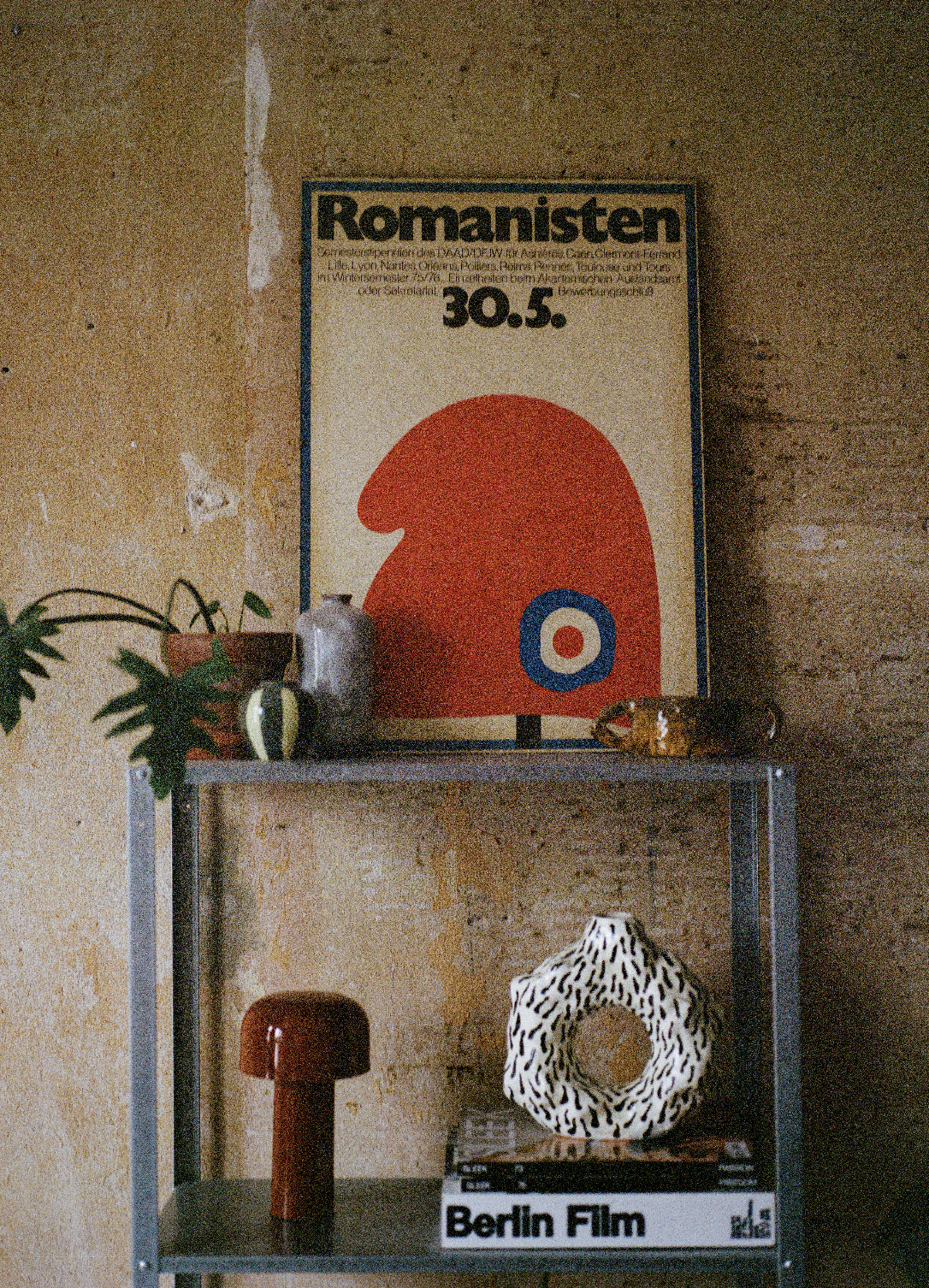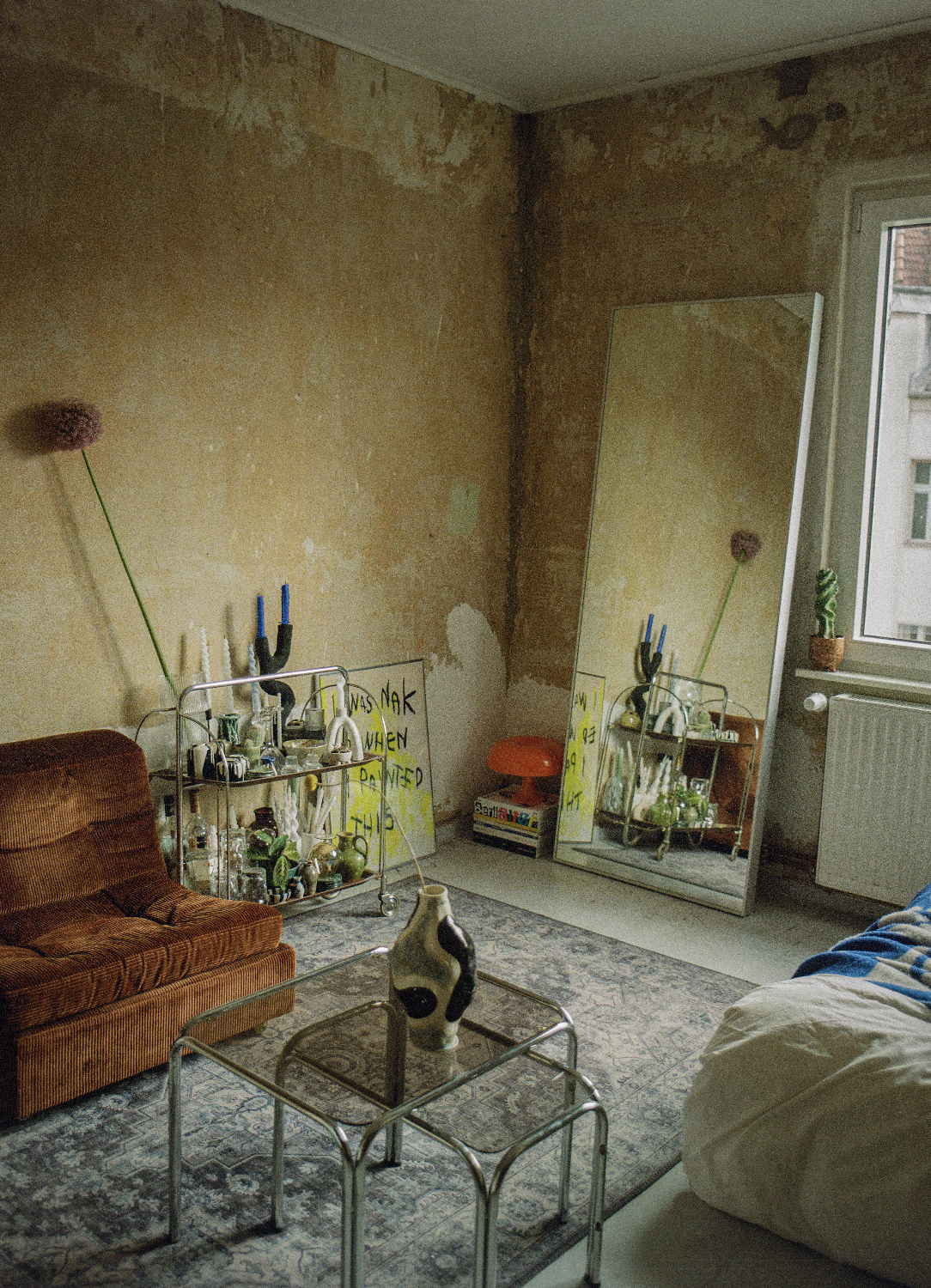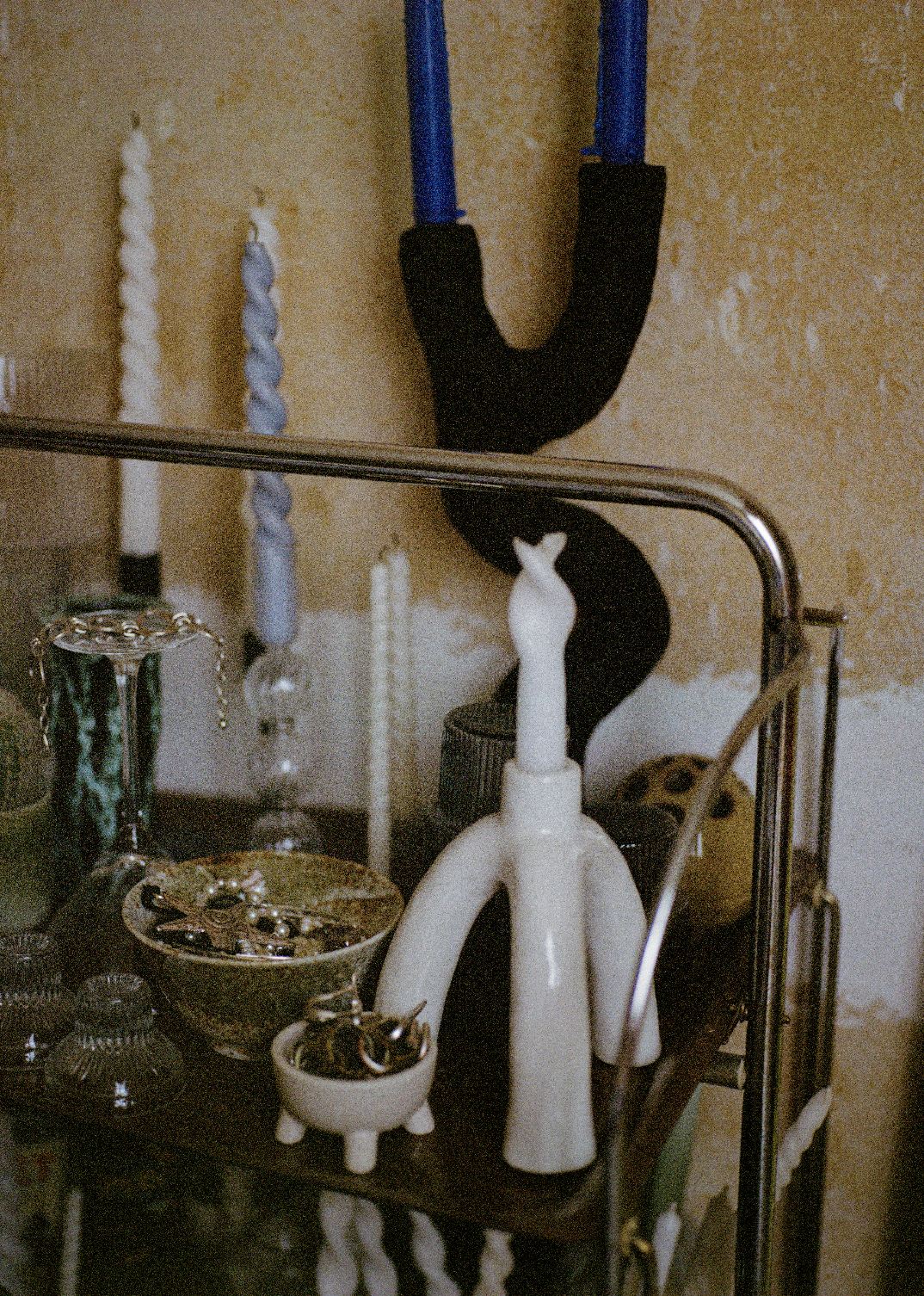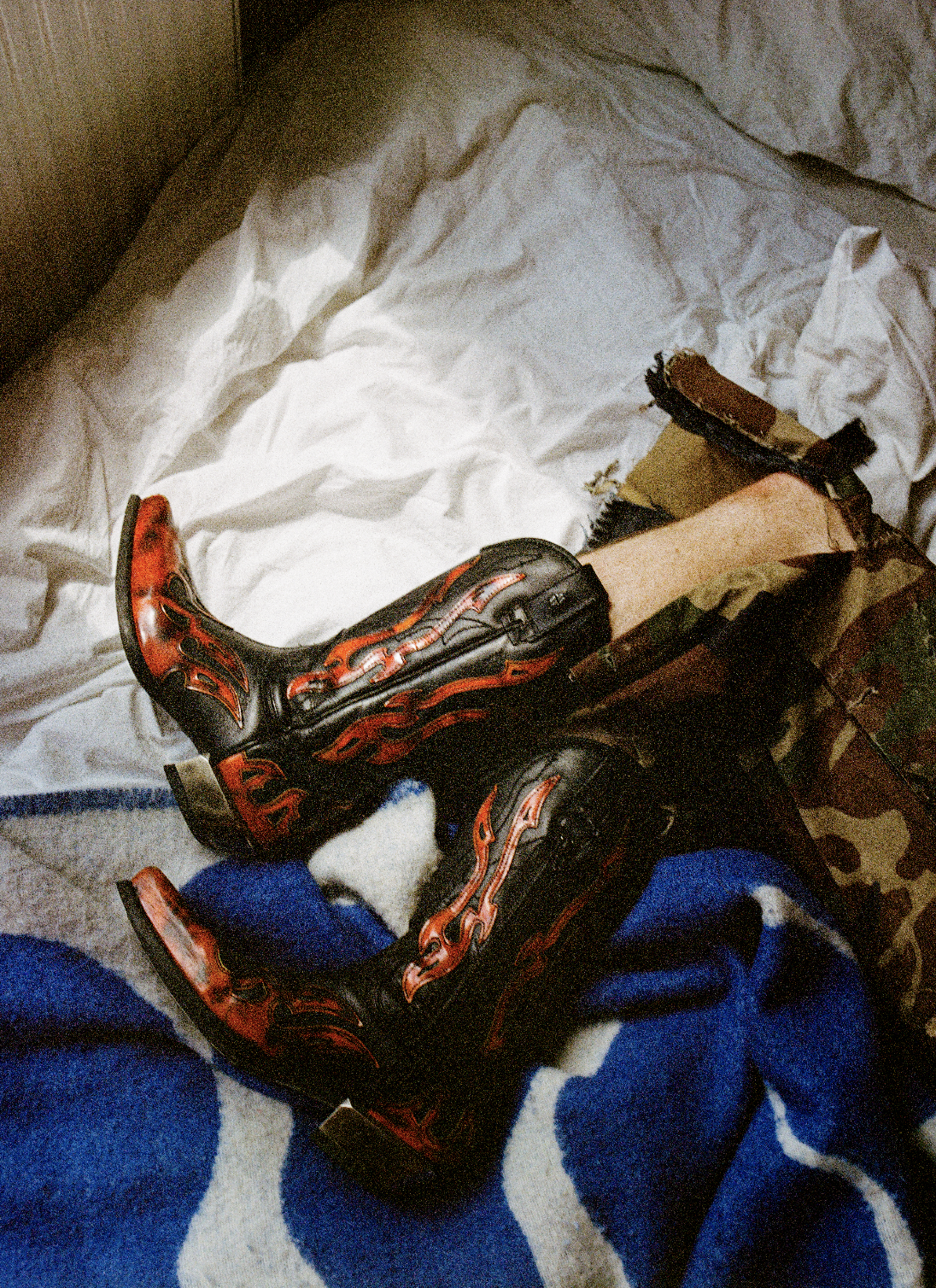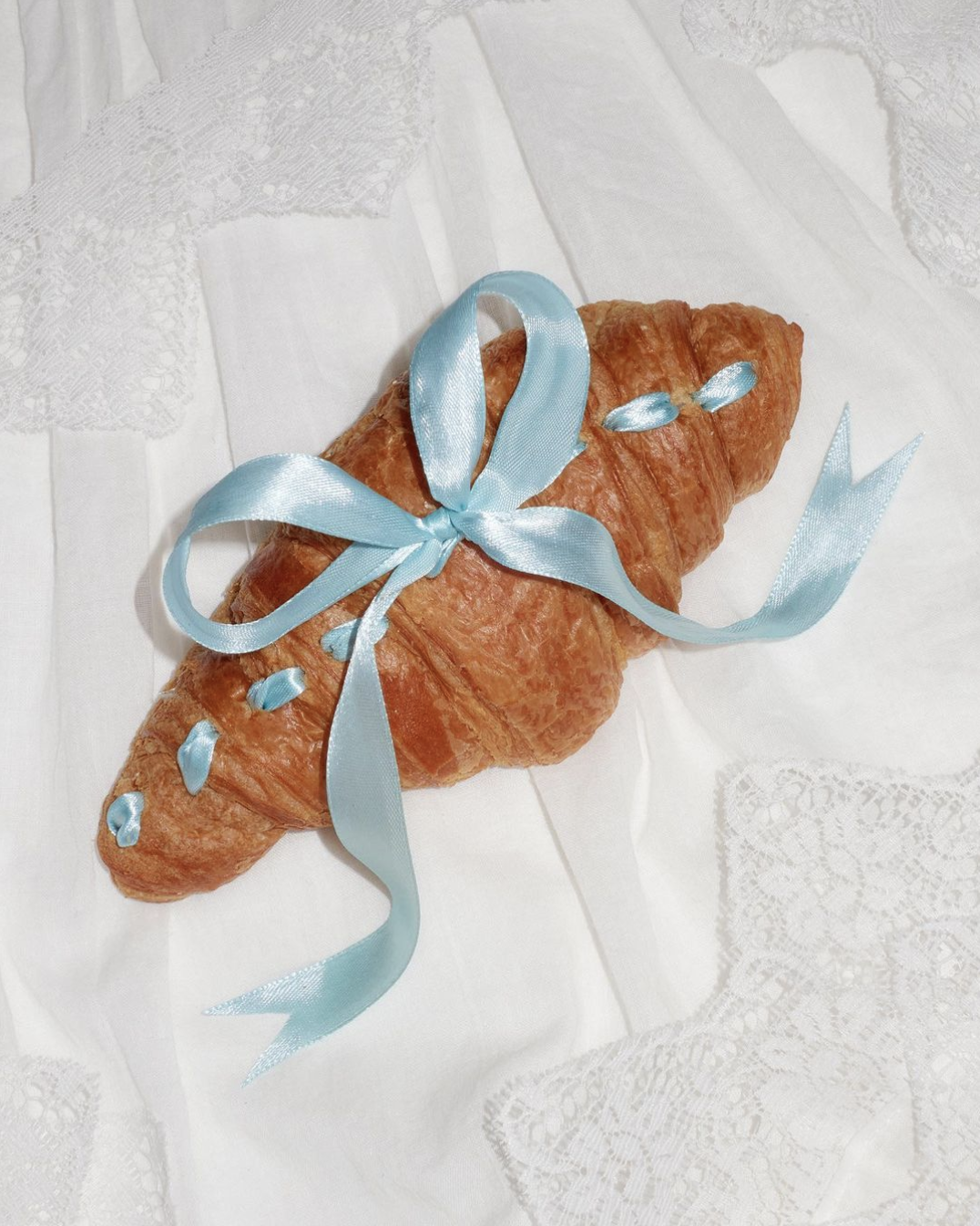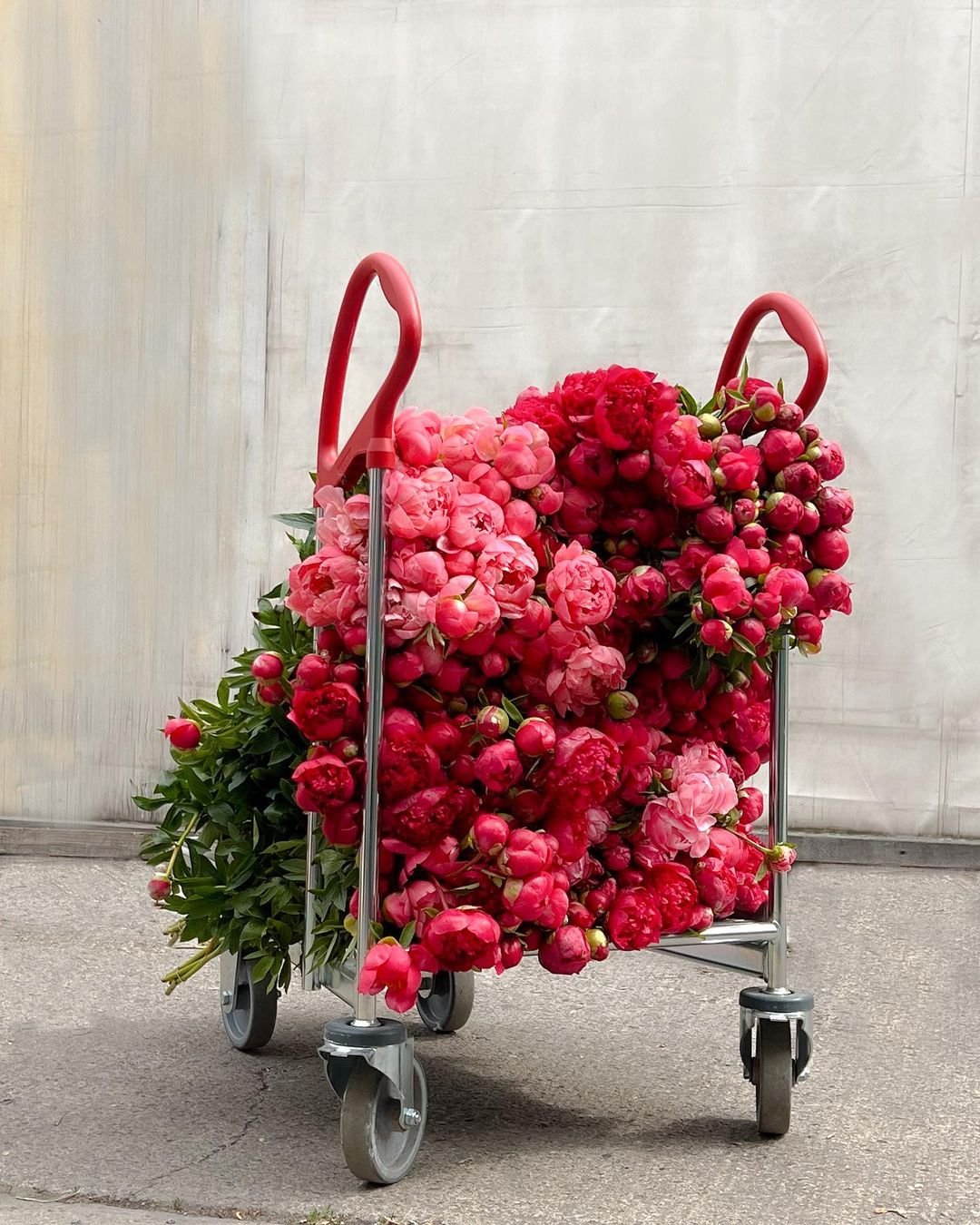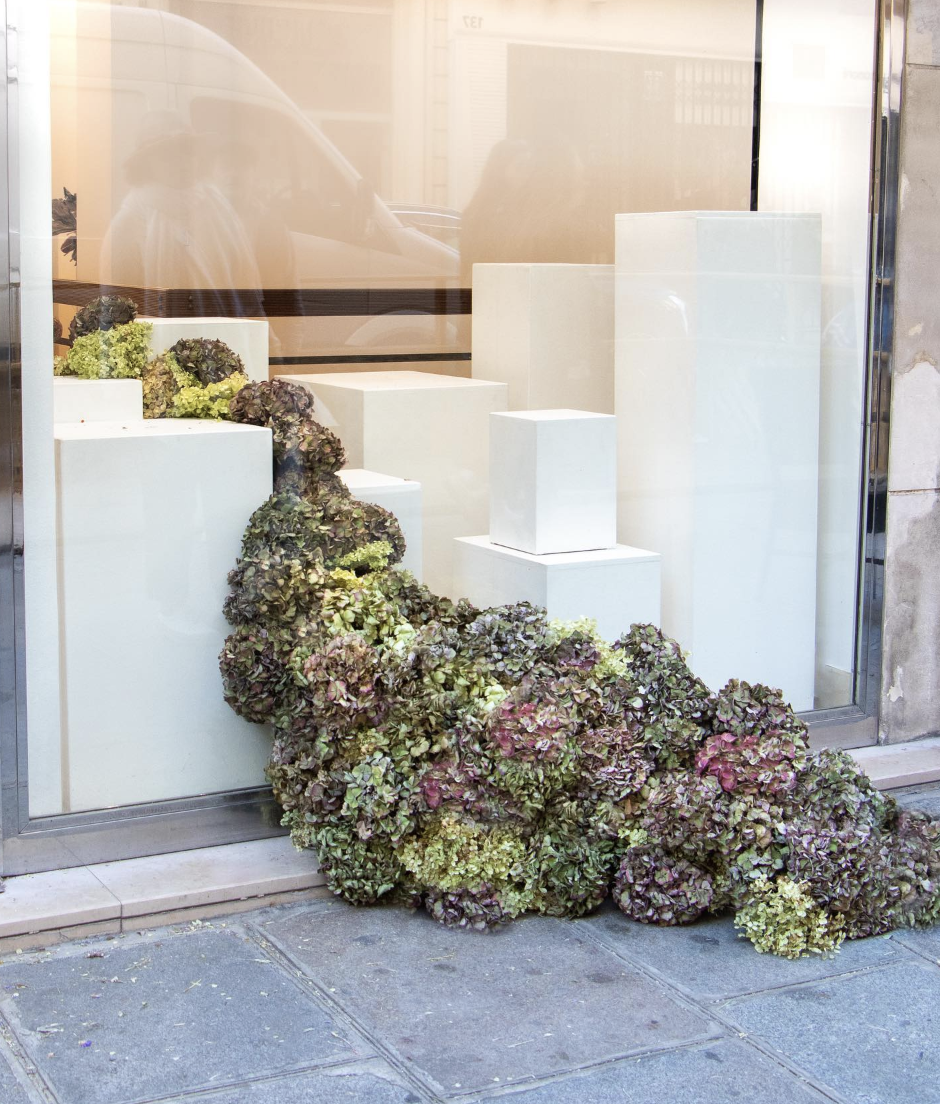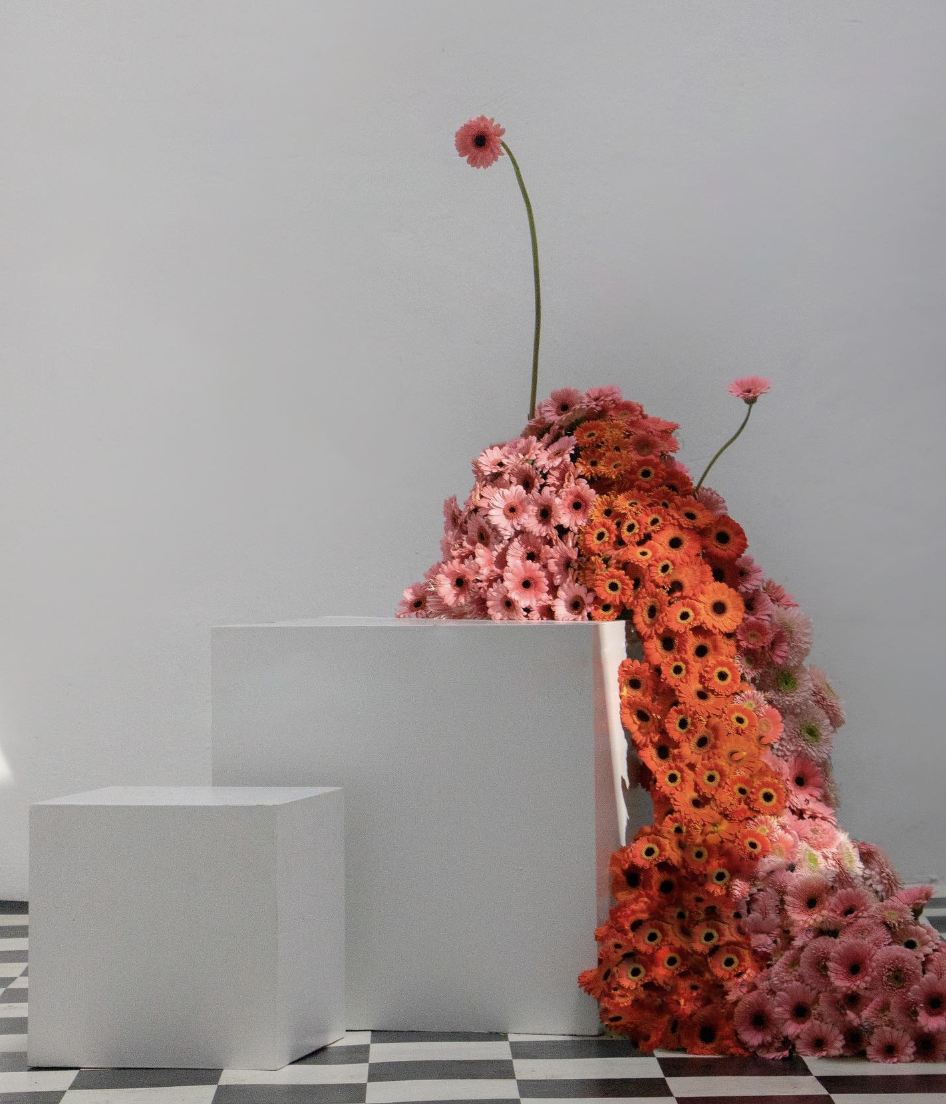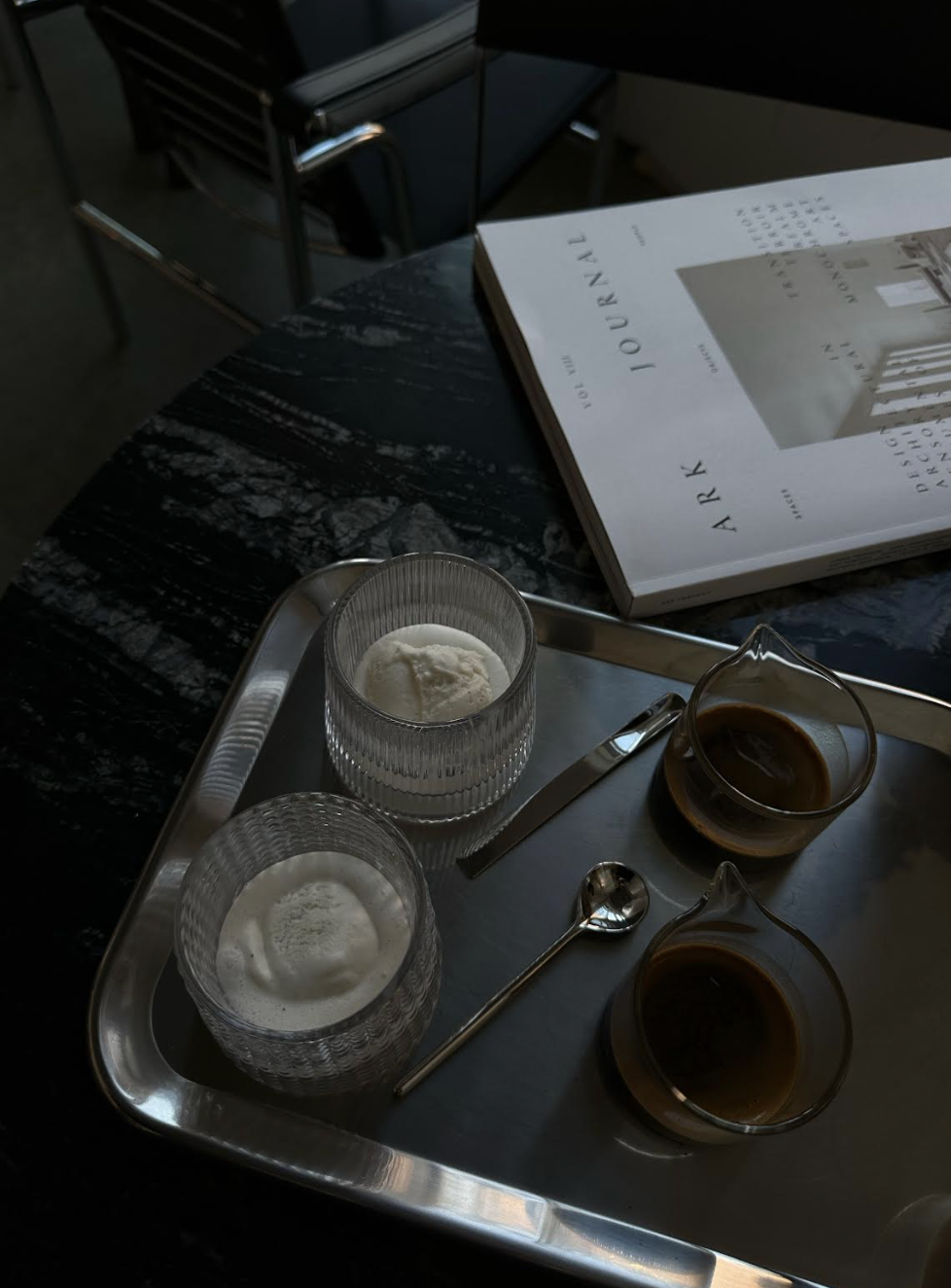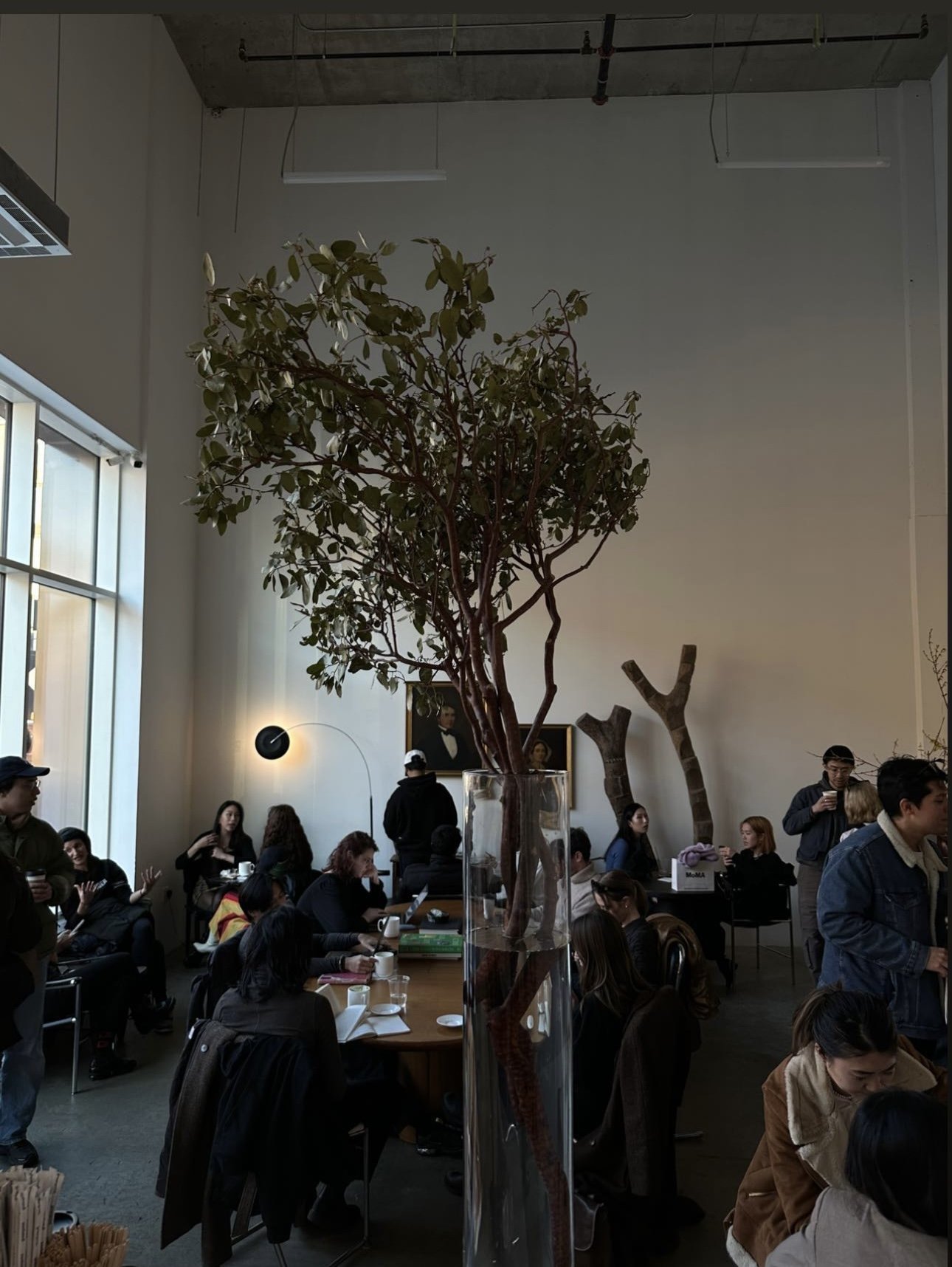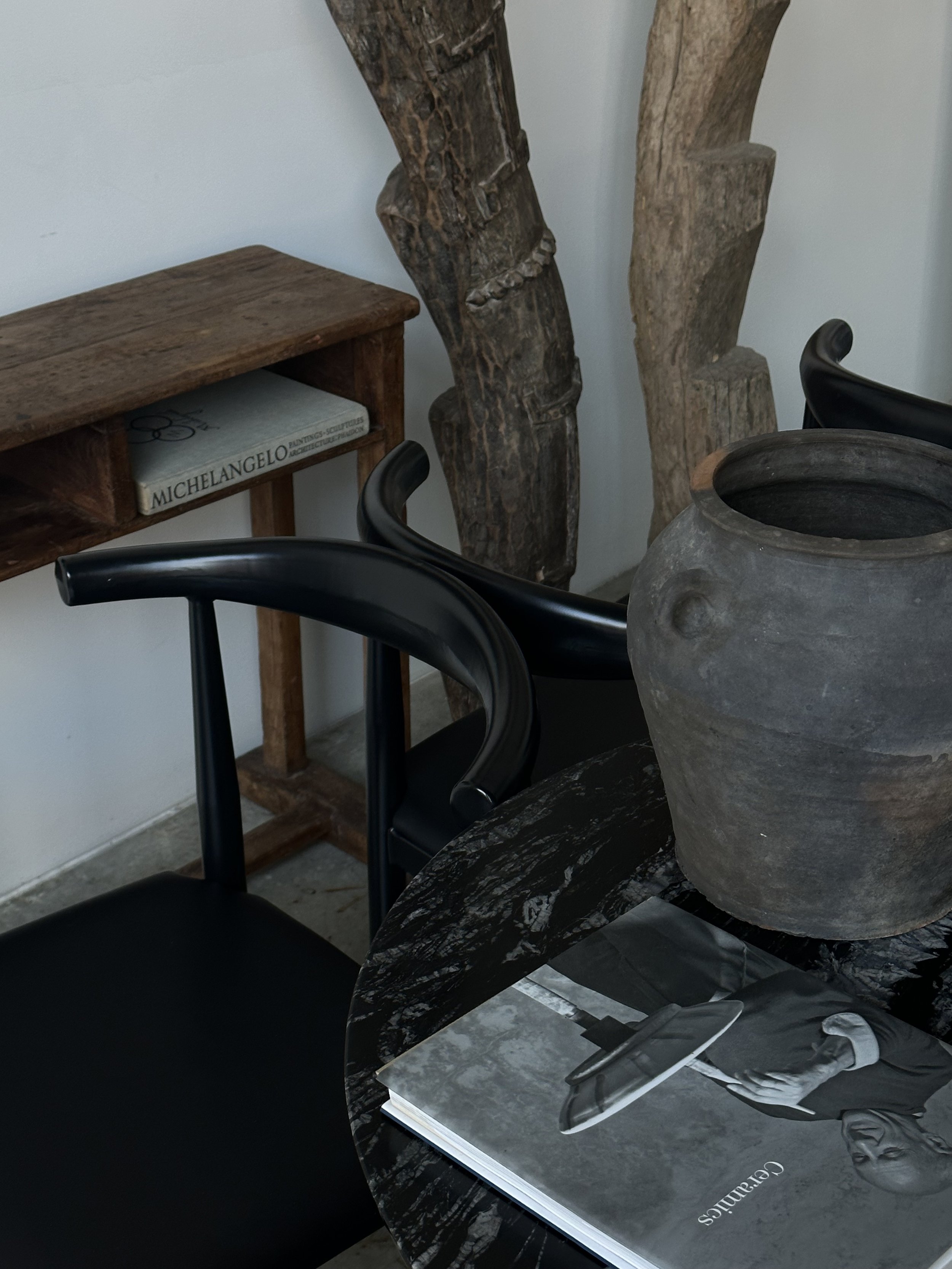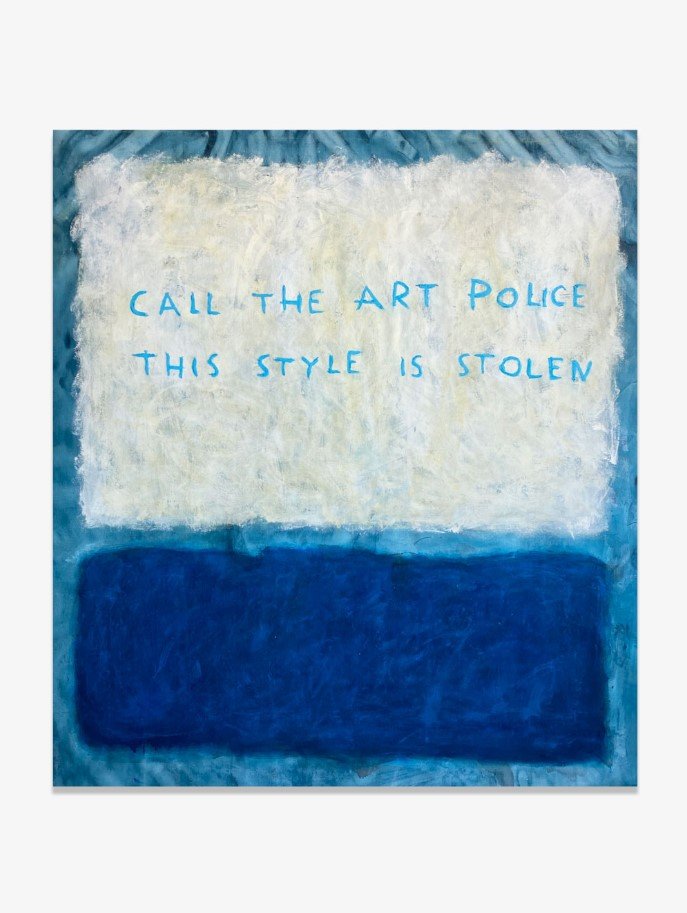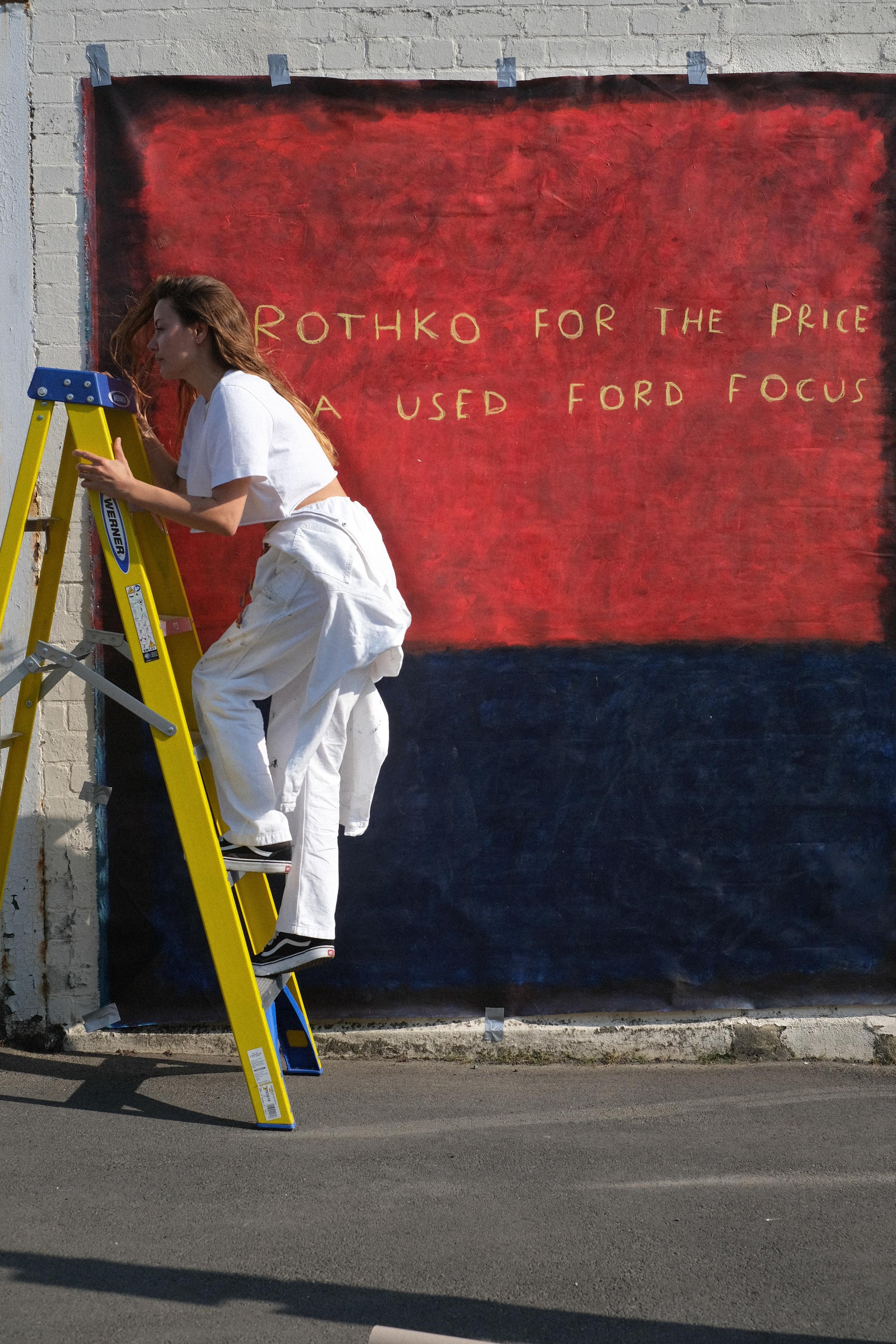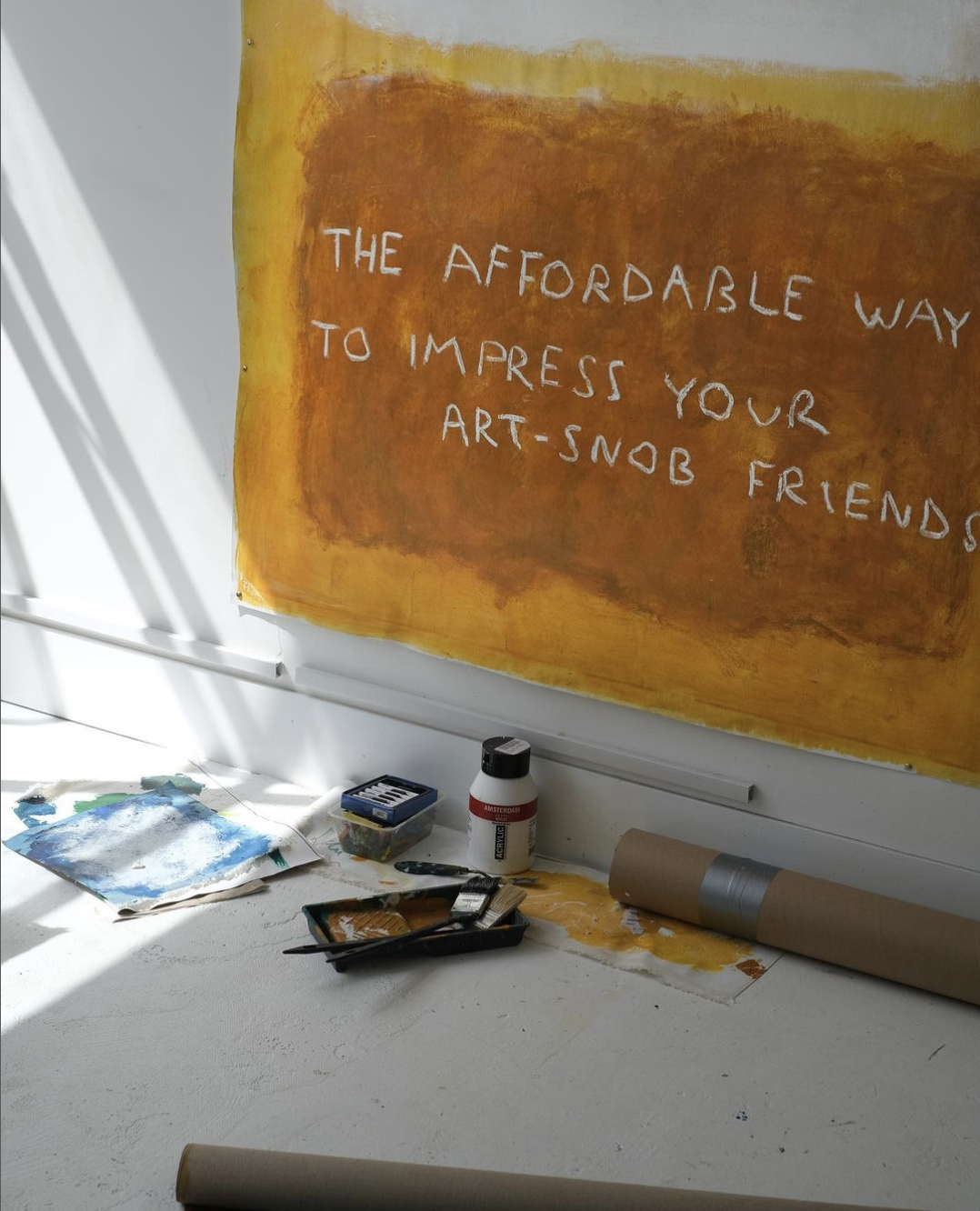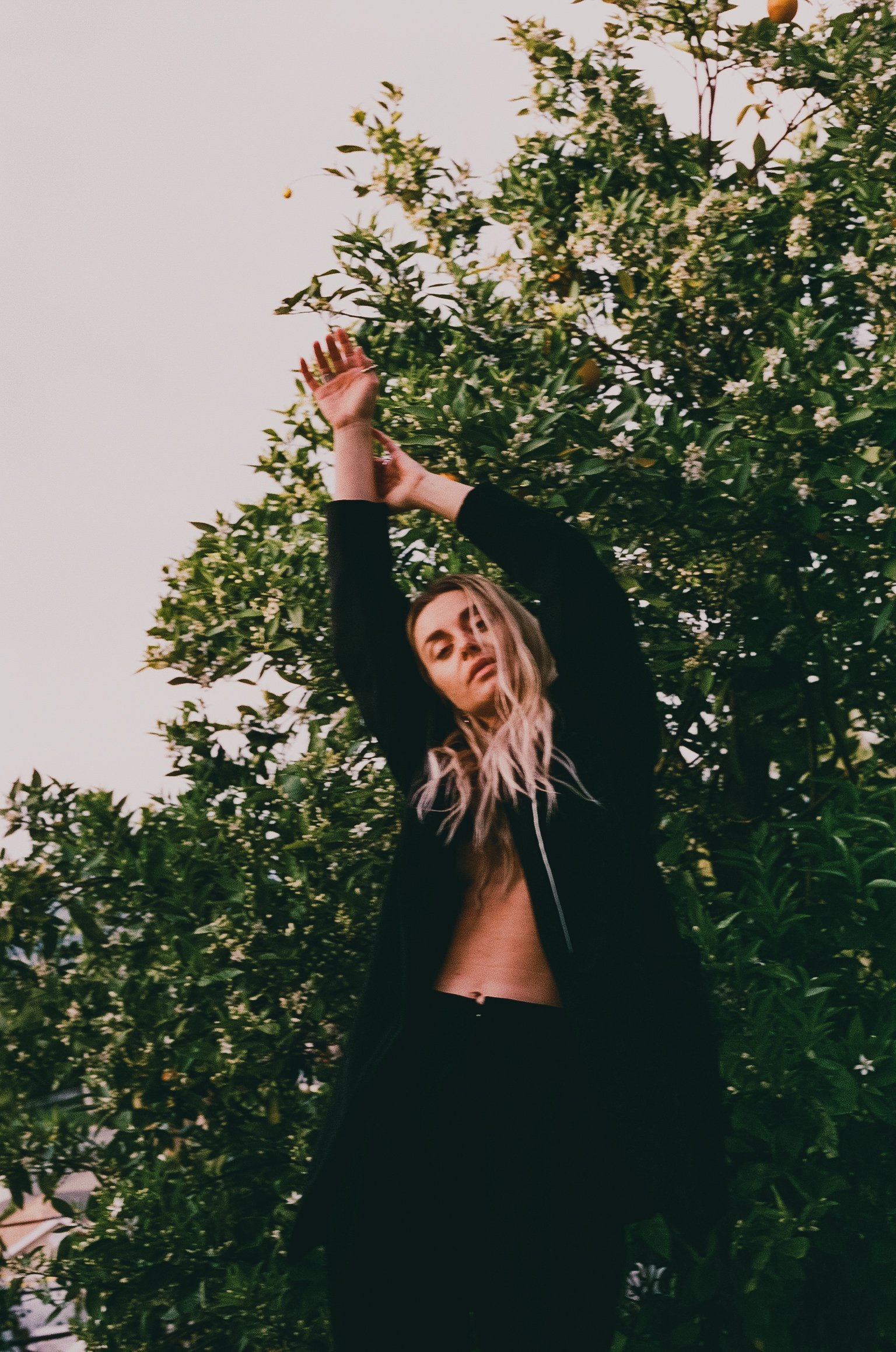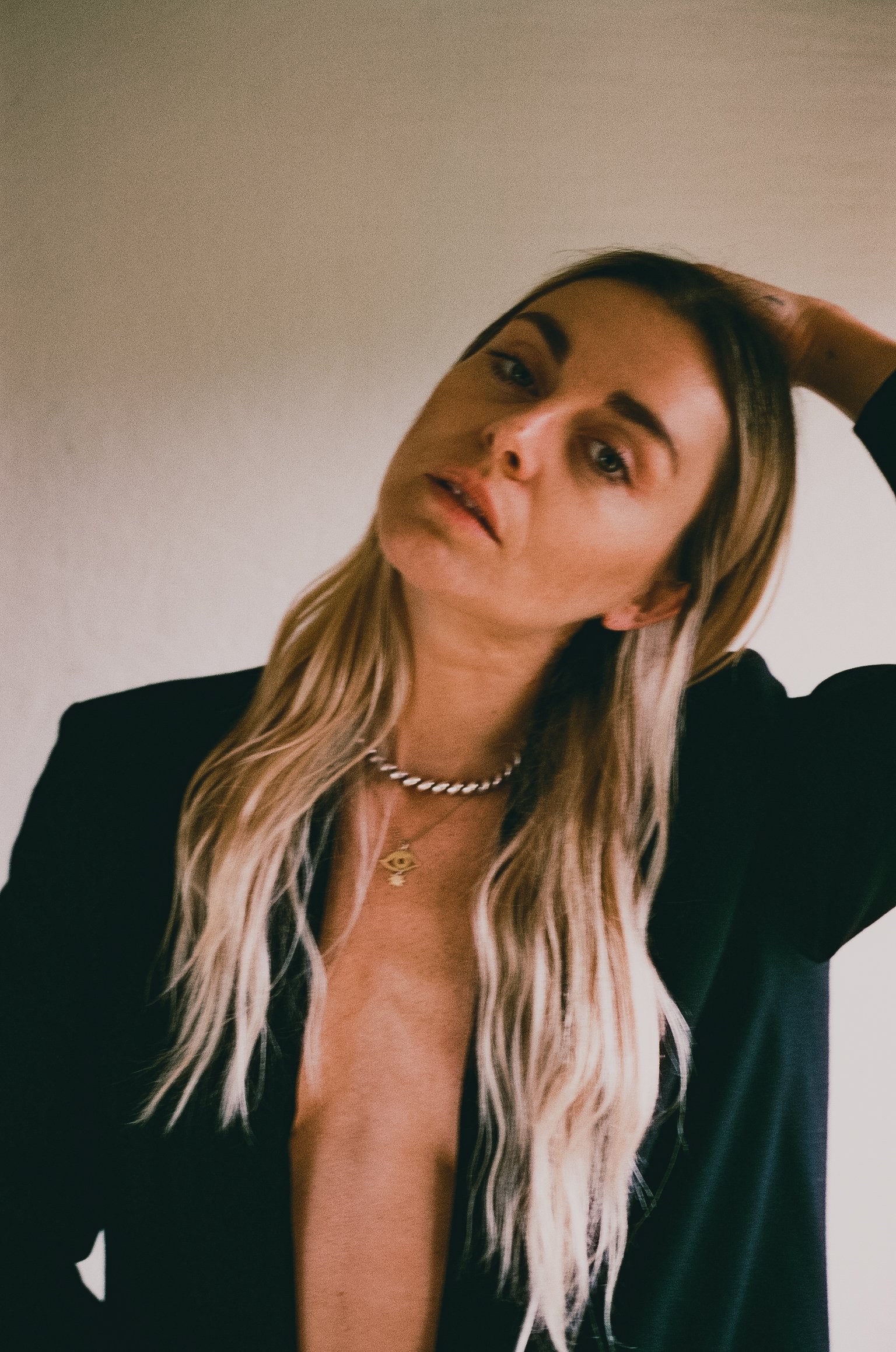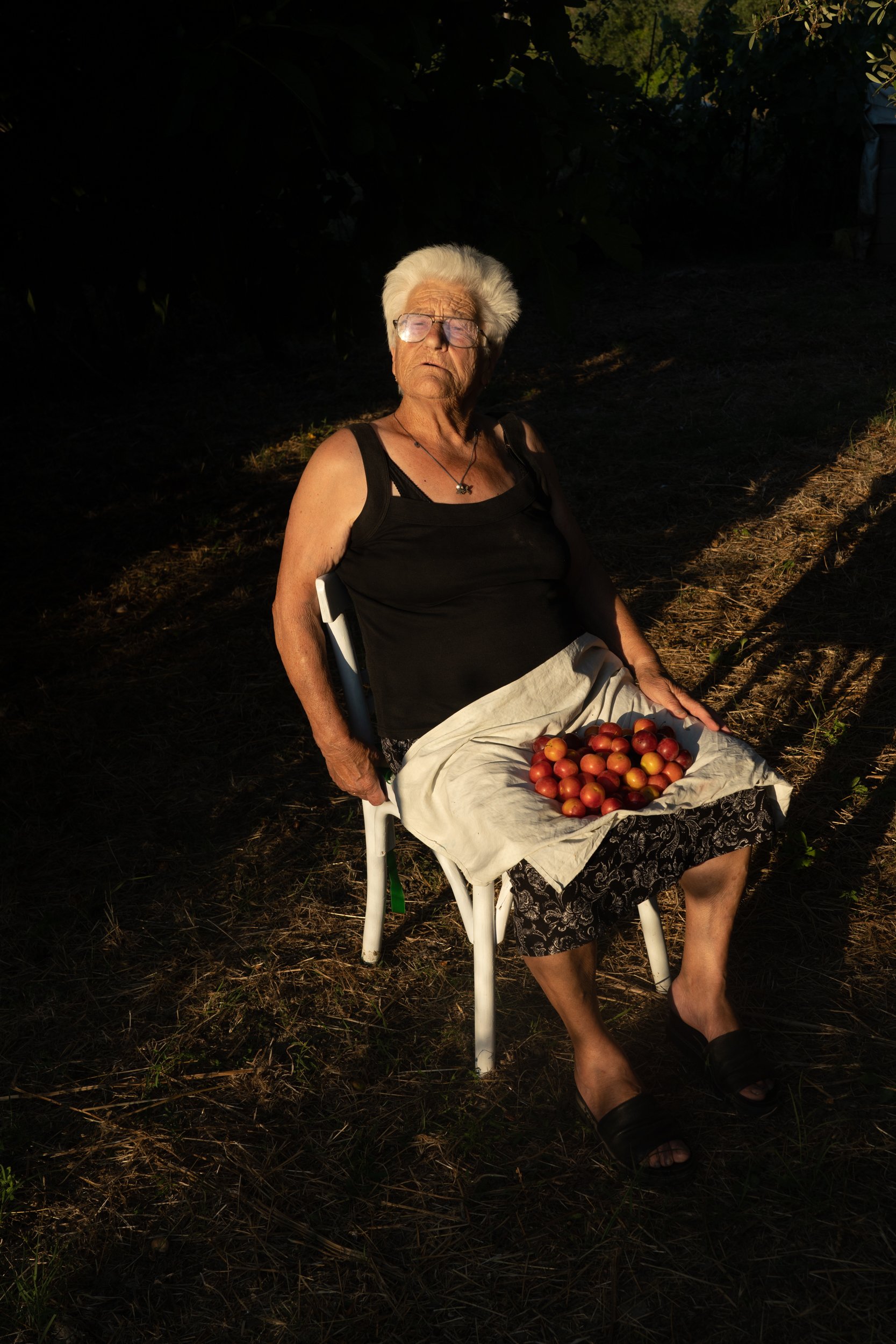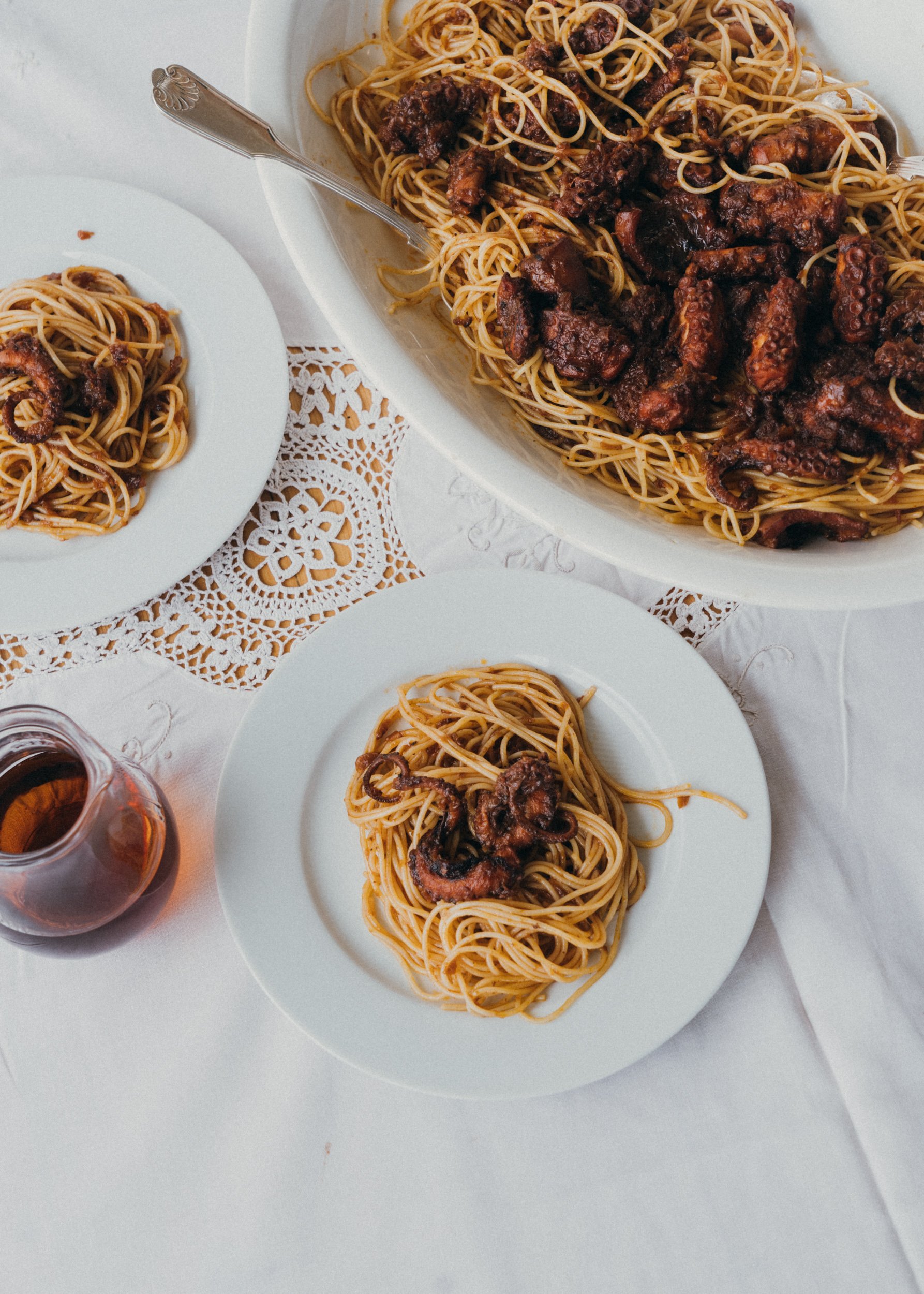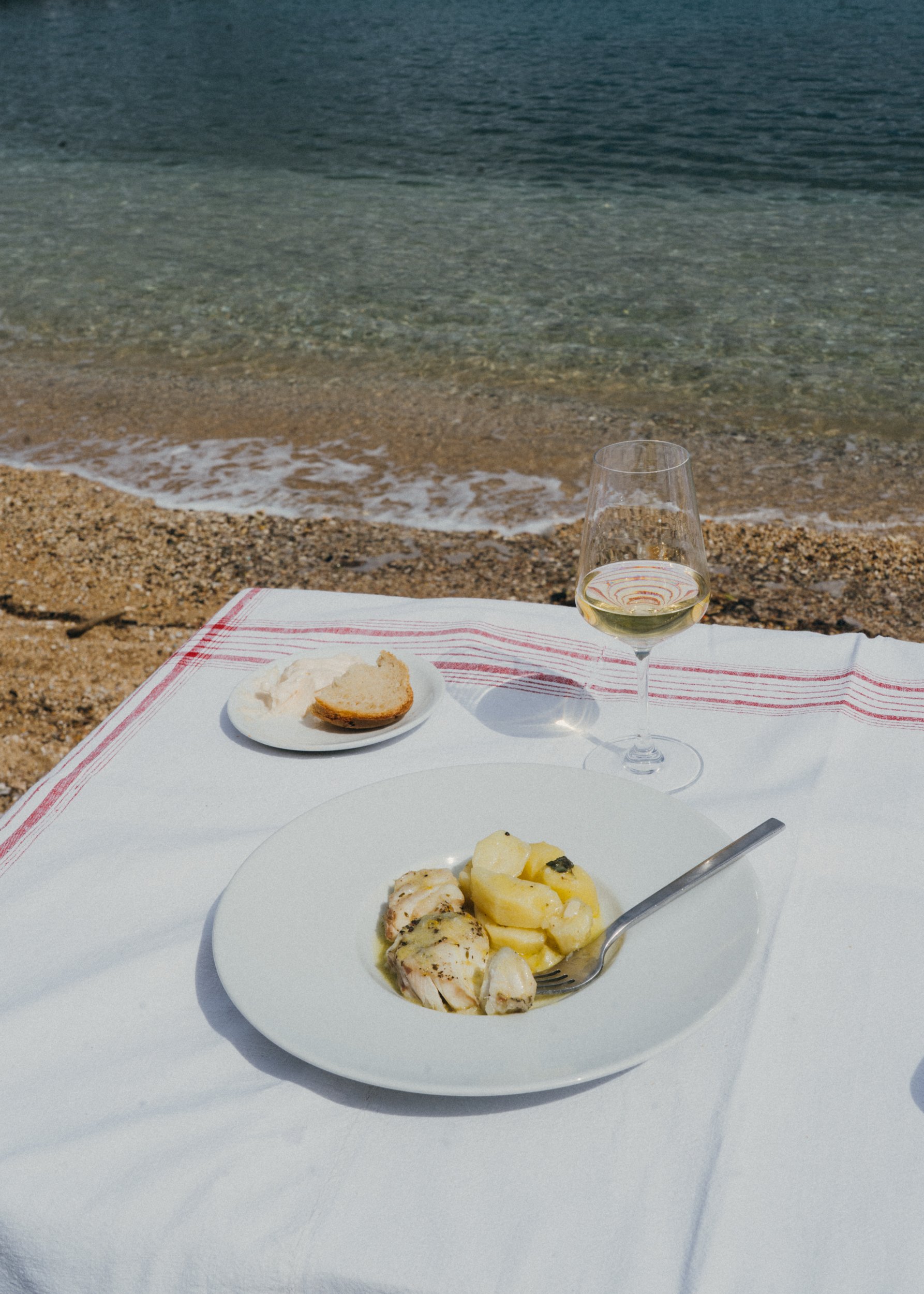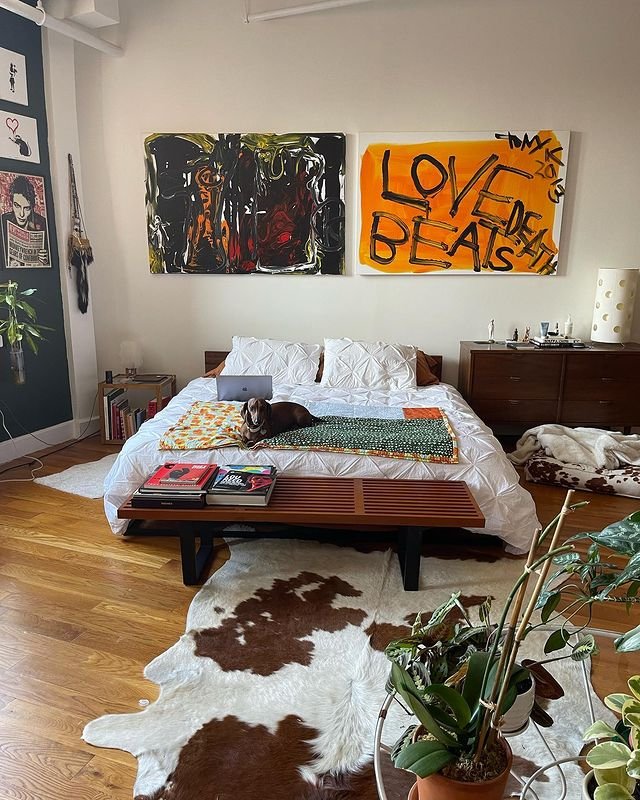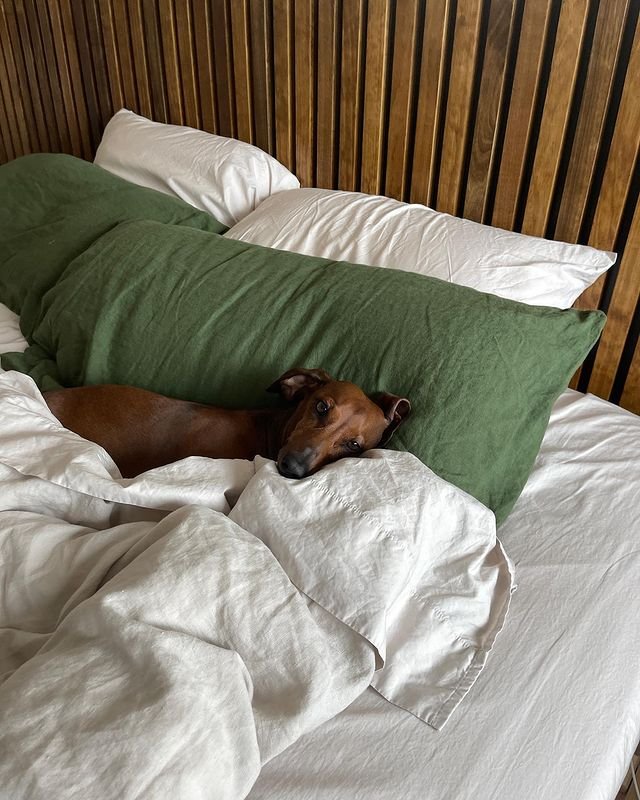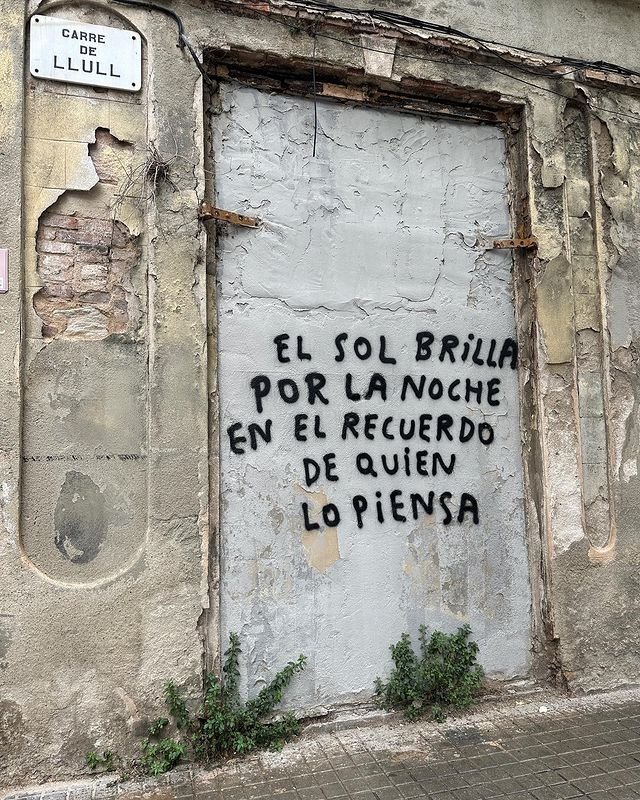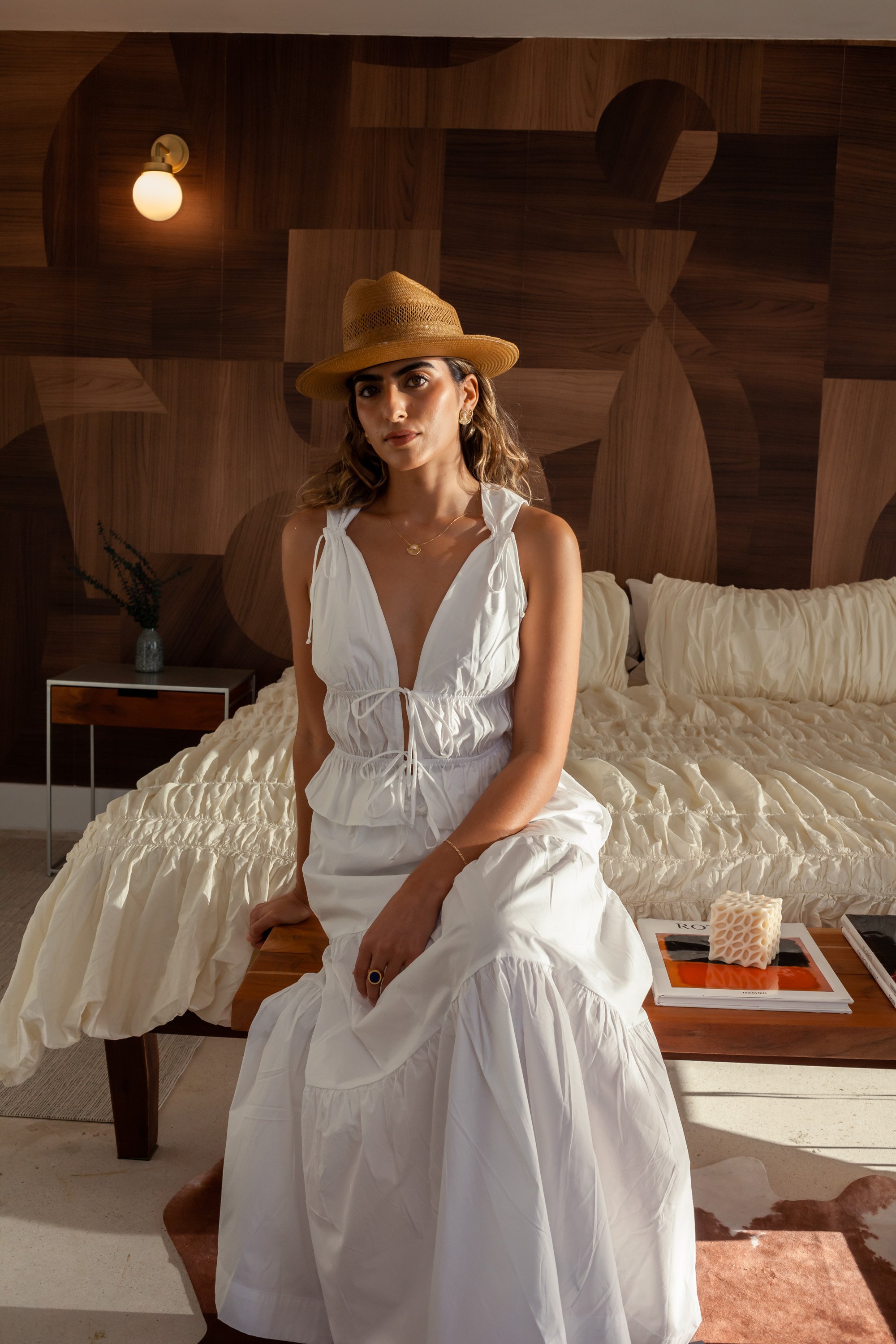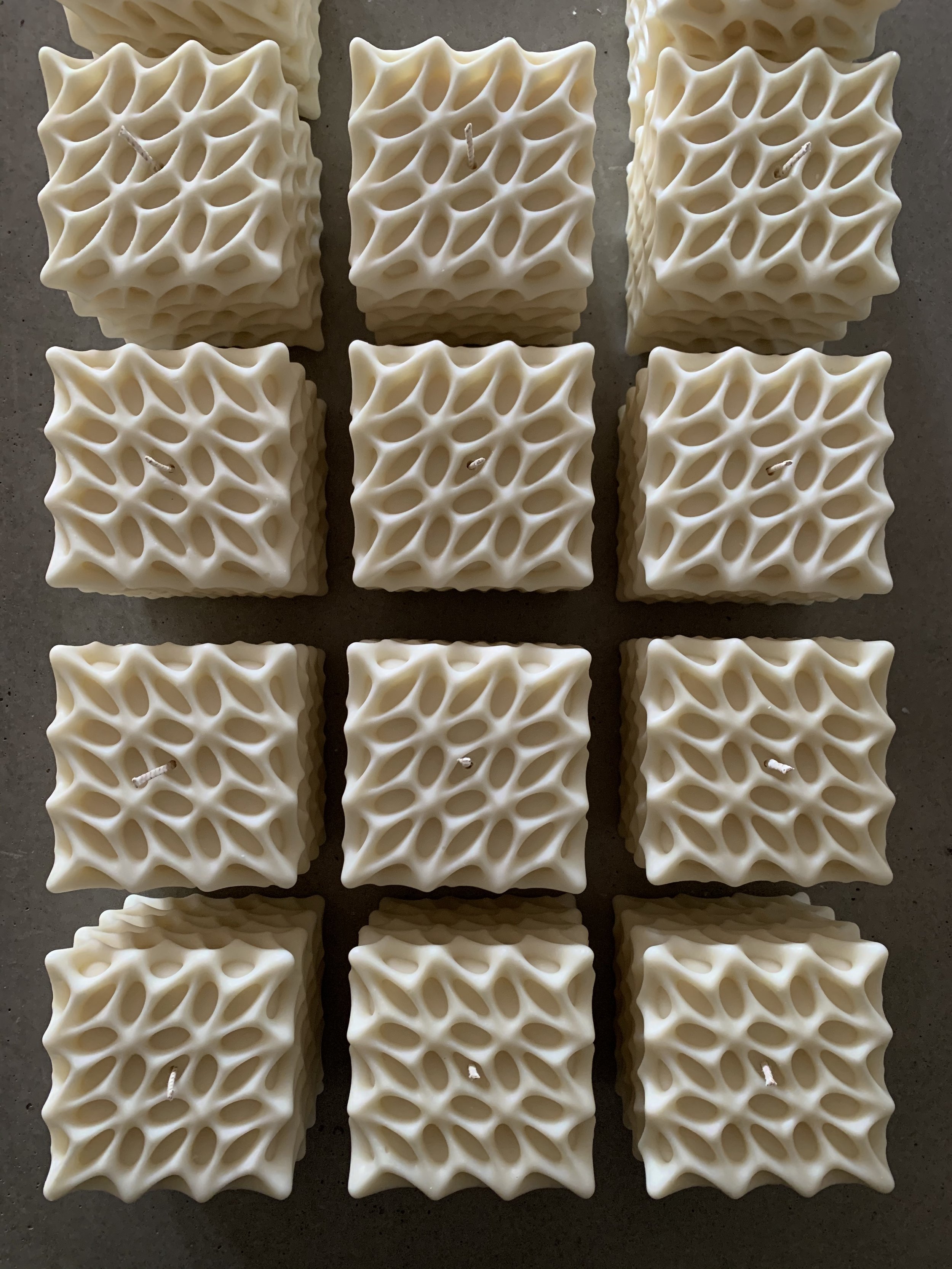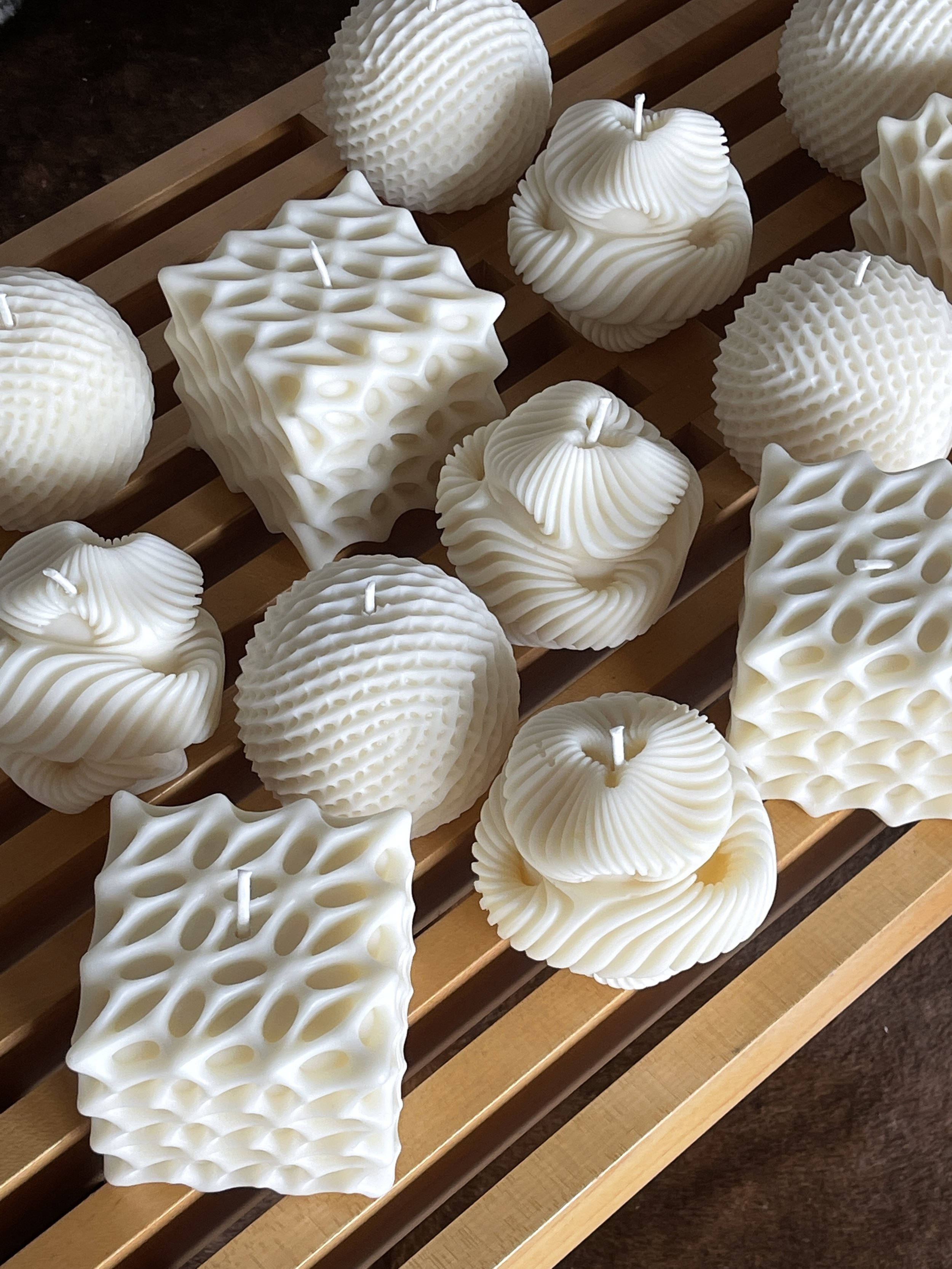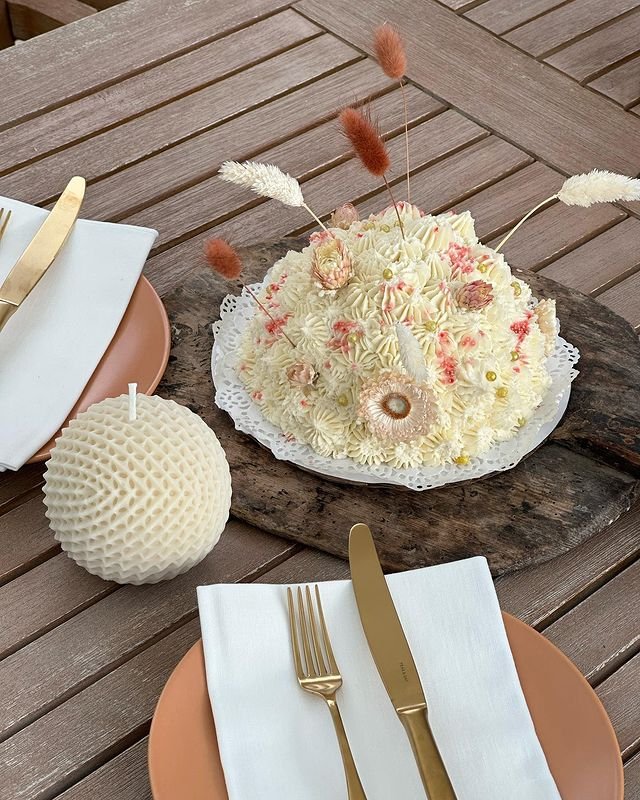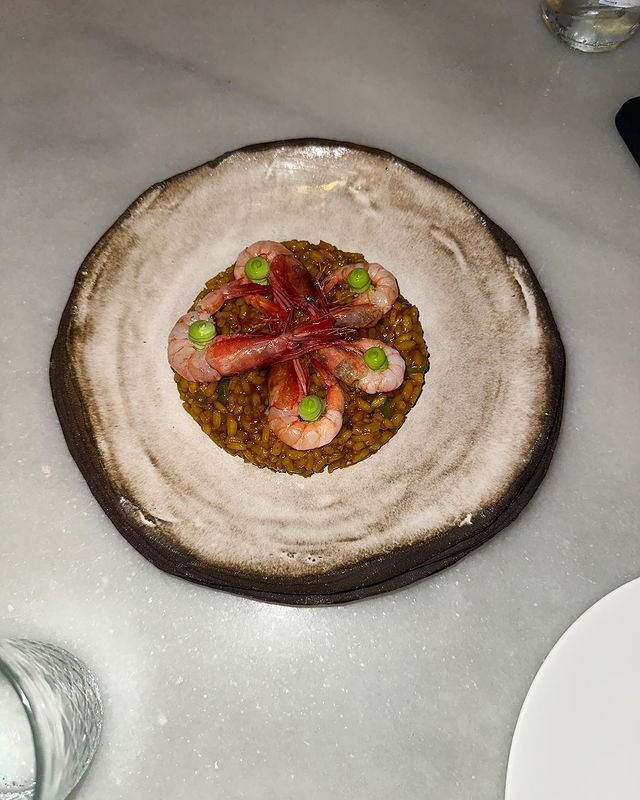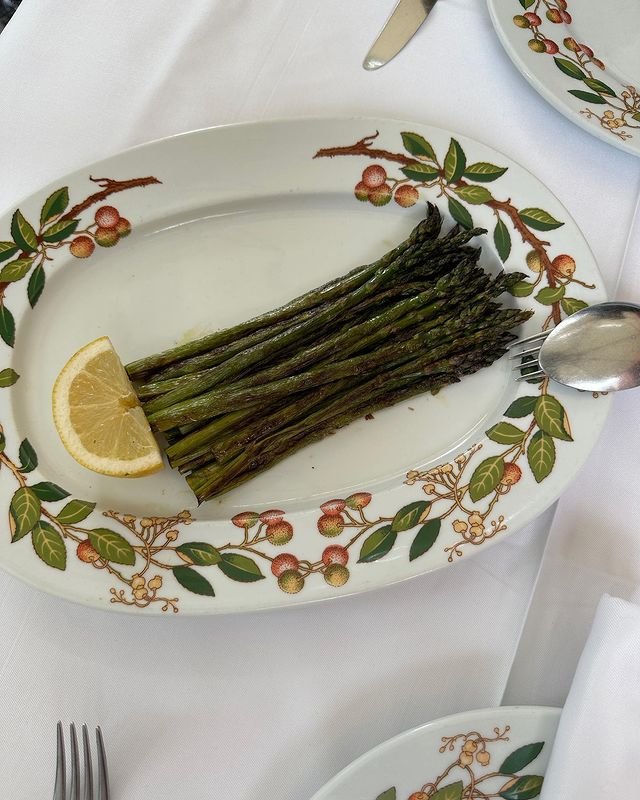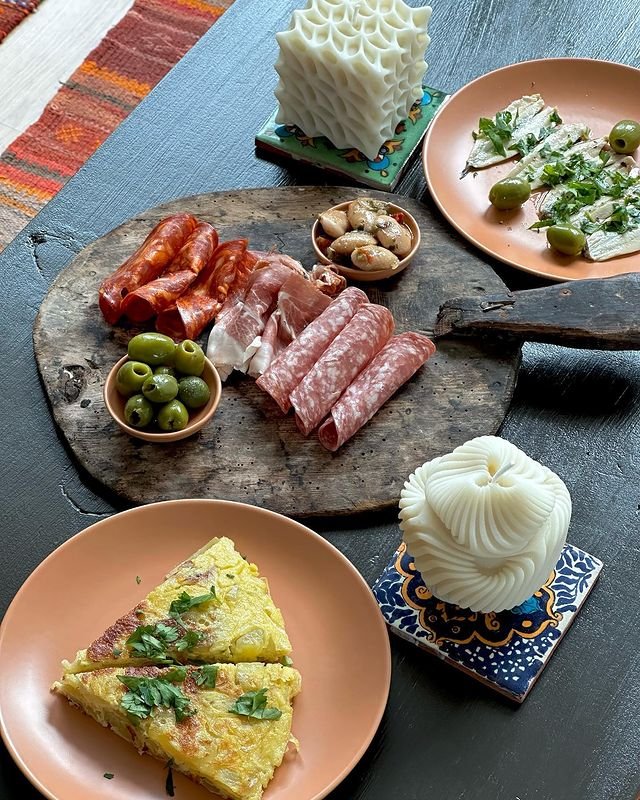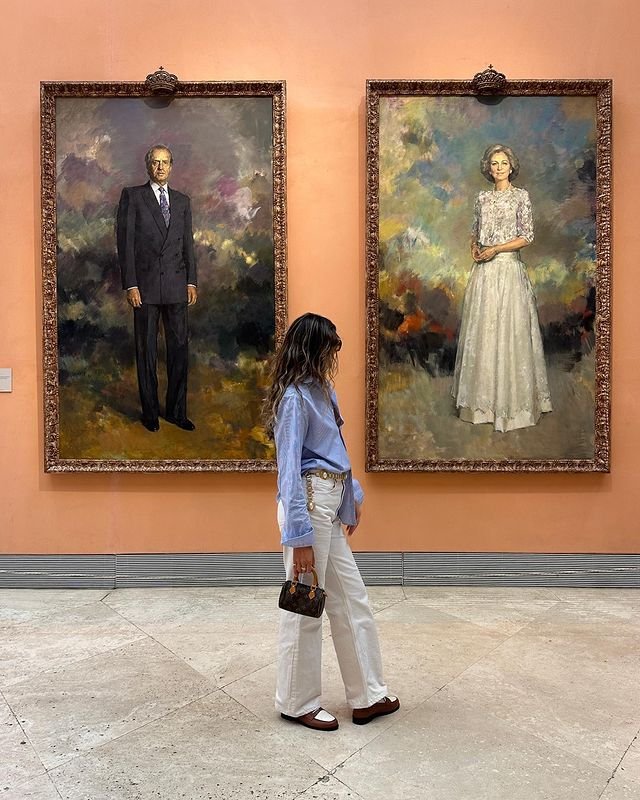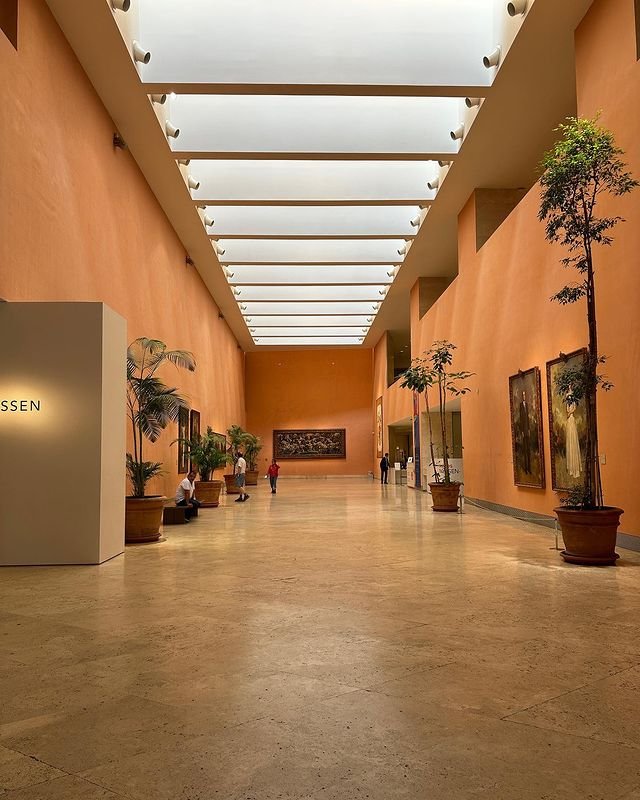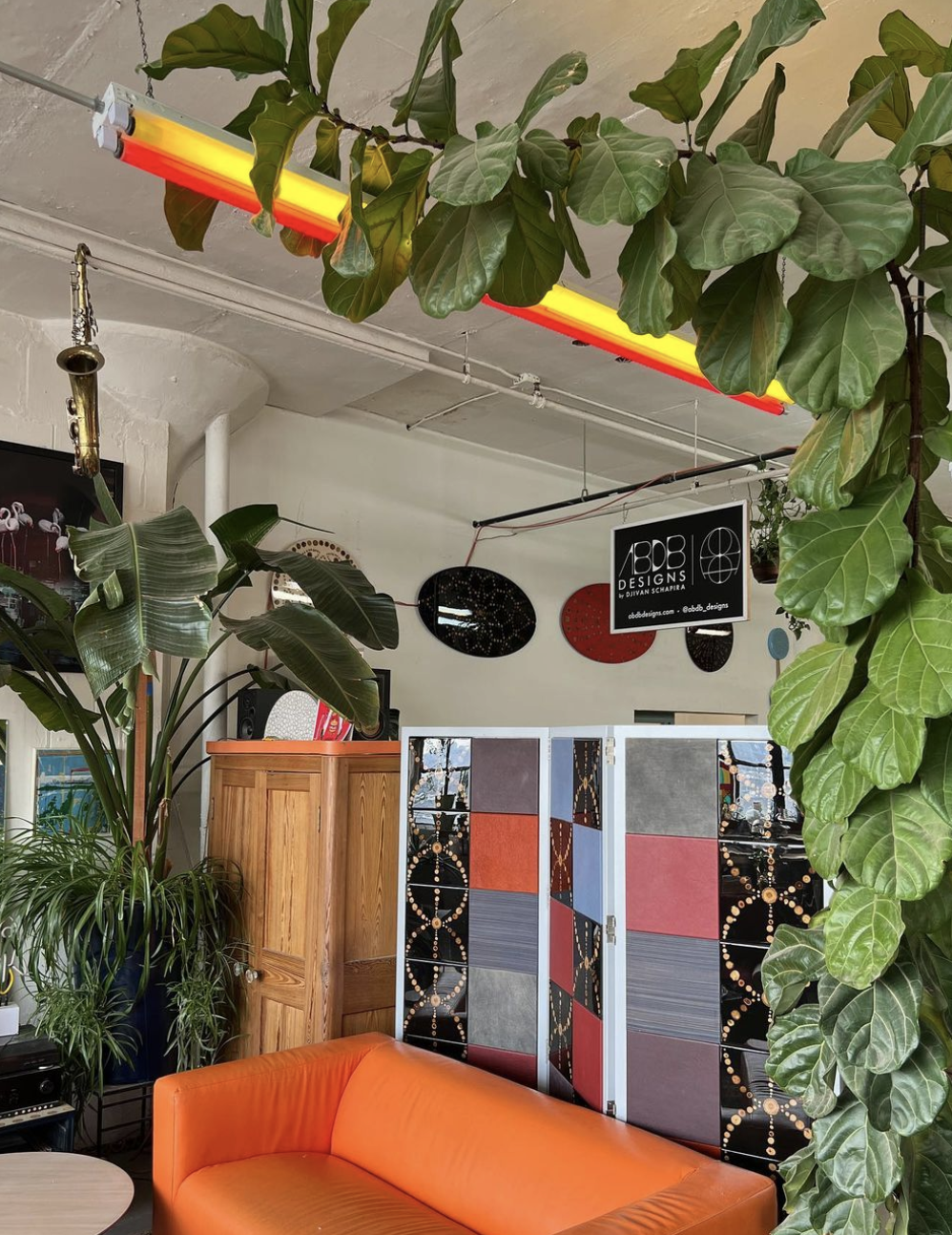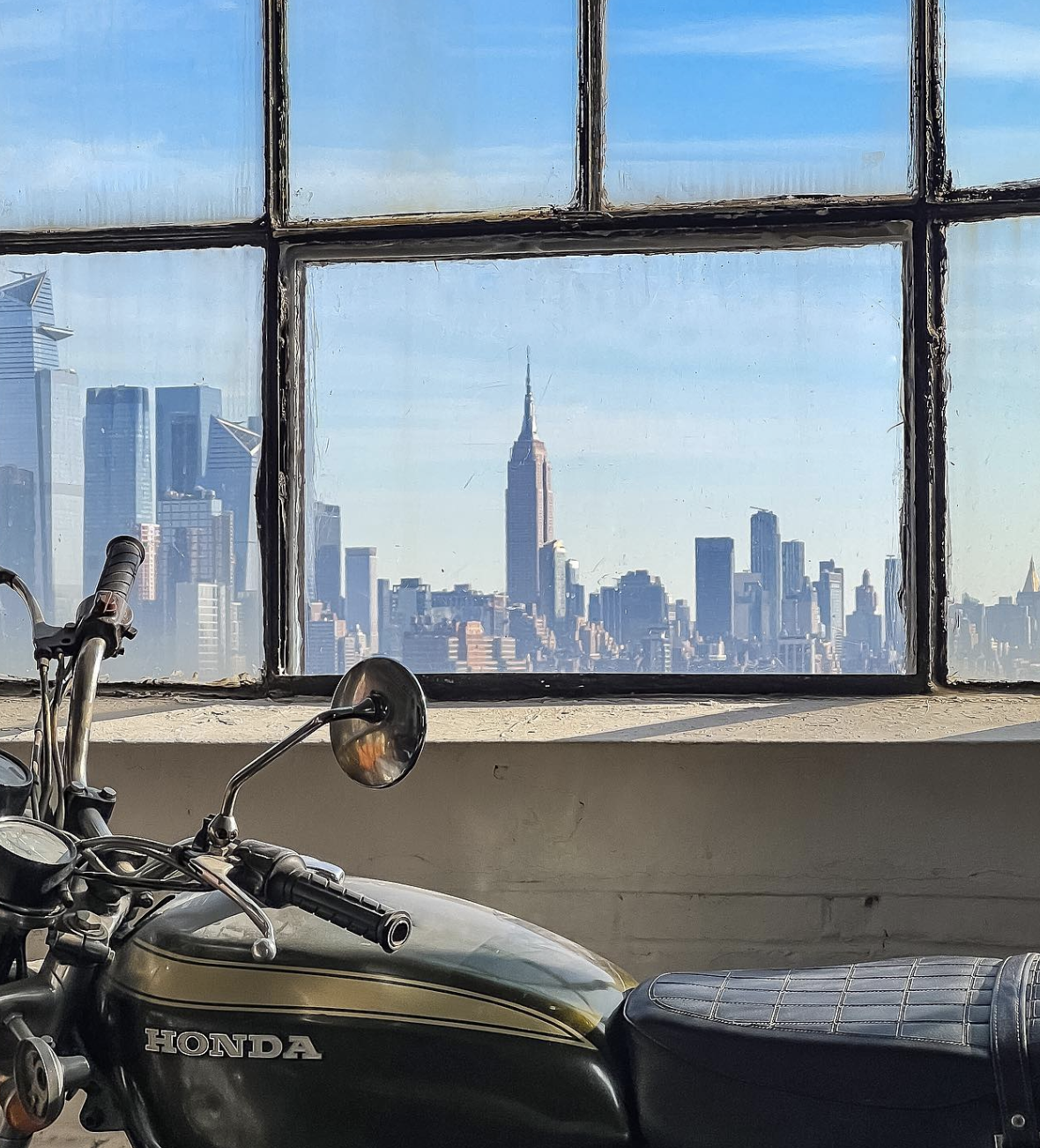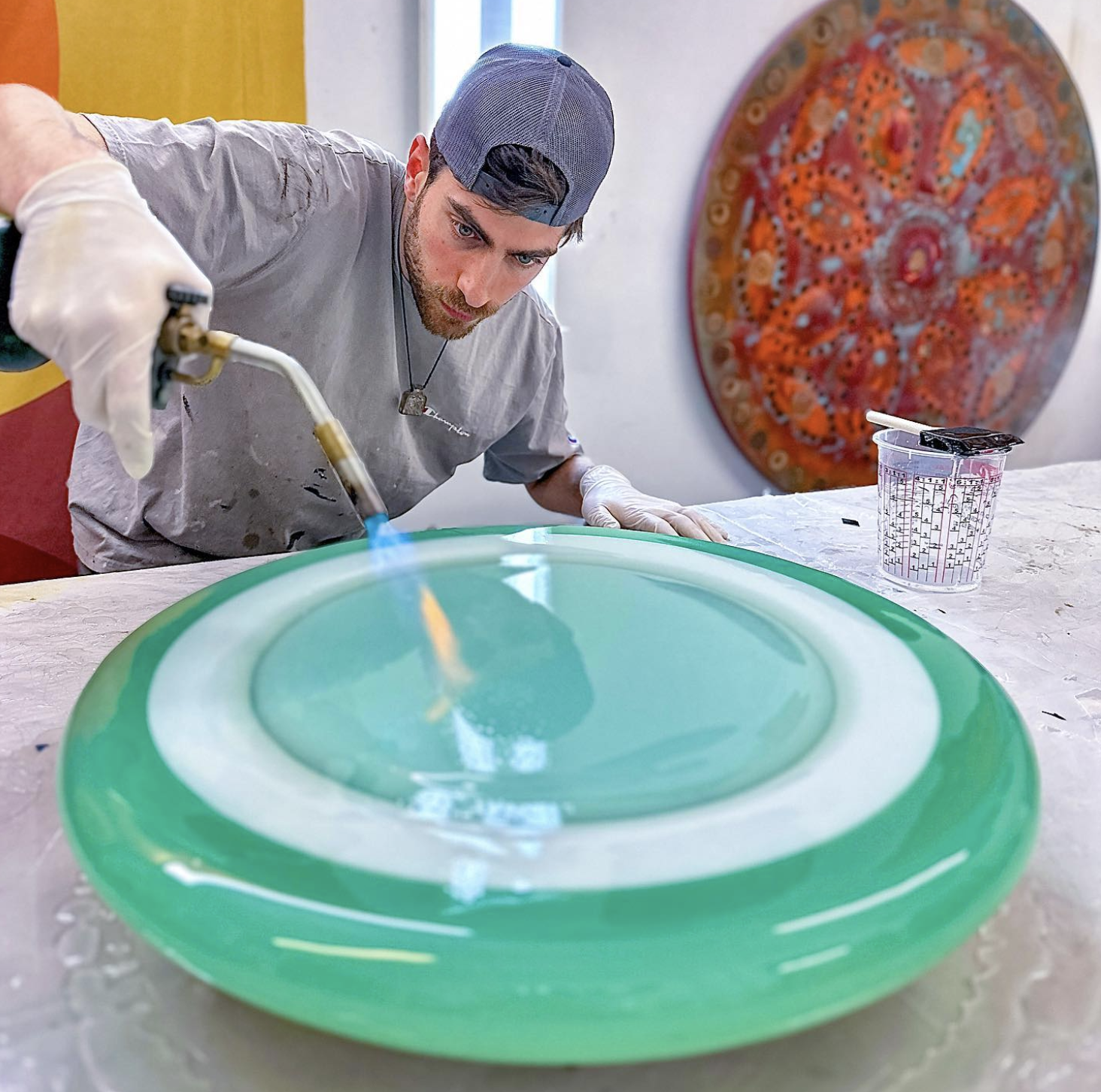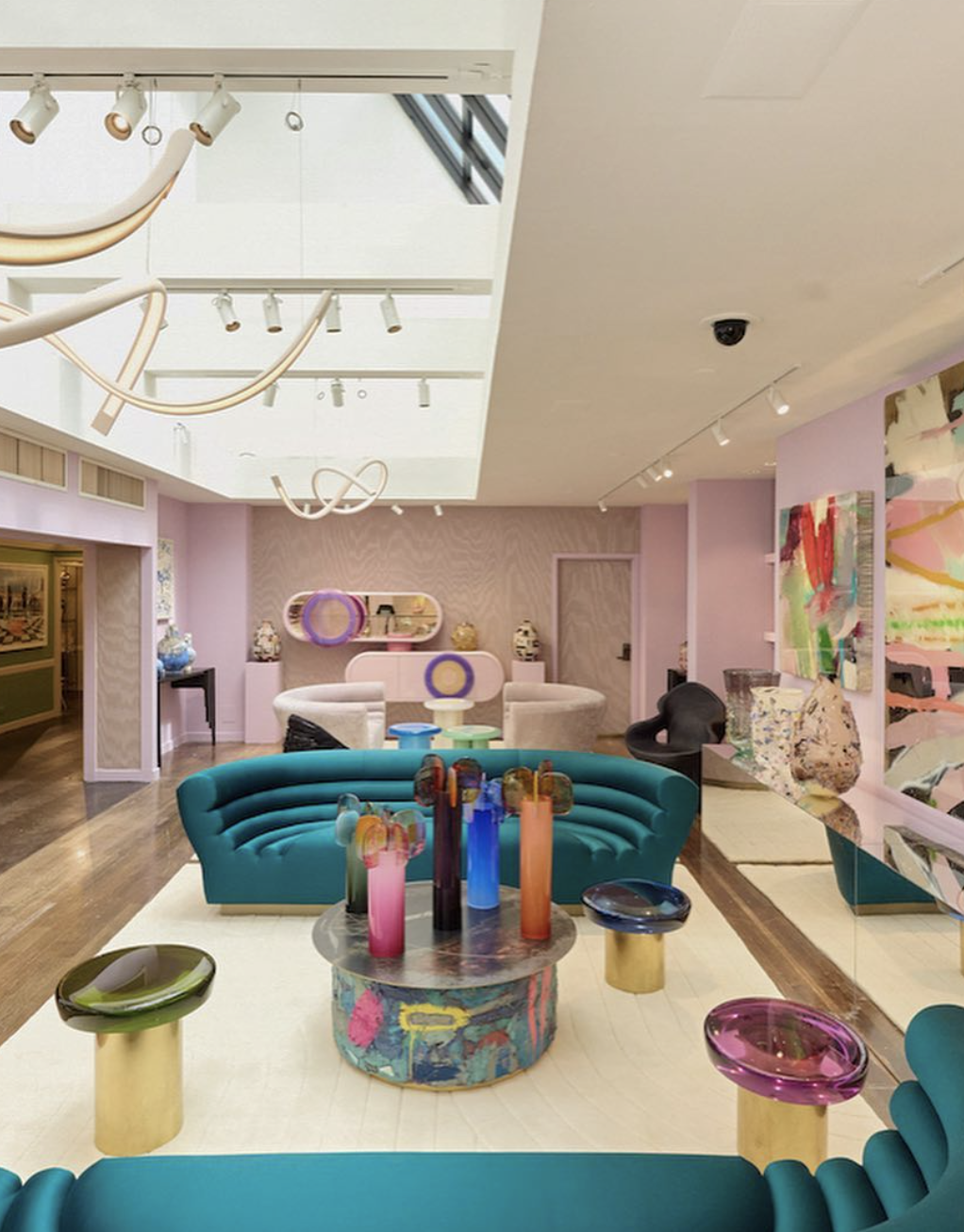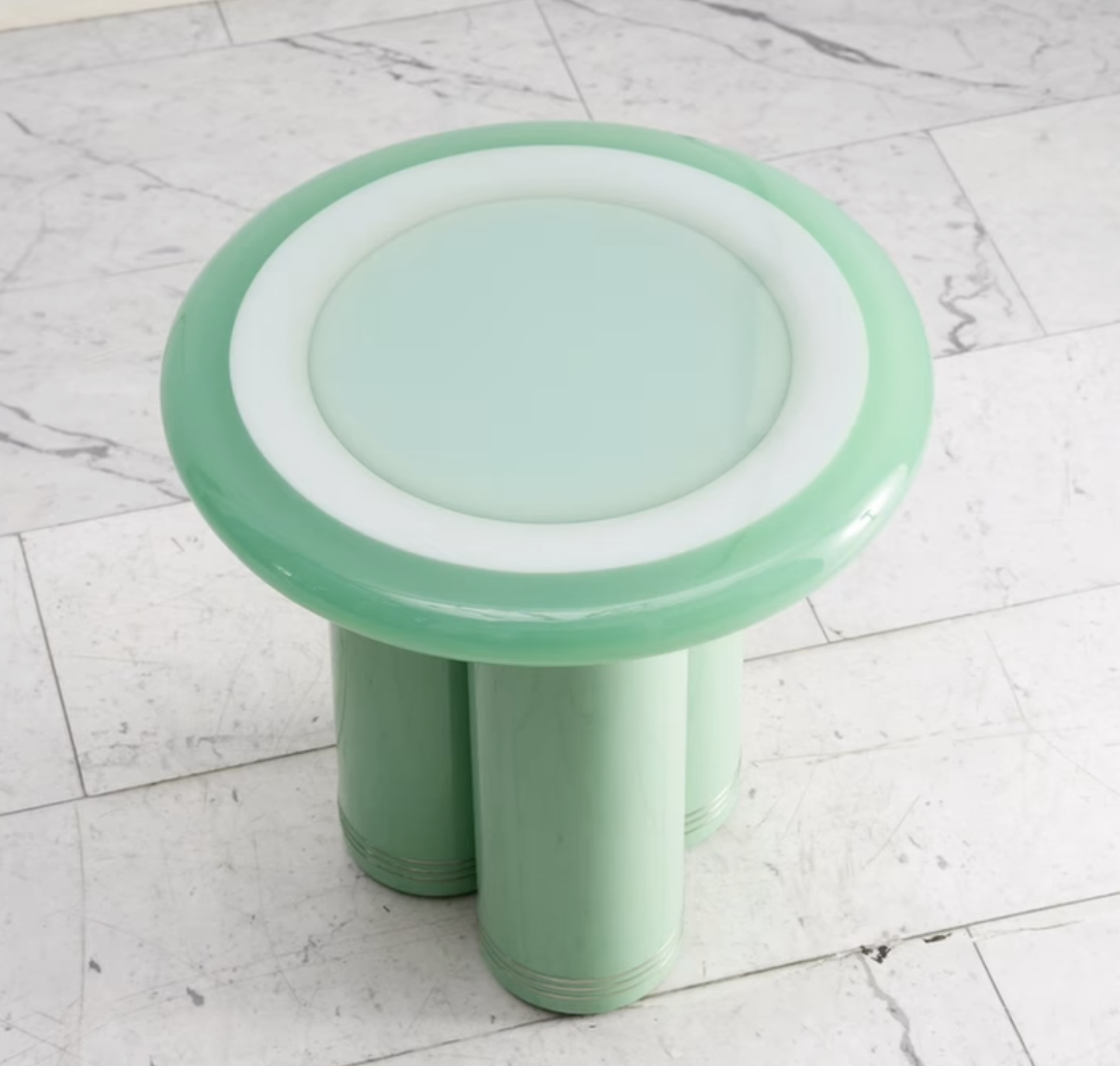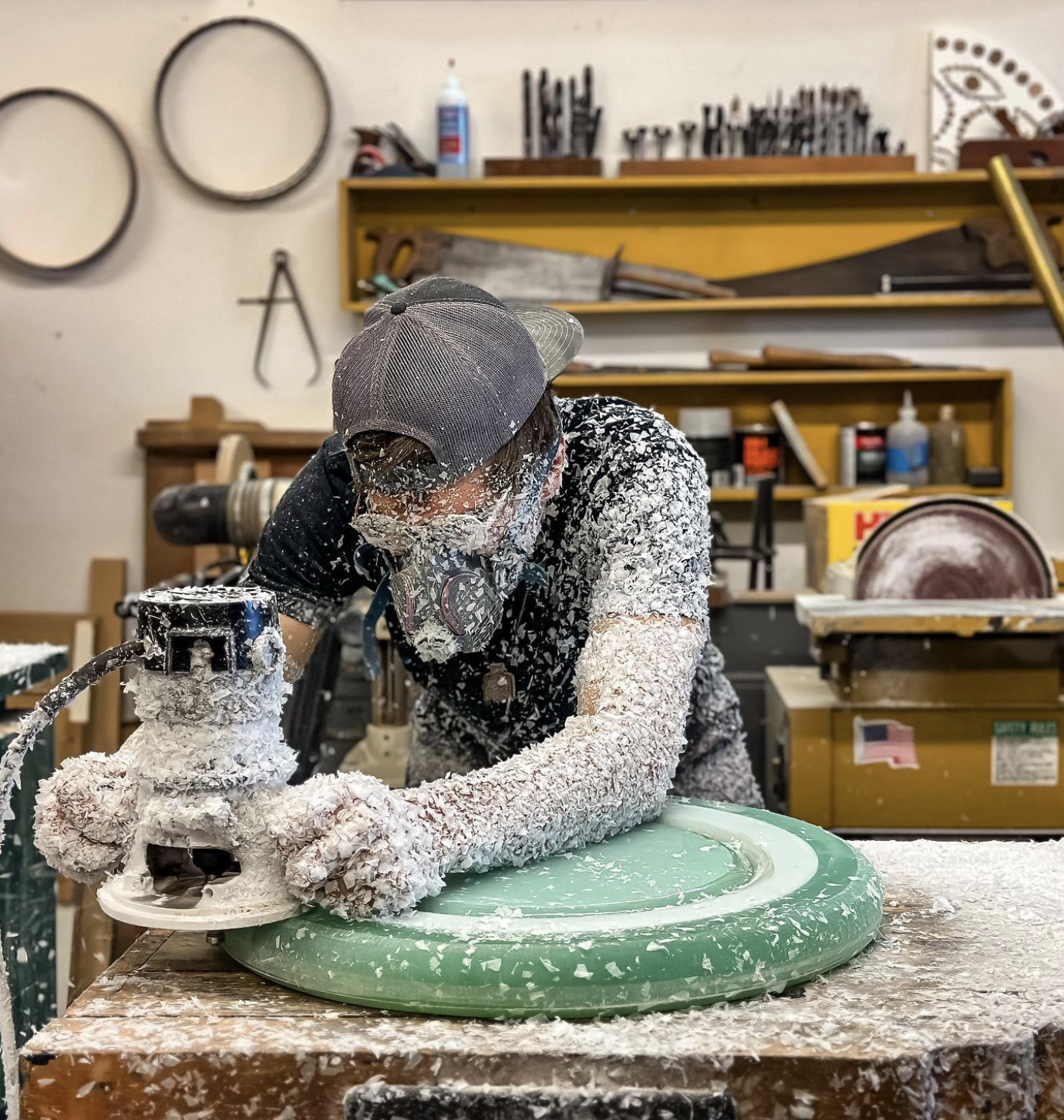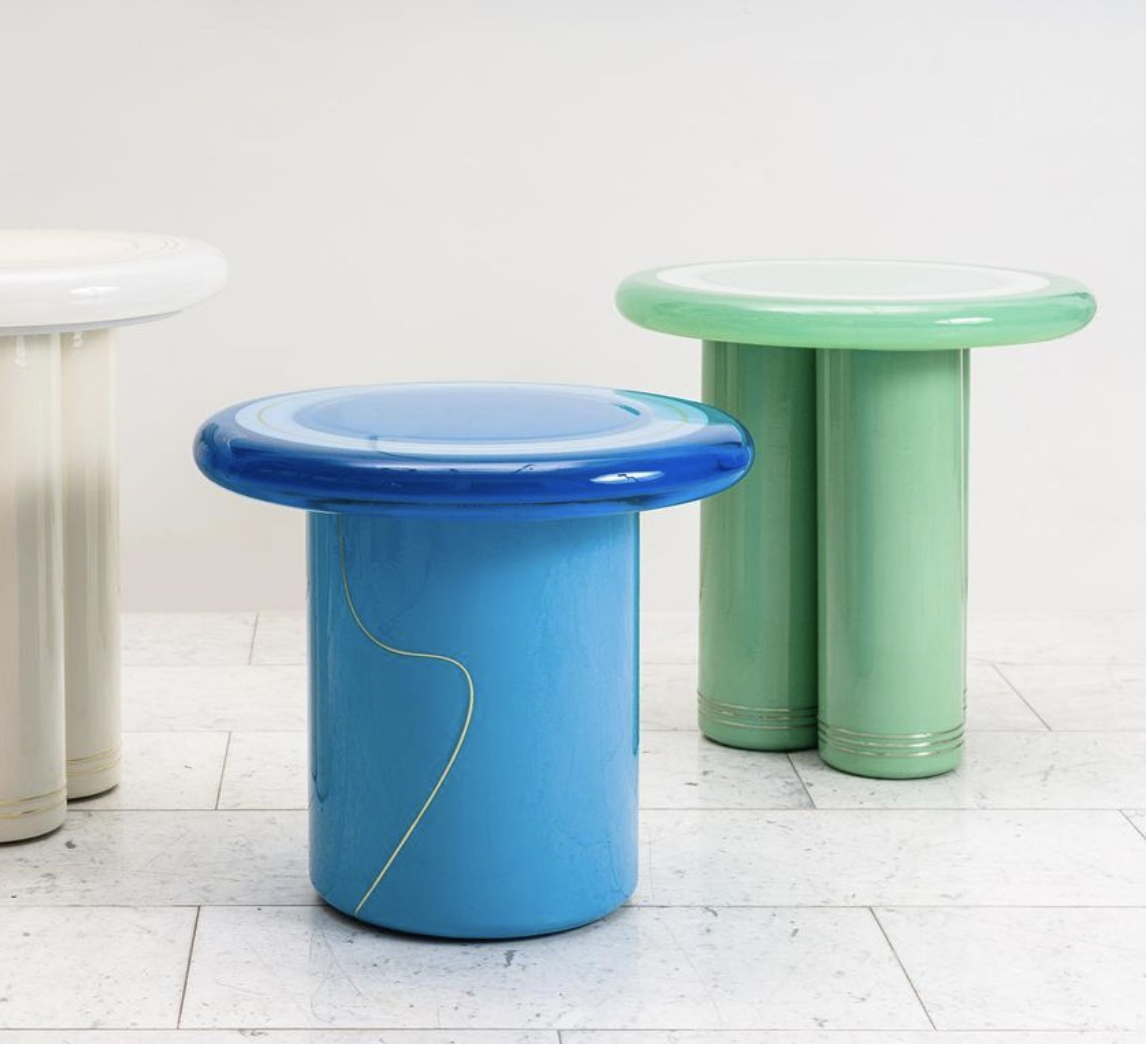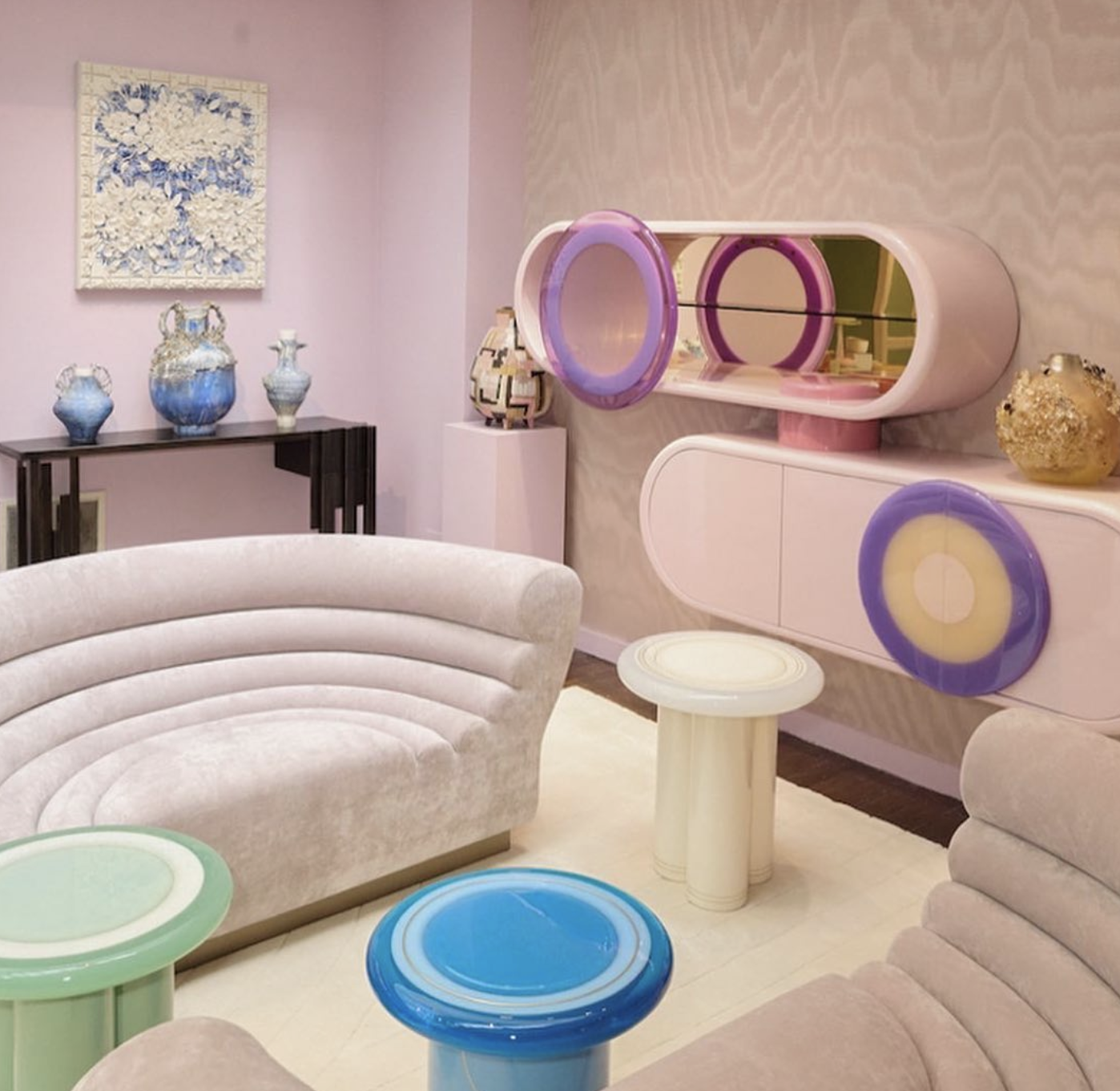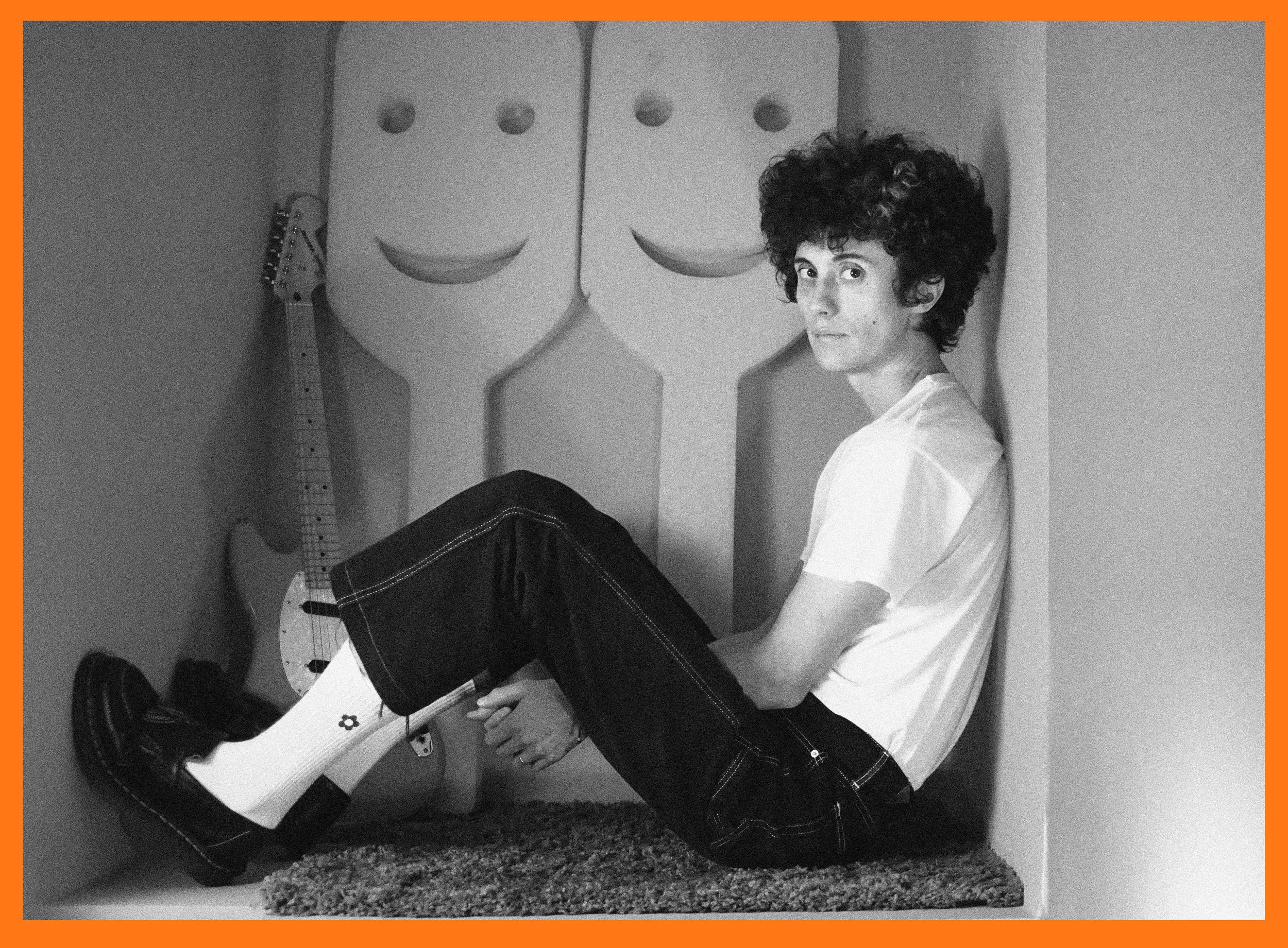“Blue Collar”: A Conversation with Clarke & Reilly on their new show at SIZED Studio
Forgotten artisians behind America’s clothing production, reminding us of the invisible hands that shape our world.
This month marks a significant moment for art enthusiasts as design duo Clarke & Reilly unveil "Blue Collar", a solo exhibition hosted at SIZED Studio. Located in the heart of West Hollywood, the show invites the viewer into an evocative environment, bringing to life a profound exploration of journeyed indigo fabric transformed into 60 unique, hand-crafted 'T-shirts,' depicting America and its resilient working class.
The exhibition becomes the next chapter in a remarkable series of fabric panels that spans centuries and continents, reflecting the enduring history of indigo. The fabric walls, with their rich indigo hues, bear the imprints of a journey from Somerset, England to Northern California, mirroring the resilience of the Garment District's immigrants. Clarke & Reilly's serves a call to honor the invisible artisans who shape our world, a profound reflection on the forgotten labor that sustains our society.
Photo: Courtesy Clarke & Reilly.
We The Cool: Can you guide us through your artistic journey? How did the idea of partnering in 2005 was born?
Clarke & Reilly: When we first met we were working in different fields – Bridget in fashion, David in furniture, but we felt that we spoke the same language and really responded to the other person’s work. We really appreciated each other’s outlook and how the other saw the world, and were drawn to doing something together. We were lucky early on and had the opportunity to do an interior design project together. It was for an incredible client and there were no limits as to how creative we could be. We went into it really open-minded, and through the constant process of collaboration since then, we’ve honed our skills and practice over the years.
Working collaboratively with anyone always has its challenges, but we each have our own “piece” of the process – those two sides of our experience, our different backgrounds, somehow fit together. It’s no different to anything in life; you find yourself cycling through but you rarely meet people you’re totally in sync with – we were lucky that we did and it felt like a natural fit to work together.
WTC: Tell us more about the inspiration behind "Blue Collar". How does the show relate to the working class in America?
The inspiration for this show was very much a visceral reaction to what we looking at in the world and what was around us. There were times when we’d go for early morning, jet-lag-ridden walks around the neighborhoods of LA, at 5 am or even earlier sometimes, and we would witness the early morning workers as they started their days. Often these people seemed to be hidden away in areas that you might not usually encounter in day-to-day life, which for many of us were off the typical path, in non-descript buildings where you wouldn’t even know that there were people inside. These unseen workers were busy making things that we, as a collective, believe we need in life, but through this work, we wanted to question that perceived need and explore the distance so many of us have from working-class people.
WTC: Can you tell us more about the processes the fabric panels went through, from their origins in different parts of the world to their final form in the exhibition?
The starting point for this project was the textiles; three large panels, 80 ft long in total, made up of pieces of textiles that we’d collected over many years. They came from all over – we sourced pieces from the Black Country in England, the French countryside, and the Northeast – and they span three centuries. Many had a utilitarian or practical element to them; either they were salvaged early utilitarian material, sections of bedsheets and old sacs, peasant cuts, or farming cuts, and some with old repairs and patches. Once these had been assembled and stitched together into panels, they were dyed using indigo from India, the US, and Japan, using traditional dyeing techniques.
We had previously installed the textile ‘walls’ in their entirety as part of our last presentation, AD2021, at the Howard Hughes building in LA, but we knew they would take another iteration afterwards. After that show we took the panels and installed them outside in the Californian countryside, where they were left untended and exposed to the elements for weeks; this had a huge impact on the textiles themselves. So that was the inspiration for blue collar, for all the projects we do really; the textile, the material object. We didn’t originally set out to do this show in this exact format, but it came about through the natural evolution of the fabric, especially after it was exposed to the elements in this way.
We work with things, and it’s a thoughtful process, but we don’t set out with an idea that the textiles or objects will look a certain way, or with an idea that we want to create these shows that look a certain way. One step in the process dictates the next – and that is by design - where we get to a certain moment in the process and say, ok now what do we do with this? Time is beauty and objects wear time well. We want to keep things going and keep these objects evolving. We are primarily interested in the process, and in that process, we hope that something good comes out at the end of it. We’re okay if the process takes us in a different direction; we stay open to that.
WTC: What significance does indigo fabric hold for you?
There is so much politicization around indigo, but for us it’s the absolute beauty of it; how it fades, how it evolves, and the depth of color within it. It can be really intense. Each time you use the dye you never really get the same result, and that can be exciting. We’re drawn to the natural element of it, the essence of it – as a plant and as a part of nature.
Photo: Courtesy Clarke & Reilly.
WTC: Your work explores the invisibility of workers in the Garment District. How do you aim to bring their stories and experiences to light through your art?
For this show, we chose to create t-shirts – a symbol of the classic American working class – which we see as a metaphor for where we are as a collective today. The intention with this body of work wasn’t to literally bring the stories and experiences to life, but we want to evoke the idea and the feeling of something, the raw nuance of it.
There are 64 ‘t-shirts’ in the show, and in one way, they are representations of everything that is used and consumed by us and serve as a reminder of that. In the process of crafting them from the textile panels, they have also come to life as objects. Each has its own characteristics so that we can see them as individuals in the same way we might see people as individuals; each ‘t-shirt’ has taken on a slightly different form, with different signs of exposure, in the way that each of us is different, from a different place or of a different nationality.
It’s always been an emphasis in our work to expose what isn’t seen, what lies underneath, whether it’s the wooden frame underneath a sofa or the unseen communities creating the objects that we all consume. It’s not for us to tell the workers’ stories; that’s not a goal we would want to take on. The spaces we create are an emotional response to what we see and experience, and they serve as an invitation to the viewer. This is the basis of all our work. Once we’ve created that environment the onus is on the viewer to encounter it and respond to it in their own unique way.
WTC: Tell us more about the creative process behind crafting the 60 unique 'T-shirts’ featured in the exhibition?
As a creative duo, we worked on different elements of each show, and this part of the process was led by David, with the crafting of the shirts was very much based on the idea of the classic work t-shirt. The size and shape of the textile panels dictated where the patterns were cut rather than it being something David decided upon. He liked how that seemed to speak to humanity – the fact that you don’t get to choose the size or shape of your limbs, the color of your hair. In the same way, he didn’t really choose each shirt or pocket – but they were designed to make the best use of and to maximize the textile so that there would be as little waste as possible.
Once the first chalk form was drawn out, it became quite a natural process, a bit like a big jigsaw. It was very orderly, and not random at all. Then all the pieces were laid out in the studio over weeks and weeks – and were cut out and stitched together.
Each one of the ‘t-shirts’ is unique – the weathering of the fabric dictated their personalities, their uniqueness. It was the weathering that aged them or distressed them and gave them a rawness. There was honesty in how the patterns were laid out so that one section or element of the textile wasn’t favored over another.
Photo: Courtesy Clarke & Reilly.
WTC: What do you hope viewers will take away from experiencing "Blue Collar" at SIZED STUDIO?
Beyond the raw emotion and the beauty that we’ve already spoken to, we don’t have a particular expectation, but we hope that viewers might feel a sense of uncomfortable or awkwardness in the beauty of it.
The sound, which was created in collaboration with composer Magnus Fiennes, plays into the awkwardness too, in that it is slightly jarring and perhaps a bit intimidating. Sound was always intended to be a big part of the show and it’s why we often do sound collaborations –it makes the experience more immediate as all senses are met. David and Magnus shared many inspirational pieces of music and sound over the course of the collaboration, including junkyard percussion, colliery brass bands, Americana period musical instruments, and even some spoken word, which often mirrored where David was at in his creative process with the textiles. It’s the perfect compositional score to the work as it really draws on the sense of the industrial and the working class.
WTC: As artists, how do you see your role in shedding light on social issues like the working conditions of the garment industry workers in Los Angeles?
As a collective, we’re getting further away from the humans that make the things we use every day, with many of us no longer aware of how things are made or by whom. Collectively, there is a trend to no longer think of those people. Our work has always been about exposing the people who made the object and the hand that crafted something - whether it's a sofa frame or a group of people. In speaking to this, we used the off-cuts from the ‘t-shirts’ to make the low visibility vest that is also on show – there is a lack of visibility of the working class today, and through blue collar we hope to make them visible.
Fish & Kitsch: A Surreal Ode to 80s Aesthetics
Step into the world of Charline Barber and Mathilde Gonthier as they ingeniously transform vintage dishes into vibrant jewelry showcases, drawing inspiration from the South of France's coastal allure and 80s aesthetics. In this editorial for We The Cool, their collaboration celebrates the beauty in kitsch and the power of creative synergy.
Born from the imaginative collaboration of Charline Barber and Mathilde Gonthier, Fish and Kitsch draws inspiration from the atmosphere of seaside resorts in the South of France. Their vision is to pay homage to the region's unique ambiance, recreating the essence of a kitschy postcard found in beachside souvenir stores.
Creating surreal scenes, the duo ingeniously transformed vintage dishes into showcases for jewelry pieces. Their creative inspiration draws from diverse sources, including Martin Parr's iconic series "The Beach," the surrealistic and colorful imagery featured in Toilet Paper Magazine, Marcel Duchamp's ready-made art, and the zany, offbeat aesthetic of Nadia Lee Cohen.
The allure of 80s aesthetics holds a special place in the hearts of Charline and Mathilde, despite not having grown up in that era. Cultural elements from the 80s have left an indelible impact, resonating in contemporary art and design. The duo finds fascination in the nostalgic emotions evoked by this era, inspiring them to create innovative works with a vintage-inspired twist.
From Charline and Mathilde's perspective, kitsch takes on distinct meanings. Charline perceives it as a creative twist on bad taste, while Mathilde defines it as a style marked by excessive, gaudy, and sometimes tacky elements. Despite potential criticisms regarding its artistic value, they wholeheartedly embrace kitsch's mantra: "ugly is the new beautiful”.
Charline and Mathilde work seamlessly together, brainstorming and curating mood boards for inspiration. They experiment with various mediums and collaborations, crafting new visual wonders they take pride in.
Fish & Kitsch is a testament to 80s aesthetics and the power of creative collaboration.
Elena Reygada’s Kitchen
In the ever-evolving world of gastronomy, the culinary maestro is redefining the art of living.
Exploring the mind and life of the acclaimed best female chef in the world.
Photo: Maureen M. Evans.
Elena Reygadas is not merely a chef, she is an artist who orchestrates symphonies of flavors, textures, and aromas that transport plates to new realms of culinary bliss. With a remarkable ability to infuse her Mexican culture and knowledge with her creations with passion, innovation, and deep respect for tradition and ingredients, Elena has crafted a culinary repertory that has garnered widespread acclaim and reverence.
As the proprietor of renowned restaurants such as Rosetta, Panadería Rosetta, Lardo, Café Nin, and Bella Aurora, Elena has established herself as a visionary in the industry, where her commitment to sustainable sourcing, locally-sourced ingredients, pet-friendly spaces, and seasonal menus has become a hallmark of her gastronomic philosophy. Her holistic approach to dining extends beyond the plate, with a keen understanding that the art of living encompasses the entire sensory experience, captivating guests through thoughtful ambiance, warm hospitality, and meticulous attention to detail.
Photos: Ana Lorenzana and Maureen M. Evans.
Karen: How do you usually start your day?
Elena: I get up and have breakfast with my daughters. After they leave for school, I walk to the bakery. From there, I generally go to Rosetta.
KS: What are you most passionate about being a chef?
ER: Promote through my dishes a healthy and healthy diet, for our bodies and for planet Earth.
KS: What elements, outside the realm of cooking and food, inspire your work and define you as a person?
ER: Many things. I think that cooks should be curious and go beyond the gastronomic dynamics. I find inspiration in art, in literature, music, movies, and conversations with my loved ones.
KS: Tell us about the day you found out that you had been named the best chef in the world at The World's 50 Best Restaurants 2023 awards.
ER: It was a day of enormous emotion. For me, this recognition is for everyone in my team. And also for the Mexican women who cook daily for centuries ago.
Photos: Maureen M. Evans.
KS: Living in a city as cosmopolitan as Mexico City, where do you go to keep your mind and creativity stimulated?
ER: I love traveling through Mexico. I recently took a wonderful trip up the plateau Purépecha, in the state of Michoacán.
KS: Is there something you couldn't live without, both in the kitchen and in your life staff?
ER: My daughters.
KS: How does your lifestyle function and impact your professional life and vice versa?
ER: I don't know. I try to do everything with passion and find balances. The hardest thing is being a mother and a cook at the same time.
Photo: Maureen M. Evans.
KS: Do you have any weaknesses that you are working on to improve?
ER: I am always working to improve. In the kitchen is something you never know stops.
KS: In your Rosetta restaurant and bakery, what do you want to reflect about yourself to your diners?
ER: I want them to discover new flavors, new ingredients and show them that what we eat has a huge impact on our health and also on the environment.
KS: How can we see you reflected in your creations for Rosetta, Panadería Rosetta, Lardo, Café Nin, and Bella Aurora?
ER: In every detail, both in the food and in the decoration. Sometimes when people come to my house, they say that it's identical to Rosetta. I think they are right. All are part of an affective and sensory universe.
Photos: Courtesy.
KS: What are your ambitions and future projects?
ER: Continue working firmly on what I already have and continue to strengthen the initiatives and social programs that I have initiated, such as the Elena Reygadas scholarship to support young Mexican women studying cooking.
WE ARE ONA: The ephemeral gastronomic collective that’s taking over the world
A WhatsApp call with Luca Pronzato, sommelier, restaurateur and founder of We Are Ona, on food, experiences, creativity and entrepreneurship.
The human experience is a tapestry woven with the threads of our senses. Sight, hearing, taste, touch, and smell provide us with windows to the world, allowing us to immerse ourselves in the richness and depth of life. When we consciously engage and stimulate our senses, we awaken a profound connection to our surroundings, heighten our experiences, and cultivate a deeper appreciation for the beauty that envelops us. That’s what We Are Ona strives for when throwing the most delicious and visually stunning dining experiences we’ve ever seen.
It was the fall of 2021 when I first heard of We Are Ona through one of my best friends down in Mexico City. I was looking for new restaurants to go to after almost three years of not visiting my hometown and she immediately introduced me to the collective. It was a beautiful experience, she describes, downtown right behind El Templo Mayor. The dinner she attended took place on the rooftop of Círculo Mexicano, the newest addition to Grupo Habita’s acclaimed chain of luxury hotels. All the ingredients were sourced locally and each course was carefully paired with a specific glass of wine. But beyond the food, what captivated her was the knowledge and service of every single member of the staff; “you spoke to every single waiter and they would all explain in depth the reason behind every single ingredient and wine pairing”, she told me. One week after I arrived home, and when I was about to make the reservation, the collective had already moved to another city, so I promised myself I would eventually make it to one of their popups.
While this awaited night happens (fingers crossed soon) I couldn’t resist but reach out to Luca Pronzato, sommelier, restaurateur and founder off We Are Ona, to learn more about his vision and his community of food creatives. We spoke via whatsapp and immediately connected over creativity and entrepreneurship.
Amor Díaz: Can you walk me through a typical day in your life as a culinary artist?
Luca Pronzato: We create culinary experiences for brands that are mainly in the fashion, design, and architecture industries. I run the studio so my day is never the same. We are doing a lot of events but when it comes to the pop-ups, which are about 10 a year, I do a lot of kitchen scouting. We are building bridges between the hospitality and the event world, we are trying to create a really special atmosphere through the spaces that we choose, the flower arrangements, ceramics, and the food... so my creative team work hand in hand every day. Usually, the brands send us a special idea of what they need and we take it from there to create. We also curate pop-up restaurant experiences that are open to the public. There’s a lot of rendering and space design, we look for talent in the specific cities where we pop up, and there’s a lot of tasting and material sourcing as well.
AD: What are some of the challenges you face on a daily basis, and how do you overcome them?
LP: I would say that we are constantly learning. There is no other company that is doing what we do, so there is not really a route/path or business model to follow, so we are learning as we go. This is beautiful but also very challenging.
AD: What’s been your favorite project?
LP: It's hard to say, I really don't have a favorite one, but lately it's been very nice because we are working more in the US. We recently did the Chanel show between seasons and we did a really cool dinner at WSA to celebrate Art Week in New York around TEFAF, Independent, and Frieze.
We Are Ona, WSA, New York
AD: Curious to know (coming from you) your favorite, restaurants, bars, and coffee shops in France.
LP: I go to a lot of restaurants, I source a lot of talents, so it's hard to choose only one. We created a guide, an app, called “The Chefs Guide” developed in partnership with el agua Evian, that references 3000 restaurants - a free international culinary guide allowing users to access restaurant recommendations sourced by chefs worldwide.
AD: What’s in the pipeline for the rest of the year?
LP: We are doing some more popup restaurants. We are doing Paris, during Paris fashion week, Miami for design week, and finishing in Paris again.
The Art of Living
Living is indeed like art, always in progress and crafted through our choices, actions, and experiences. In our fast-paced and goal-oriented society, it is common to constantly strive for more. Often, we become fixated on reaching the destination, believing that true happiness lies only in the attainment of our desires. In our relentless pursuit of the future, we often overlook the beauty and joy that resides in the present moment, in the actual journey.
In this issue, we talked to several creatives, entrepreneurs, and activists about the importance of valuing the process and finding contentment in the present moment. We dived deep into their daily routines to learn how it is to live life in their shoes as they bring forth their imagination, passion, and unique voice to create a life that is vibrant, meaningful, and filled with beauty.
We spoke with Luca Prozato founder of We Are Ona, whose ephemeral dinners are making people around his tables awaken a profound connection with their surroundings through unique flavors and striking installations. We learned about the beautiful journey of Constantinos Panayiotou, acclaimed 3D artist, and his life in Cyprus. We bonded with Ivana, the creator of Rhythm Zero, as we discussed the significance of breaking away from our perpetual and sometimes mechanical rhythms in life. We emphasized the value of cherishing the present moment by indulging in coffee and fostering a sense of community. Additionally, we spoke with Anastasia Miari, author of Matriarch Eats, an editorial endeavor that gathers narratives and meticulous recipes from grandmothers across Greece and the world.
As you, our beloved readers may already know, We The Cool Magazine celebrates culture. In this issue, we intend to also celebrate the everyday, life itself, the present, and the now.
“Life is not just about reaching destinations; it is about relishing the journey, embracing the process, and appreciating the beauty that unfolds along the way.”
Yours truly,
We The Cool Magazine
The Gothic Blues of Adia Victoria
A musical journey that knows no boundaries.
Adia Victoria, the brilliant artist behind the mesmerizing genre fusion known as "gothic blues," brings together the best of rock, blues, punk rock, and country in her music. With haunting melodies, powerful lyrics, and a commitment to staying true to herself, Adia Victoria takes us on a musical journey that knows no boundaries. Her ability to blend diverse influences creates a one-of-a-kind sound that captures the heart and soul.
Adia's journey in music began when she picked up the guitar at the age of 21. Initially captivated by the sounds of Johnny Cash and Hank Williams, she soon discovered the blues, which would forever shape her perspective. Through the blues, she discovered the power of connecting mind and body, intellect, and muscle, and embraced the innate knowledge and wisdom residing within her own being. The moment she encountered the music of artists like Skip James, Adia felt seen and understood, as if a spiritual advisor had appeared to guide her through life's complexities. The blues became a powerful force that didn't ask her to be anything other than herself—an unfiltered expression of the raw human experience, both troubling and beautiful.
Shaped by Adia's profound musical journey and the transformative power of the blues, our interview took place. From the complexities of womanhood, and being a Southerner, to defining purpose and embracing the art of living, our conversation touched upon the very essence of human existence.
Pilar Alvarado: There is a constant theme in your body of work: belonging. You exist as a person, as a woman, as a black woman, and as a Southerner. What does it all mean to you, how do you define belonging?
Adia Victoria: I think the reason I write about it so much is because it's something that I didn't feel growing up. It's something that I struggle with feeling, I didn't belong even within my church and my family. I think belonging means knowing that someone can see you, knowing that someone can see themselves in you and in your experience. That you are not an aberration, you are not this offshoot of everyone else. I think belonging is a nurtured commonality between people — and that's something that's very hard to come by in this world, past a superficial level.
Pilar Alvarado: Do you feel that sense of belonging and understanding with everyone around you who listens to your music or collaborates with you?
Adia Victoria: I should hope so, but I think the greatest gift that I've received being an artist is that I now belong to myself. And from that belonging within myself, I don't necessarily go out looking for anymore. We are all human beings. We all go through this life once, and it's a unique experience for each and every one of us. That's what helps me find common ground with people and create a sense of community. It doesn't matter if someone is a musician or not, or if they look like me or come from the same place as me. What matters is that we're all going through this very similar human experience, where none of us truly know why we're here. That's the common link between all of us, and ironically the one that’s the most denied to us.
Pilar Alvarado: Yeah, absolutely. Has the transformation that you’ve undergone, where you now feel a sense of belonging to yourself, also influenced your career?
Adia Victoria: Yeah, I think I've evolved as a human and as a woman, and at the same time I've evolved as an artist. I've become a lot more comfortable in my skin as I've gotten into my thirties and accepted myself. And once I was able to do that I need fewer other people to accept me. You know, it's like it's nice if you do, but at the same time, if you don't that's not really my problem. And the same goes for my art. It's like, yeah, of course, I want people to accept my art into their lives and support me and whatnot, but that can't be my final mission.
Pilar Alvarado: Sometimes I feel I need to be less emotional and more objective with what I say because I am a woman. As you've evolved as an artist has that changed within you, do you repress less what you want to say and show up as authentic as you are?
Adia Victoria: If anything, I would say my work can sometimes be too subjective, I don't believe in objectivity. But no, I think that men have the same issue too. I think that's something that men have used to be dominant in a higher-up social hierarchy. They've tried to claim objectivism as their own and say it's just stated eternal truth. It's, well, very convenient that objective truth happens to align with your agenda and your needs, you know, and your desires. So I think that men are just as repressed as women, if not even more repressed because they have more to, "lose" if people are to truly start seeing this commonality between all of us.
“I thank God I was not born a man. ”
Pilar Alvarado: So do you think being a woman gives you an advantage in that way?
Adia Victoria: I think it is an advantage if you're willing to claim it for yourself. One of the things that bother me a lot about women in music is they want to be equal to men. They want to be men and have the same advantages. But the last thing the world needs is more people thinking with a male masculine mind because that's what's gotten us into this mess in the first place. I feel that as a woman, there is power there, as a black woman, there's even more power because you are so removed from the center of power that you have a greater perspective on things. There's nothing innately magical about being a black woman. What I have as a blessing, was initially the curse of being a black woman on the outside of things. But I decided to use it to my own advantage. I'm not going to write the same songs about the same things in the same way that people do.
Silences, 2019 Via: @aidavictoria
Pilar Alvarado: I can't remember where I read this but you said that human nature is funky because it's hard to explain and convey what it means to be a human being.
Adia Victoria: Yeah, it's like, "How would a fish describe water, you know?”
Pilar Alvarado: I think the human experience is about surrendering to life.
Adia Victoria: You know, we are all born and we all die, all nature around us understands this. We are all in a state of flow. Human beings are the only ones arrogant enough to think that we have some claim on permanence. So, what are we here for? If you can divest from all of the shoulds, you realize that nobody knows what they're doing. When you understand that there is no higher power outside of nature, you are a lot freer.
Pilar Alvarado: So, if I ask you “what’s your purpose in life”, what would you say?
Adia Victoria: I think that I don’t have a purpose. My purpose is to be. Just be. I have to be at peace with knowing that maybe I'll never release another record, or reach a certain status in my career or that I will lose my mind one day. I don't know. What is even the purpose of trying to have a purpose?
Pilar Alvarado: I think people sometimes lose themselves trying to figure out what their purpose…
Aida Victoria: To me, that sounds like a miserable way of living. I remember as a kid feeling enraged at the idea that so much of my time was not mine. And I began rebelling against that, and I still feel that so much with people, like you said, running around trying to find their purpose. Are you not worthy unless you're doing something? I think that mindset is a very American way of thinking that we've sold to the world.
“Life doesn’t have to be hard in order to prove that you’re worth having a life. ”
Adia Victoria: We matter just by virtue of existing. I'm just so tired of being told you have to always be hustling and grinding. I wouldn't want to have a career that eats up my life. That's not what I want my life to be about. In America you actually feel guilt for pleasures, you always have to be striving towards an invisible horizon and its exhausting. I don’t want my life to be a fight, I don’t want to struggle and if being in the music industry takes my peace away I have to be fully prepared to walk away from it.
Pilar Alvarado: What are the ghosts and demons that you have to fight with every day and how do they inspire you to create music?
Adia Victoria: I think that the ghosts and the demons that I fight with are the ones that have followed me since I was a little girl. That voice that says you can't trust people with yourself or that no one's going to listen to you. No one's going to recognize you. You're never going to seem normal. You're always going to seem alien. And I have to practice a lot of patience with that part of me because if I give in too much into that, it shuts me down. I have to be patient with my inner child. I have to give her time to air our grievances but I also have to let her know that she's safe. I would say that like my greatest demon: not feeling safe within my own skin.
Pilar Alvarado: What would you say were the tools that helped you get to a point where you feel safe and trust yourself?
Adia Victoria: I've always been good at calling bullshit. And so one of the reasons why I've been able to find safety with myself was looking at what society had to offer me, what they called safe. "If you're a nice woman, if you behave, someone will take care of you. People will love you if you're nice and polite and don't make people mad." That's a lie that's been sold to generations of women as a way to make them stay invisible. So I thought " I don't want what the world is telling me, so whatever it is that I can find within myself, it can't be anything worse than what they're trying to sell me." I had to define what success, security, happiness, and fulfilment looked like for me. And the minute that you outsource that to anything outside of yourself, you're kind of a sitting duck for a catastrophe.
Pilar Alvarado: What you just said, really translated into your music and your lyrics, where do you draw this power from to hold yourself in this space and express yourself in such a profound manner?
Adia Victoria: I work every day on trusting myself. I'm not trying to hold myself up as some role model that's got it all figured out. This business of being alive is tough. It's confusing, it's nasty. It's it's beautiful, it's tragic. And I have to trust myself to be open to all of it. I can't close down certain parts of me that are vulnerable. I have to remain curious until the day that I die. I can never reach a point where I think I've got it all figured out. I want to maintain that childlike curiosity and wonder about the world. That curiosity thrives in me and encourages me to ask questions and not always have answers.
Pilar Alvarado: How’s your writing process? How does it all come together?
Adia Victoria: The process is very entwined with my living. I get my best ideas when I'm walking because I’m not so much in my head. For me, the music has to start with the body, the blues lives in my body. I like to go and read some poetry and then go for a walk with the words, and just see what they bring up in me. Or finding a blues harmony that speaks to me. It’s just all about me remaining alive and present in the moment.
Pilar Alvarado: I'm not sure about your perspective on this, but it's something I've been contemplating. When we consider Southern music, there seem to be two contrasting ends of the spectrum. On one hand, there's the deep-rooted folk, blues, and roots music. On the other hand, there's a wide range that includes country music and more. Do you think there's currently a movement towards decolonizing blues and folk music, where artists like yourself are reclaiming and bridging different influences?
Adia Victoria: I'm not taking it back because I never gave it up. You know, it's always been mine. The question has just been, who gets to make money off of it? Who gets to be seen as emblematic of certain genres? And I can't really speak for the industry, I try to mind my own business. But for me, I feel that there is more of a willingness in audiences. They want stories told by a wider swath of storytellers. They're sick of hearing the same stories by the same people that look like them, that have been marketed to them. People want more breadth, more depth to their art.
Pilar Alvarado: How would you explain the south to someone who is unfamiliar with it?
Adia Victoria: The South is a place that is extremely human, much to its own. It's where humanity was betrayed and revealed itself. I think that it's where humanity has confused itself for a place where gods walk on Earth in the bodies of white men. And I also see the South as a place of the indestructibility of the human spirit. My ancestors came here, you know, 400 years ago to South Carolina. By all means, I should not be here. By all means. I am a freak of circumstances that I should survive and live the life that I do. And it's not on me it's not by my own doing that I sit here and then I'm able to talk to you. It's because I embody the spirit of resistance and joy and determination of my ancestors. And so I think that the South is a place of deeply embedded truths. I think that this land that I grew up on and I grew up in is haunted. And it is still unrest and unsettled. And I think that these truths, they are in the nature around us. They are in the ground, they are in the air, they are in the people, and they are waiting to be acknowledged and cleaned. And I can only imagine what force the South could be if we finally get over ourselves, get over our fears, and face the truths that are in the air around us.
The Fashion House of The Future by Constantinos Panayiotou
To me, the process of learning is akin to breathing—“An inhalation and exhalation. Inhaling knowledge and techniques, and then exhaling through the creation of artwork and sharing it with the world.”
Constantinos has meticulously created an extraordinary collection of 3D footwear explorations through his daily artworks series. In this captivating body of work, he pushes the limits of what can be achieved with a single silhouette, demonstrating his exceptional skills and creativity. By skillfully merging digital expression and fashion, Constantinos draws inspiration from the late 20th century while incorporating avant-garde and futuristic materials, resulting in a truly mesmerizing blend. His artistry has garnered significant attention, with his collaborations quickly selling out, his digital collections making groundbreaking strides, and his work being displayed in esteemed art venues such as the Gucci Vault Art Space. I had the pleasure of speaking with him through a warm and sincere zoom call, where I learned everything about his creative journey and his vision for Pet Liger, “The Fashion House of the Future”.
Amor Díaz: What is it like to be a creative in Cyprus?
I essentially live a very relaxed life out, up in the mountains in Cyprus. It's very rural. It's a very small village. I think there are probably about 60 permanent residents here. Yeah. Um, and they're all sort of above 60 years old - laughs - as well. So, yeah, it's nice and peaceful up here.
AD: Tell me about your journey as a 3D artist. I’m so curious to know how is it that you ended up doing this series of hyperreal visuals.
Yeah, so I initially pursued fine art as a young boy, exploring various creative outlets like copying comic books and developing a fascination for Japanese art in the late eighties and early nineties. However, my artistic focus shifted towards hip-hop in the late nineties and early two thousands. I started writing lyrics, freestyling, and eventually producing electronic music, particularly in the Chicago Duke House style known for its fast-paced 160 bpm tempo.
During this time, I signed with a French record label, released music, and dabbled in DJing. Alongside my music endeavors, I worked as a retail assistant at a renowned fashion brand's flagship store on London's New Bond Street. However, as my music career gained momentum, I made the decision to leave my job and relocate to Cyprus, hoping to dedicate myself fully to music.
In Cyprus, however, I found that the change in lifestyle affected my passion for music. The bustling energy of London and my previous lifestyle had been integral to my creative process. As a result, my motivation to create music diminished.
Despite the shift in my artistic pursuits, I discovered contentment in the peaceful surroundings of Cyprus's mountains and the simplicity of the rural village where I now reside.
AD: So would you say the place you lived in influenced the art you were producing?
Exactly. After settling in Cyprus, I delved into videography and photography, seeking a more introspective form of artistic expression. Initially, I focused on creating music videos for my own compositions. However, my passion for photography quickly blossomed, prompting me to immerse myself in its intricacies. I eagerly acquired lenses, cameras, and honed my skills in this visual medium.
Driven by curiosity, I ventured into the realm of 3D art, crafting surreal landscapes that sprung from the depths of my imagination. Over the course of a year, I dedicated myself to learning 3D techniques, investing three months of intensive study before achieving a breakthrough. It was a transformative moment, akin to a Eureka experience.
I distinctly recall the day this realization dawned upon me. Anticipating hours of gaming on my Xbox, I had just downloaded a new game. However, in a moment of clarity, I questioned the use of my time. Instead of indulging in gaming, I recognized the opportunity to acquire a new skill—creating 3D art. With that realization, I promptly shut off the Xbox, and my journey into the world of 3D began as I downloaded the necessary programs.
Living in rural Cyprus afforded me ample time and lower expenses, allowing me to fully embrace this pursuit. I recognized the privilege I had in being able to follow my artistic passions, a luxury historically reserved for kings, queens, and the aristocracy. I understood that progress would not be immediate and that patience was crucial.
To me, the process of learning is akin to breathing—
“An inhalation and exhalation. Inhaling knowledge and techniques, and then exhaling through the creation of artwork and sharing it with the world.”
Consistently throughout my creative journey, I have embraced the practice of sharing my work online. Whether it was my music or my rap compositions, I have always believed in making my creations accessible. Although I hold a perfectionist's disposition, I have learned not to dwell on overthinking. Instead, I focus on bringing the essence of a concept to life, treating it as an expression, an impression of what is possible.
AD: So tell me about this series of shoes in particular. How did you get there?
As I delved further into the world of 3D art, I found myself constructing digital scenes. However, I felt dissatisfied using pre-existing assets to populate these scenes. It's called "Kitbashing," where I pieced together elements from other artists' work, much like sampling in music. It was then that I made the decision to embark on creating my own designs, coincidentally centered around footwear. While I pursued this path as a means of learning, I don't perceive myself solely as a shoe designer. Instead, I see myself as a sculptor, an artist— an alchemist who distills elements down to their core essence.
If you observe closely, you'll notice that the silhouette of the shoes remains consistent across my work. Over the past year and a half, I have focused on creating iterations of high heels with this recurring silhouette. Each design varies in complexity, some intricate and others more minimalistic. My objective has been to uncover the atomic structure or even the spirit of these shoes, approaching the process with an alchemical scientific precision.
Embarking on shoe design may seem cliché within the realm of 3D modeling, as many artists begin their journey with this subject matter. Nevertheless, as I shared these concepts on Instagram, the response was overwhelmingly positive. Encouraged by the reception, I decided to continue exploring this avenue, recognizing the appeal these shoe designs held for others.
AD: How long does it take you to do one of your designs?
The time it takes to create one shoe design can vary. Sometimes, I may have an idea brewing in my mind for months, refining and developing it mentally. When it comes to actually executing the design on the computer, it could take as little as five minutes. However, the rendering process itself is still quite time-consuming. On average, rendering a single shoe design can take around an hour. Factors such as the materials used can also influence the rendering time. For instance, translucent materials require more time to render from multiple angles. As part of my process, I typically render each model from eight different angles, adding to the overall time investment.
AD: How is it to work with other brands and companies?
During the span of 2-3 years, as I explored different shoe designs ranging from slippers to sneakers and now high heels, I received interest from several brands looking to hire my services. Intrigued, I decided to give it a try. However, I quickly realized that working under their demands and visions somewhat distorted my own artistic vision. While I understood the nature of collaboration, I felt compelled to step away and focus on pursuing my own creative path.
During this time, an unexpected opportunity presented itself when Yeezy, a prominent brand, approached me. They expressed interest in having me join their team in Calabasas. The prospect of such an opportunity felt surreal, but due to my existing responsibilities, I was unable to make the move.
Simultaneously, while engaging in these conversations, I was approached by Wilder World. They offered me a unique project—designing a collection of 100 sneakers, each with its own distinct design. This collaboration marked my first foray into the world of NFTs (Non-Fungible Tokens), an area I had been eager to explore.
AD: Why “PET LIGER”? Tell us about your company, name, and logo.
As we progress, our focus is expanding beyond solely creating shoes. We aim to delve deeper into shaping the brand's identity. Currently, our main focus is on bringing the shoe designs to life. Over the past six months, we have engaged in discussions with top-notch manufacturers and shoe producers worldwide to ensure the realization of our creations.
In the future, I envision the possibility of developing a comprehensive collection encompassing not only shoes but also clothing and other complementary pieces. While our digital presence has been met with great success and satisfaction, exploring the physical realm is something I am eager to embrace.
Regarding the name, "PET LIGER," it originates from my earlier days in the music industry. I had aspirations of establishing my own record label, and one day the name "PET LIGER" simply came to mind. A liger is a mythical hybrid creature, a combination of a lion and a tiger, symbolizing something unusual and almost monstrous in nature—something that defies conventional expectations. The logo, a design created by a close friend of mine, was initially part of a poster for an event, featuring various small animal illustrations scattered throughout.
As our journey unfolds, we seek to shape both the digital and physical realms, continually pushing the boundaries of creativity and identity.
AD: What projects are you working on right now?
We are thrilled to share that PET LIGER has recently announced our unique spin on one of the avatars for Futures Factory. This exciting project revolves around creating avatars where different designers contribute their own distinctive interpretations. We tweeted about our collaboration just a few hours ago, generating buzz and anticipation among our community.
Currently, our primary focus lies in our physical projects. We are in discussions with top-tier professionals in the industry, aiming to create something truly exceptional and executed with utmost precision. Our collaboration with the brilliant minds at Zellerfeld, renowned for their expertise in 3D printing, promises to deliver an extraordinary outcome. Additionally, we have upcoming collaborations lined up, including projects with Phillip Colbert's Lobstars and Amber Parks' Play! Pop! Go!
In addition to these exciting ventures, we are proud to announce our partnership with the Web 3 fashion incubator SYKY. This collaboration marks a significant milestone for PET LIGER, propelling us to the next level and opening doors to new possibilities.
Our journey is in constant motion, with numerous projects and collaborations underway. We strive to continuously push boundaries and unlock new chapters in the PET LIGER story. The momentum and excitement surrounding our brand are unstoppable.
AD: Any advice for your 3D designers?
First and foremost, it's essential to prioritize the creative aspect of your work and let your imagination soar in the digital space. Remember that there are no limitations, so avoid restricting your ideas due to technical considerations. While technology plays a crucial role, it should be secondary to the visual aesthetics and overall appeal of your creations. Ensure that the wearable aspect remains prominent, and let the technology serve as a tool to enhance the artistic expression rather than overshadowing it.
Instead of perceiving your work as merely a product, approach it as a form of art and a means to connect with culture. Avoid getting caught up in the intricacies of technology and focus on creating designs that resonate with you and your target audience. Building a foundation rooted in authentic and relatable artistry will help you establish a strong connection with your followers.
Furthermore, it is beneficial to explore various applications within the 3D space. Experiment with different tools and software to discover what works best for your creative process. Embrace the opportunity to learn and adapt as you navigate this exciting artistic realm. Remember to enjoy the journey, have fun, and let your passion shine through in every piece you create.
#BehindTheCover with Niclas Home
An eye for aestethic and a weird sense of humor.
An eye for aestethics and a weird sense of humor.
Photo: Quyny.
Home is not merely a physical structure built with bricks, but an idea embodying comfort, security, and belonging. It can be the country house you grew up in, that friend you’ve traveled the world with, or even your grandmother’s favorite recipe.
For Berlin-based creative, Niclas —from @niclas.home— this means more than an assembly of walls where style and aesthetics cohabit. It’s the idea of feeling safe and comfortable, a state of mind where we can relax, unwind and recharge batteries, but above all where one's true self can be expressed.
We sneaked into his lovely flat in the German capital to talk about the art of living, fashion, deco goals, and what makes home a home.
Photos: Quyny.
We The Cool: Who is Niclas? What's your story?
Niclas: I’m Niclas, I’m 26 years old and I studied fashion design and fashion graphics. I love aesthetics in every manner, whether it’s fashion or interior. Since I moved to Berlin one and a half years ago, I started my own Instagram channel @niclas.home . In the beginning, I did it just for fun, more like a photo album for myself. I would never have thought that so many people are really interested in my facility. All in all, I’m just a gay guy with an eye for aesthetics and a weird sense of humor.
We The Cool: Take us on a day in your life. Do you have a routine or are you improvising?
Niclas: I am the kind of person who does not like to do only one thing. As a creative person in Berlin, it is very difficult to survive in daily life. Currently, I am involved in three jobs. One for a fashion brand, one for an interior store, and local vintage store. I am very happy to sell some of my own reworked designs in the vintage store. Thus, I would not say that I have a strict routine which in turn helps me to stay creative. Improvising adds to my creativity. I am a very busy person - sometimes the creative work stays behind but I will never miss a night out with my friends. You can believe me, there are loads of good places to spend the evening.
Photo: Quyny.
We The Cool: How does Berlin influence you? What inspires you the most about this city?
Niclas: Berlin really became my home. I love the vibe, the people, and all the diverse aesthetics. So many different people and styles can be seen, even my friends are all so individual. I think my friends inspire me the most. It's a give-and-take and a creative exchange with each other.
”A lot of my creativity is gained from daily things, for example, local flea markets at Boxhagener Platz on a Sunday morning or a random guy at a club on Sunday night. There are so many events and places that represent my aesthetic - I just had to find them.”
We The Cool: What's home for you?
Niclas: For me, home is a place where I can switch off and recharge my batteries. It’s a place where I feel safe and comfortable with the things that surround me. But home for me is also a feeling and a place I always look forward to returning to. For me, it's a place to think, work, create, and live.
We The Cool: Can home be a person, a dish, or a song too?
Niclas: Yes definitely! For example, the Bruschetta Pizza from the restaurant two houses down the street feels a bit like home to me! It can be a smell, a person, or a taste, but ultimately it's a feeling of comfort and having arrived.
We The Cool: What elements tangible or not make you feel at home?
Niclas: Most of my interior pieces are very personal to me. Each piece has its own story which is connected with the place I found it. In turn, it is somehow connected with my personality - it became a memory.
These memories are my home, too. My Interior Blog is also a very personal project for me because I think once you see a person’s room / flat you get to know a part of that person a bit better.
We The Cool: We can never get tired of your beautiful content. Tell us more about your interior design and deco skills.
Niclas: Thank you so much. I really appreciate it! I‘m very grateful that people see my aesthetics. I would describe my style as a modern mix with minimal, industrial, and vintage aspects. I love to decorate with art, plants, and vases. Mostly unique vintage pieces in clear surroundings. There can be more crowded areas, but quiet corners are important to draw the eye to and bring calm to the overall picture. Good and organized storage places are very important! Also, the best way to make a room stylish and comfy is good lighting. I can’t have enough small lamps in my home! Fresh flowers also add a lot to a room and just make me happier.
Photo: Quyny.
We The Cool: Pick one special object that we can find at your place. Tell us its story and why it is special to you.
Niclas: The first thing I had to think about was my vintage Romanist print. I love it so much and travels with me from apartment to apartment. I bought the poster in a small questionable junk store with my best friend. We found so many great things there. The poster somehow always reminds me of our great friendship and I associate that with personal objects like these. Also as a little tip for vintage friends: Go to the small stores where you can still find real treasures. Not in big cities but more in the countryside. It will be worth it!
We The Cool: What role do fashion and styling play in your lifestyle?
Niclas: Fashion and styling have always played a big role in my life. I studied fashion and also work in fashion, so I'm always surrounded by clothes. I love to try myself out and just have fun. It's important not to be afraid of looking stupid. I had to learn that first. The most important thing is that you feel comfortable and like yourself in what you wear. I use clothes to express my personality and my aesthetics just like I do with my furniture - just in a different way.
Photo: Quyny.
“I see styling as a process of learning to grow and expressing yourself.”
We The Cool: After moving to Paris, I realized that the struggle to adapt to reduced spaces was real, and I don't think that Berlin feels any different. What's your secret to making the best out of a small flat?
Niclas: It was a challenge for me to get used to a small room in Berlin, as I previously lived in a two-room apartment. Not overcrowding rooms is key and of course a different mindset is also important. My secret was to figure out which pieces I really need and adapt them to my small apartment. I still own a lot, but I use that with smart storage. I also find open closets make a space more airy and interesting. Closets are often very large and stifling. Use the space you have, but don't overcrowd it with too many small things that create clutter. Individual objects need their space to breathe so that the overall picture looks coherent and aesthetic.
We The Cool: Tell us more about your own idea of "living". If you had to write a manual about "the art of living", what instructions would you include in it?
Niclas: Try to find a way in which you and your home harmonize best with each other. It's your home and you spend a lot of time there. Try it out and have fun! For me, not everything has to be practical, the main thing is to surround yourself with objects that make you happy. Change something - fresh air is also good in an apartment. You can make something beautiful out of everything! and the more beautiful it is around you, the more you radiate it.
A special vintage garment in your wardrobe
An asymmetrical jeans maxiskirt from one of my favorite vintage stores in Berlin. It‘s so unique I wear it maybe once a year but Im sure it will never leave my wardrobe.
You are currently reading...
Giovanni’s Room by James Baldwin.
Your place to be in Berlin
Maybachufer for sure.
Plans this summer
This summer is just club summer for me! Maybe one weekend to the sea with friends.
Today's soundtrack
Human Nature by Sevdaliza.
Photos: Quyny.
Stop Playing With Your Food! …Or Not
Lina Sun Park on her journey with miniature sculptures, her latest project with partner and photographer, David Brandon Geeting, and her life as a creative in New York.
Lina Sun Park on her journey with miniature sculptures, her latest project with partner and photographer, David Brandon Geeting, and her life as a creative in New York.
Lina Sun Park embodies her artwork by creatively utilizing everyday materials that she considers temporal and precarious. Throughout the approximately two-year pandemic, which confined us to our intimate spaces, she dedicated herself to her art.
In "A Spell Too Far," Lina Sun Park and her partner, photographer David Brandon Geeting, offer a captivating look into their transformative journey during the period of confinement. What some might perceive as mundane daily life in a limited space, the duo turned into a remarkable collection showcasing their collaborative creativity. Geeting's photography captures the essence of their partnership, while Park's exceptional talent shines through as she transforms edible materials and beyond into enchanting designs.
Amor Díaz: Tell me about the beginning of your journey with your sculptures. How did it all start?
Lina Sun Park: I'm a very tactile person and using my hands has always been one of my favorite forms of expression and outlets. As a kid, I was drawn to anything sensory, like play-doh, origami, or assembling arrangements. I very much enjoy working with precarious, ephemeral, temporal materials. I’ve always had a knack for choosing uncooperative and unusual materials, and nostalgia plays a part as well. It was a very natural progression of curiosity of both tactility and visuals that led to me making sculptures. I studied fine art in college, and would often be making these interactive installations that were encouraging part of the sculpture to be activated or continued by the viewer. Now my work feels more like I've already physically activated it, and will capture the sculpture in that state.
AD: How was it working with your partner for A Spell Too Far?
LSP: My partner and photographer, David Brandon Geeting, and I created the work for A Spell Too Far as a way to give ourselves a sense of happiness and sanity during an otherwise rather bleak time. It also fulfilled a sense of synergy we had been yearning for, as we had been wanting to work together for some time and lockdown presented itself as the perfect time to do so. The whole thing was very organic, never in our wildest dreams could we fathom it would turn into a book. We would wake up every morning, and fresh from our dreams, talk about our ideas of what we wanted to make that day. About a year after Dave and I had made the initial group of images together, our friends at Same Paper reached out about wanting to create a book of the images. We didn’t want the book to be solely images made in lockdown, so we created more images, using the initial images as a jumping-off point for the book. Unlike the initial images, these later images had no limits, as we had the ability to shoot in a studio setting, and use things found outside the bubble of our abode. Dave is a quick worker and jumps into things intuitively. I take my time and am quite inclined to focus on little details. It was a synergistic mix of energies to bring to the table, as we were able to push each other out of our comfort zones, and for that, I feel very lucky. Each photo is a conversation between both of our sensibilities and art-making processes, both physically and verbally.
AD: It looks like a lot of your recent projects bloomed during lockdown. How has it been life after the pandemic for you as an artist and for you both as a couple?
LSP: It has been an exercise in finding time to make work without the infinite time bubble of the pandemic. Prioritizing quiet time to recharge me in the busy buzz of life has been something on my mind too. We each have our own projects resuming after the pandemic, and it has been exciting for us to each express ourselves in our truest forms. We have also been approached to work on commercial projects as a duo, and it has been so fun and fascinating to see what comes out in that context. As a couple, it has been lovely, we got married and have been building our lives together even more than before.
AD: Why food art? Do you think that your cultural background had an impact on the type of art you are doing today? How?
LSP: My parents operated Japanese sushi restaurants my whole childhood. I'm Korean American, however, it was very common at the time for Korean immigrants to open up Japanese restaurants as that was a more widely accepted Asian cuisine in the US back then. I would spend much of my time in the restaurant, leafing through these shiny, large paged books or calendars of beautifully plated sushi with elaborate garnishes and unusual color and texture pairings. That really informed my young and current mind in so many ways, especially in terms of the presentation of food and the different forms it can take. Also just seeing so many food items in bulk, lent a sort of industrial nature to them. I'd see all these garnishes being made in the restaurant kitchen and often see the bento boxes going out beautifully garnished and returning later with everything eaten but the garnish, despite it being edible. My sister and I would always help my mom make food as children too, things like making dumplings from scratch. We would fold the dumpling wrappers into funny shapes and laugh at how they emerged looking once cooked. Creating food has been a natural progression from so many elements of my childhood.
AD: Where are you currently based and why?
LSP: I am currently based in New York, and will have been here for a decade this fall!! I first moved to New York in my early 20s to start grad school. New York was where I dreamed of moving as a young child. I grew up in Northern California and always longed to experience the four seasons and be surrounded by older buildings than what was around me. For whatever reasons that have brought me here, I am so happy to have met all the intriguing and inspiring people I have here, and simply cannot imagine myself anywhere else, for now.
AD: What does a regular day look like in your life?
LSP: Every day feels a little bit different, but usually a regular day for me would be to wake up around 10 am, do some stretches or morning pages if I'm really on top of things, and have breakfast with Dave. I like to take a walk around my neighborhood after that and then dive into my tasks for the day. I'll then try to take a walk after my work day is done, before my evening meal. I try to give my cat Sasha showers of pets throughout the day too.
AD: What are your favorite spots in your city? Restaurants, bars, cafes, etc...?
LSP: We tend to eat much more home-cooked meals these days, but if I'm going out to eat, one of my favorite spots is Divya's in the East Village. It's an Ayurvedic restaurant and just has the most nourishing and cozy dishes. I also love Cafe Himalaya, a tiny Tibetan restaurant with the most scrumptious avocado salad and potato momos.
AD: What are you currently working on? Any upcoming projects you can share with us?
LSP: I am currently working on a project with a jewelry company, I really love this company and have worked with them before. This time it is on a bigger project, and I am quite excited! Dave and I are also working on an exciting project together for a shoe company, I can't say much yet, but stay tuned!
AD: What do you enjoy the most about what you do?
LSP: What I enjoy the most about what I do, is being able to make the fantastical ideas and scenes in my head a reality - and then being able to share and connect to others through this very specific and esoteric thing. It truly never gets old.
AD: How's your creative process? Guide us through what it is to create one of your pieces.
LSP: Sometimes the idea pops right into my head, and sometimes it takes a bit of pencil-on-paper sketching to really let an idea blossom into one with potential. However, once the actual physical making of a piece commences, it really can go any which way, as much of my work starts as a loose skeleton, and is then thoroughly realized in the actual making of it.
AD: Who inspires your music/art-wise? Are there any past or current artists you take inspiration from?
LSP: Janine Antoni is a performance artist and sculptor whose work has always been formative to me, especially her chocolate and lard pieces. Another artist is Felix Gonzalez-Torres, a visual artist whose interactive installations never cease to inspire me. They are beautiful and touching both before and after you read any text on his work.
Exploring the Duality Between the Urban and the Wild
Carolin Ruggaber explores the crossroads between the urban man-made environment and pure wildness through her beautiful flower installations.
I first saw Carolin Ruggaber’s work through an Instagram story of a friend of mine. I remember being mesmerized by this surrealist landscape of sand, grass, and purple flower details throughout, beautifully framed by three arched windows. I was immediately drawn by this peaceful visual so I reached out to Carolin to see if she could tell us more about her work and her life as a floral designer.
Grown up in the black forest and now based in Berlin, she is expressing all the influences of a big city combined with her deep love for nature into a unique style of flower arrangements and floral installations. Carolin explores the crossroads between the urban man-made environment and pure wildness.
“Botanical Utopia” recently featured on @designboom and @milan.design.week
Amor Díaz: Can you walk us through a typical day in your life?
Carolin Ruggaber: There is no day like a typical day. Some days I am on set for up to 15 hours, working non-stop. On other days, I spend time in the office conceptualizing and planning the next project with the team. It really depends on the specific project at hand, no day is the same.
Amor Díaz: How do you start your day?
CR: As my mornings are the most productive, I start my days very early, usually before anyone else is up and about. When I get up that I make sure to have some quiet time to myself with a good cup of coffee while not communicating to anyone but my cat. This helps me to mentally prepare for the day ahead and get into a positive and productive mindset.
AD: What does a usual day in the studio look like?
CR: This can be early morning visits at the flower markets, Preparing flowers and plants, supplying them with water, designing on Photoshop or 3D and communicating with clients or my team to make sure we are all on the same page.
AD: What are some of the challenges you face as a floral designer?
CR: One of my biggest challenges is finding a balance between being on production for long hours and keeping up with emails and communication. The practical part with the flowers and being available in the office all day long. During long production days, it can be difficult to stay on top of emails. Luckily I have a reliable team now who helps me to keep things running smoothly, even when I am not available.
AD: Can you share any specific rituals or practices you incorporate into your daily routine to enhance your creativity and inspiration?
CR: Generally speaking my mind is constantly inspired and I find inspiration all around me, whether it be a beautiful structure at the flower market or a walk in nature. Sometimes best ideas occur when I’m bored and I do nothing. There's a constant urge to create and turn my ideas into reality. I don't have any daily rituals or practices but I have found that quiet time is important to recharge. Whenever I can I’m away from my laptop or phone, also I implement small things like walking to the studio if I don’t need the car. It’s a 20 min walk through a small forest from where I live and super beautiful.
AD: How do you stay updated on the latest design trends and innovations in the industry?
CR: I aim for timeless designs that transcend trends. Trends are often short-lived and can quickly become outdated. Also, I think that trends can limit your creativity and can limit you to develop your own style. I love the new interpretation of flowers that some people may consider old-fashioned. When flowers are put in a completely new context, new design possibilities emerge. I believe that keeping an open mind and remaining curious are key to staying relevant and inspired.
AD: Can you give us an insight into the process of conceptualizing and creating a new installation?
CR: To me the most important is always the overall picture. So it always starts with understanding the space in which it will be located. How every single piece can be combined into a compositional entirety. How does it interact with the room? What needs to be expressed? How does it react to the architecture around it? Flowers have the enormous power to change the atmosphere in the room completely - so it’s very important to pay attention to the details. From there I start to digitally visualize the concept - compare structures, find the perfect flower or plant. This will also help the client to get a better understanding and we are all on the same page. The best part of course is the final production when everything comes together. The flowers are usually bought a few days earlier so they are at their best state and in full bloom. This is of course the most beautiful part, I love it when everything comes together, especially for big installations where there was a lot of planning involved and finally, the result comes to life.
Photo courtesy of the artist.
AD: What's been the most challenging project? Any particular one that comes to mind?
CR: I guess that every project comes with its own challenges, which makes it unique and exciting. It is important to approach each project with a fresh perspective and tailored approach since no two projects are ever the same. Sometimes, we have to come up with completely new techniques, that require extensive trial runs in the studio, or it can involve travel and logistical challenges. Especially this year we had quite a few projects overseas. But this is also what keeps it interesting. From the outside, it might look like I’m doing most of the work by myself but in reality, there is an amazing team of professionals supporting me like an engineer and very skilled florists. Without them nothing would be possible.
AD: Can you share any strategies or techniques for future flower designers out there?
CR: Taking time to create and explore new ideas is essential to me, creative time, where I’m just by myself and the flowers. This is why I’m spending a few hours once a week where I can work for a few hours alone in my studio where no one distracts me. Meanwhile, I have to mark it in my weekly calendar to make sure I’m really finding the time, but this is something very important to me as I’m able to find new techniques and also improve my photography skills. I have a very beautiful daylight studio - the light comes in a huge window from above with a 7m high ceiling - so it feels like you are completely cut out from the outside and can really focus.
AD: Curious to know your favorite restaurants, bars, and coffee shops in Berlin.
CR: Tough question, there is many! One of my most favorite is Kink Bar and Frank Café just next to it. I enjoy also good coffee at Coffee circle. What I can also recommend is the coffee place and restaurant at Königliche Gartenakademie in Dahlem, right next to the botanical gardens in a magical atmosphere in the green house.
AD: Your perfect day?
Surrounded by lots of flowers, that’s for sure.
Photo courtesy of the artist.
Jane Goodall Institute
Inspiring hope through action.
Inspiring hope through action.
Photo: Courtesy.
I heard about Jane Goodall for the first time in one of the most inspiring episodes of The Artipoppe Podcast, an interview series hosting game changers and inspirational thinkers in the field of health, wellness, social justice and politics.
In 1960, Jane traveled from England to what is now Tanzania and ventured into the little-now world of chimpanzees showing the world not only the urgent need to protect them from extinction but the importance of species conservation and the needs of local people and the environment. Considered the world's foremost expert on this species, the primatologist and anthropologist spent sixty years studying their social and family interactions. Today she travels the world, making people aware of the threats facing chimpanzees and environmental crises, and inspiring action on behalf of all living things and the planet we share.
We talked to Galitt Kenan, director at the Jane Goodall Institute in France about their ethos as a global non-profit wildlife and environment conservation organization and their mission to inspire action.
Georgina: Can you tell us about your role at the Jane Goodall Institute?
Galitt: I have had the chance to lead the Jane Goodall Institute France for five years now. It is a huge chance because she is an inspiring woman. Working with and for her encourages the whole team to excel. We are a small team of about ten people in France and about seven hundred in total. A very close-knit team, attentive to each other. Jane says we are “a little crazy, we laugh a lot, but terribly effective”… A nice compliment! We work both in France and in Africa. Some of us are focused on our role with young people to encourage them to act for a better world and support them in their actions (with our Roots & Shoots program). And others are focused on scientific research, communication, and meaningful partnerships with associations and companies that share our values.
We are proud of our actions on the ground. Whether it is to help wildlife (mainly chimpanzees) in sanctuaries in Africa or scientific research. But also our actions to restore forests for soil regeneration and agroecology. And our impact on local populations. We act locally, in twelve African countries by offering aid for access to water, education, health, women empowerment, and economic and social development. A comprehensive, holistic approach because everything is linked in life: people, other animals, and our shared environment. So we must also act globally to have strong impacts in the long term.
Georgina: How do you inspire hope through action in this community?
Galitt: To protect you must love and to love you have to know. It all starts with knowing. To know what the situation is and that we are in a crisis of life. We are talking about the sixth extinction of species (one million species have already disappeared). But that window of time still exists to act. It is short and that’s why we must act now. Hope is not synonymous with apathy. On the contrary, true hope requires action and commitment. This is what makes it possible to fight against apathy or eco-anxiety. We live in such a complicated period (geopolitically and climatically) because hope is contagious and actions bring results that inspire others! It's a virtuous circle! Each of us must therefore act now. We can think individually before each purchase if it’s ethical (not tested on animals, produced without involving child labor, etc.), but it’s the big companies and the public authorities who can and must act. We cannot continue to act as if we live in a world of infinite resources.
Photo: Courtesy.
Georgina: Jane Goodall's early research on chimpanzees helped us better understand our species. What can you tell us about the art of living with this species?
Galitt: We share 98.6% of our DNA with chimpanzees who are thus our closest cousins. In the sixties, Jane made major scientific and etiological advances, but beyond that, she pioneered an avant-garde approach to animal behavior. Her discoveries through her fieldwork showed that many behaviors —once considered uniquely human— may have been inherited from common ancestors we shared with chimpanzees millions of years ago.
”Chimpanzees show compassion. They kiss and comfort each other when they are in mourning. The bonds between mothers and their children are very strong, as well as between brothers and sisters and they can also go to war, this is not the prerogative of humans! The more we learn about these related beings, the more we understand what it means to be human.”
It is by observing them that we have been able to make significant advances in medicine, for example. It is also by observing them that we can have, on the ground, a sentinel role for any viruses that could appear. Their art of living has taught us over time and continues to teach us so many things, about them and about us.
Georgina: How are the lives of people, animals and the environment linked?
Galitt: Everything is linked in life. People, animals and our shared environment. We form a unique ecosystem and like in any ecosystem, for it to be viable there must be intense and quality relationships in their relationships. Respectful, harmonious and balanced relationships. Each species has its role to play. The living world is like a tapestry, in which each stitch is held in place by what surrounds it. A species that disappears is a hole in this tapestry of life and each new hole weakens the ecosystem. There are more and more places in the world where the tapestry is so damaged that the ecosystem is on the verge of collapse. This is why there is an urgent need to repair. This is what we are doing in France and in Africa. Local populations are at the heart of our projects as they are the ones who determine where, when and how to act. They decide how best to work for them while preserving their natural heritage (animal and floral). They know which endemic species to use, how to ensure the long-term success of the project and who decides on priority objectives to stop deforestation and take action. It would be too easy (and so arrogant) to think that we arrive with ready-made solutions to apply. This is why we work with more than 95% of local collaborators.
Georgina: One of Dr. Jane Goodall's many accomplishments is reminding modern Western science that we are part of nature, not separate from it. How can we celebrate and protect the connection we have with other species and nature in our daily lives?
Galitt: Oh yes, Jane is a pionnier is so many ways, scientifically, in ethology, in so many domains…. You are touching on such an important point! Human life is inextricably linked to the natural world. Our food, the air we breathe, the clothes we wear… it all depends on it! However, to meet our needs, ecosystems must be healthy. We are part of nature and the animal kingdom. It is important to remember this because we tend to forget it! This link can be intellectualized, but sometimes we just need to live it, to feel it. This often begins with learning and relearning to be silent in order to listen better. To observe better and to feel. It is also an opportunity to leave our frenetic pace, to slow down. It's taking the time to educate ourselves. To better know the plant and animal species that surround us. Look at the references in books, songs, and films: our vocabulary for talking about plants and animal species has become so impoverished. It follows our level of knowledge and it's up to us to change all that!
Afterward, of course, there are many other concrete ways to celebrate and protect this connection. Having a diet with little or no meat, checking that any animals have been tested to create the objects we use, adopting an animal from a shelter rather than buying one, fighting against industrial farms… There are so many ways to act!
Georgina: Is the art of living linked to the art of giving?
Galitt: How to define the art of living? Not an easy question! I think it's a way of being, of thinking, of acting… A way of being with oneself and with others. In any case, it can only be a question of exchange, respect, and harmony. So yes, it seems to me that the art of living is linked to the art of giving. Not only materially, of course. Giving hope, as Jane and the Jane Goodall Institute is doing, is just as important.
Georgina: Any current or upcoming initiatives at the institute that you feel excited about?
Galitt: There are so many projects I would like to talk about! How we collect orphaned or injured chimpanzees in our sanctuaries, how we act to change laws and regulations, how the young people in our Roots & Shoots program act day after day for a better world… They are all so inspiring! The young researchers who won our prize this year, and the six finalists of our eloquence contest for Sustainable Peace are so impressive to name but a few! But there are two projects that I would like to share with you: one is in Tanzania and the other is in Burundi.
As you know, forests play a major role on earth, not only hosting 80% of the world's biodiversity but also performing a key function in storing CO2. Their deterioration and destruction are therefore a key issue for all. Africa loses more than 10 million acres of forest each year, double the global rate of deforestation. The degradation and fragmentation or even the disappearance of these forests are vital threats for many endangered species, including chimpanzees. African great apes could lose 90% of their habitat by 2050.
“Last year, thanks to the young people in our Roots & Shoots program, and the support of the Maisons du Monde Foundation, we succeeded in securing and protecting 410 hectares of plots of land, planting 1 million trees, within remaining fragmented landscapes in the coastal forests of Tanzania. By involving and raising awareness of more than 4,000 young people (especially women), we act for people, other animals, and our shared environment.”
The main goal is to support local communities by enabling the forest to serve as a viable source of alternative income. We aim to benefit the chimpanzees and the diverse wildlife species by limiting the fragmentation of their habitats. Our efforts involve the restoration of the soil through reforestation in the most severely degraded areas with help from our partners, DocuSign and the Akuo Foundation. These projects exemplify the type of initiatives we have been actively undertaking in the African continent for over 45 years. And all of this thank’s to the amazing teams on the ground that do colossal work, with passion, determination and impact. They are my heroes….with Jane of course!
Photo: Courtesy.
Brooklyn’s New Rhythm
A warm conversation with Ivana, Rhythm Zero’s co-founder, on all the things we love: art, coffee and community building.
A warm conversation with Ivana, Rhythm Zero’s co-founder, on all the things we love: art, coffee and community building.
A coffee shop opened last year in the heart of Greenpoint. While walking around the neighborhood I was drawn to it by its beautiful interiors and the carefully curated art throughout. Soon did I realize that Rhythm Zero is more than another trendy cafe in the area, it is a new art hub, hosted by two passionate Serbians who are killing it with their inviting and inclusive space.
Photos Courtesy of Rhythm Zero
On Thursday June 8th we had planned to stop by to photograph the shop and its founders, Ivana and Alex, but with the unexpected Canadian wildfires that blanketed New York the previous evening, we decided to cancel and instead, we chatted over a zoom call where I got to lean the beautiful mission of the project and bonded with Ivana over entrepreneurship, our love for art and even our visa struggles in the US.
Alex and Ivana met in Serbia, Alex won the green card lottery, so Ivana applied and she won it too (it was definitely meant to be) so they moved to New York. Ivana’s mom owned a gallery in Serbia, so she’s always been surrounded by art. She studied Economics, but the thought of building a community around coffee and art has always been in her mind, especially because Alex is a big coffee aficionado and because the coffee culture in Serbia is very prominent. After a couple of years in the city, they decided to embark on this new project together.
Finding the right space in New York was as challenging as you can imagine, but after three months of an intense search, they finally found the perfect spot on Kent Street with white walls, high ceilings, and beautiful natural light. Alex runs the coffee and hospitality operations and Ivana curates the space with her exquisite eye for art and design. She also directs brand partnerships and activations.
“We are still learning day by day, with every single meeting, with every single conversation. I come from the finance corporate world, so dealing with art is something truly different, and each project is very unique.”
Alex and Ivana are very community-conscious, from the matcha they serve to the art they display, they source everything locally and they make sure they provide exposure opportunities to emerging artists and creatives. They recently partnered with Roya Shariat to raise funds for Cook For Iran with some sweet treats in the space.
It was a two-man show for the first six months, Ivana quit her corporate job and embraced this new lifestyle with lots of passion and energy. Now they are at a point where they are able to have help, allowing them to focus on other stuff, like art exhibitions and expansion. The growth has been significant, they are now being approached by huge brands and more established artists for collaborations and activations.
Ivana credits a great part of the success of the shop to the warmth of its hosts. Serbians are naturally warm people, and I can relate when she mentioned that it was a shock to see how in New York people don’t talk to each other. You can be in an elevator with your neighbor and not a word will be spoken. However, Greenpoint is really something special; the up-and-coming neighborhood is full of young creatives that are all about community and support. Alex and Ivana embrace the full concept of what we refer to “The Art Of Living” by bringing their true passions under one roof: their love for hosting, art, and coffee while providing a space for the local community to thrive in a different rhythm.
Although the name comes from Marina Abramovic’s acclaimed six-hour performative art show, there have been many different interpretations of what “Rhythm Zero” means. Some say that it is their starting point of the day, the stop before the first stop in their busy schedules. Some others attribute the name to the warm and calm feeling that transpires in the shop, kind of like being inside an inspiring oasis in the middle of the hectic New York rhythm.
The duo is currently working on a big brand collaboration that we can’t wait to learn about, new art shows are in the pipeline and new cities are on the horizon.
Unmasking Fake Rothko
Exploring Alexa Agienko’s provocative reflections in contemporary culture.
Exploring Alexa Agienko’s provocative reflections in contemporary culture.
Welcome to the world of an emerging artist. Alexa Agienko, whose passion lies in traditional painting and contemporary art. Born in Slavutych, Ukraine, Alexa’s artistic journey has taken her on a path of photography and media art before returning to her first love, paintings.
In her works, Alexa reimagines the essence of 20th-century contemporary art, infusing it with the modern cultural characteristics that define our society. With a keen focus on the cult of consumption and the pursuit of status, her creations resonate with a deep satirical tone. One of her most notable series titled “Fake Rothko” challenges us to question the role of art in a world dominated by consumerism and the relentless pursuit of social standing. Through her compositions, Alexa provokes contemplation and conversations around the intrinsic value of art and the ever-changing dynamics of our materialistic society.
Currently based between the vibrant cities of Kyiv and London, Alexa draws inspiration from the diverse art scenes surrounding her. The fusion of cultures and artistic influences seep into her creations, giving them a unique flavor that captivates. As Alexa embarks on this exciting journey, she eagerly looks forward to sharing he artistic evolution with us.
Photo: Courtesy of @alexa_agienko.
Karen Santos: How has being raised in Slavutych, Ukraine, and living in London shaped the way you relate to art?
Alexa Agienko: I was born and raised in Slavutych, a small town in northern Ukraine founded in 1986 after the Chornobyl disaster. The majority of the adult population in our town worked at the power plant. Since our city was very young, it had a lot of different activities and creative places for children, such as art schools, theaters, sports clubs, and more, which occupied almost all of our free time as kids, including mine. At that time, I already loved drawing, but it was just a childhood hobby because most of my free time was occupied by gymnastics. When I was four years old, my parents enrolled me in a gymnastics club, where I spent twelve years and became a master of sports. It greatly influenced me in terms of discipline and achieving set goals, and I am very grateful for that experience and development in my Slavutych. However, I still believe that it is not the city that shapes a person but the impressions they received in childhood.
My introduction to London happened approximately ten years ago as part of language courses, and honestly, London didn't impress me at all at that time. By that point, I had visited many cities and metropolises, and London was not on my list of top cities where I would want to live and work. But after ten years, fate brought me back to the capital of the United Kingdom, and I fell in love with this city. I think it was during this interval that I delved into art, creativity, exhibitions, and other art events that fill London. This rhythm, vibe, and art infrastructure cannot help but inspire you if you are open to new stages in your creative career.
KS: Tell us more about the routine or daily practices that help you boost your creativity and be inspired.
AA: I believe the second most significant expression of my creativity is my camera, which is always with me in my bag or my hands. I love walking around the city and noticing the beauty that surrounds me – people, nature, architecture. I enjoy photographing elderly couples, and children; it's how I relax and simultaneously get inspired for productive weekdays in my studio. Besides the camera, I have another love, my Harley-Davidson. This companion always improves my mood and helps me feel alive. And, of course, music. It's hard to imagine all of this without the right track matching my mood in my headphones.
KS: What does rebellion mean to you as an artist? Would you call yourself a rebel?
AA: Rebellion as an end in itself has never been my goal. I simply do what I love, what is relevant at the moment, as it seems to me. Perhaps the abstract artists of the 20th century could say the same about themselves. Maybe there are some rebellious traits in me, but most likely not. I cannot label myself as such. At the very least, some time must pass, and we will see what it has influenced and grown into. For now, these labels sound too loud, in my opinion.
KS: Being a professional artist also involves receiving criticism, which can be as constructive as it can be negative. How have you dealt with this aspect?
AA: I believe that in the modern world, there is no longer a concept of a professional artist. The boundaries have become very blurred, and it is challenging to assess the level of professionalism unless you are Jerry Saltz. Criticism has become an integral part of my art, and I like it. My works evoke emotions in viewers, which means it is no longer dull art. Negative criticism has never elicited a negative response from me because I create my work consciously, knowing what and why I am doing it. If a viewer wants to express their accumulated negativity by commenting on my work, they are welcome to do so. Everyone has the right to do what they deem necessary; that is freedom. I also occasionally receive constructive criticism, but usually, it comes from people close to me, for which I am always grateful.
Video: Courtesy of @alexa_agienko.
KS: The use of color is an element that strongly characterizes your work. Which palette represents your personality?
AA: I consider myself a highly emotional person, so there is no constant palette for me. I am different every day. Yesterday, I could be all shades of green, and today I want to be dusty pink. It's fun! And, of course, my work begins with my mood. It influences my choice in the Mark Rothko catalog, and it also affects the technique of execution, which can vary because I am not trying to create an exact reproduction but merely a resemblance.
KS: What can you tell us about the quotes that we find in your paintings?
AA: The text on my paintings is exactly what gives them new meanings and provides topics for discussion. More often than not, it is irony/post-irony that reflects or satirizes the current reality. Each such text also has its mood, which should correspond to the palette of the painting to maximize the viewer's attention.
Photos: Courtesy of @alexa_agienko.
KS: Why Rothko?
AA: I have always enjoyed abstract art, especially the mid-20th century movement with artists like De Kooning, Pollock, Mitchell, Frankenthaler, Kline, Twombly, and of course, Rothko. I believe Rothko is the most adaptable for the ideas/thoughts I want to convey.
I am often asked if there will be, for example, a series called "Fake Clyfford Still." It's difficult for me to answer that right now, perhaps... Currently, I still have a large collection of Rothko's works.
KS: Rothko believed that ego, or allusions to the artist’s biography and role in society, only distracted from art’s true power to provoke “pure human reactions.” What do you think about this statement?
AA: I can agree with that. If we go back to criticism, specifically negative comments, often my appearance or image becomes part of the discussion. This is the very distraction from the essence of the painting, the message it carries. On the other hand, a modern artist cannot exist without an image, an open biography, etc. Therefore, it is an integral part of the viewer who looks at the artwork in conjunction with the artist's persona.
Photos: Courtesy of @alexa_agienko.
KS: How can we see your lifestyle portrayed through your work?
AA: Perhaps courage and confidence in what I do in my life are somehow noticeable in my work. It's hard to say; I think it's better to leave that judgment to the viewer.
KS: What does “the art of living” truly mean to you?
AA: To trust me and my emotions. To create. To notice the beauty around me. To fill my life with joy, even when it's challenging.
Child of Venus
Love, loss and transformative sonic journeys with Kaelen Ohm aka AMAARA.
Love, loss and transformative sonic journeys with Kaelen Ohm aka AMAARA
AMAARA, the extraordinary talent behind mesmerizing and ethereal music, defies genre boundaries with her captivating blend of dream-pop, indie, and ambient influences. With a unique ability to craft haunting melodies, profound lyrics, and a commitment to authenticity, AMAARA takes us on a transcendent sonic journey that resonates deep within our souls.
In a conversation with Kaelen Ohm, the creative force behind AMAARA, I had the pleasure of experiencing a meeting of minds and a shared passion for life and music. It became evident that our views on the power of music aligned, recognizing it as not only a means of self-expression but also a transformative tool that allows us to connect with others. Music has the remarkable ability to bring together individuals who share similar perspectives, enabling us to empathize with their experiences and find solace in the collective human journey.
Kaelen's personal journey in music began amidst a backdrop of vinyl records and diverse musical genres that surrounded her upbringing. Influenced by legendary artists such as Janis Joplin, Neil Young, and Bruce Coburn, as well as contemporary alternative bands like Warpaint and Kurt Vile, her musical foundation was rich and eclectic. Drawing inspiration from the evocative songwriting of Thom Yorke and the ethereal soundscapes of Radiohead, Kaelen embarked on a path of musical creation, shaping her own unique artistic expression.
A few days before the release of her highly anticipated LP "Child of Venus," our conversation delved into the depths of Kaelen's artistic evolution. This introspective and reflective album stands as a testament to her growth as a musician, fearlessly exploring themes of love, loss, and self-discovery with unfiltered vulnerability. With meticulous craftsmanship, each track on "Child of Venus" weaves a sonic tapestry that effortlessly bridges the realms of timelessness and contemporary artistry, leaving an indelible mark on all who listen.
Photo Credit: Clifford Usher
Pilar: So, congratulations you on your new album. I loved it. I've been going through a particularly stressful period in my life, and when I listened to your album, it made me feel grounded. It was like having a heartfelt conversation with a friend about emotions and stress. Someone recently told me to take an hour for myself, to sit down with my feelings, and I did just that while listening to your album and it was incredibly cathartic.
AMAARA: Thank you so much. It's been quite a journey, and there were moments when it felt strange because it had been completed for a while before its release. Hearing that makes it all worth it. If even just one person feels that connection, then that's more than enough for me.
Pilar: Can you tell us a bit about the inspiration behind “Child of Venus” and how it represents you as an artist in your artistic journey?
AMAARA: So, “Child of Venus”, the title of the album, had been on my mind since early 2020. It sparked the idea of exploring my true essence, unaffected by external influences like my environment, public school, and parenting. I wanted to delve into the core of my soul, to understand who I was before the world left its mark on me. This introspective journey inspired songs that reflected my current experiences and encouraged contemplation and self-reflection. It was a period of deep introspection, where I questioned my true emotions, my perspective on the world, and my feelings about the circumstances I had been living in for the past few years.
From an artistic standpoint, this project opened up a pathway for me to trust my instincts and challenge myself. I started to critically examine what I was creating, ensuring that my vision and emotions were accurately translated through my music. In contrast to my previous album, "My Heart Speak," which was written, recorded, and produced in just nine days as a stream of consciousness project, "Child of Venus" took much longer. I started working on it in April 2021, after returning from Israel and finishing a series there. Initially, I thought it would be a month or two of work but what was meant to be a short recovery period evolved into a four-month journey, stretching until the end of August. This project allowed me to dive deeper into self-inquiry, creative exploration, and technical refinement, creating a unique and transformative experience for me as an artist.
Pilar: Do you think you are at the point in your life when it feels like it's the perfect timing for you to be releasing “Child of Venus”?
AMAARA: That’s a really good question. Trusting and surrendering to the flow of life has been crucial for me, both as an actor and as a musician. So much of our success and how people perceive our work is beyond our control. I've learned to have faith in the process itself. I pursue my passion because I genuinely love the journey, regardless of how it's received. But I'm also aware of the importance of giving my music the attention it deserves on the business side of things, in terms of promoting and sharing it with others.
Music has a universal and timeless quality that resonates with people across different eras. Whether it's my own compositions or songs by other artists, music has a way of touching our lives by exploring universal themes. It's incredible to think that songs from the '50s, '60s, early 1900s, or contemporary tracks can still evoke emotions and connect with listeners. That's what I find truly captivating about music. So, the timing is right because it's happening in the present. I have to trust that my music will find its place and resonate with those who listen to it.
Pilar: I read that in your writing process, you let the music flow. Can you elaborate a little bit on that approach and how that contributed to the process of creating your album throughout all these years?
AMAARA: Yeah, well, for me, songwriting has always happened in the studio. I'm not someone who has a bunch of songs saved up, writing in my bedroom or at home, and then brings 50 or 60 songs into the studio. Because my life is often occupied by film projects, there are moments when I realize, "Oh, I have a few months off, it's time to make an album." And during those periods, I may not have been actively playing instruments since I'm focused on shooting something that requires a lot of my energy. So, when I find myself in the studio with another person present, I'll just sit down at the piano or with a guitar in the morning and see what naturally comes out. Sometimes, there might be a melody that popped into my head while walking down the street or a snippet of lyrics. But only about 10% of the songs that end up on the records are ideas I had brewing beforehand. I've tried to figure out why music arrives to me in that way. I would love to be sitting at home writing song after song, but it just doesn't happen like that for me.
Making records, for me, becomes a time warp and a portal to a non-linear experience. I often reflect and wonder, "How did I even create that?" I knew I wanted some songs to revolve around specific experiences, but they seemed to manifest on their own, as if they had a life and direction of their own.
Pilar: As an actor and a musician, how do you manage to balance your creative pursuits? Since you channel energy into different voices and ideas, finding that equilibrium must be challenging. How do you navigate it?
AMAARA: I think the shift in focus and energy is something I actually really need. Just based on who I am in this lifetime. I've always really appreciated change and being able to kind of step into a different modality of expression or a different side of myself. I think that I've started to recognize that I'm a really dynamic person and just my interests and all these different little sub personalities I have in myself. So that's why I love acting so much because I can try on these different suits and go into different worlds and play different people who do different things. And then music is a way for me to process my human experience and process my grief and and turn it into something that feels really meaningful to me.
Finding balance between these two creative pursuits is a continuous journey. But they complement each other in remarkable ways. Acting allows me to immerse myself in different roles, explore new worlds, and embody characters who are entirely different from myself. Music serves as an outlet for me to process my emotions, delve into the depths of my human experience, and transform my grief into something meaningful and cathartic.
Pilar: What does it mean to you to immerse yourself in the experience of love and grief through music?
AMAARA: Oh, just hearing that question got me teary-eyed. Yeah, well, I just got super emotional. It's meant everything to me in the past two records, to be honest. It's probably saved my life in a couple of instances. Where some things that I've had gone through the last few years have probably been my first introduction to really experiencing love and grief and in a way initiating me into really being human and having this human experience and really feeling alive.
I really struggled with anxiety growing up, and I think because of how that works neurologically, I was not really able to be super present and feel a lot of things that were going on because I was in survival mode all the time. So in the past few years, just going deeper into myself and hearing a lot of that, my heart has been just ripped wide open and I'm suddenly feeling all these things. And music and film, it all became exponentially more meaningful to me. I suddenly understood, you know, at this somewhat later stage in life as an artist, why every song has been written and why every movie has been made. And so it's been just a deeply sort of sacred initiation and experience to be invited into that chapter of my life and to have music to explore that with.
It's such a unique modality of expression where you're taking a whole chapter of your life and distilling it down into two simple verses and a chorus. So it also allows me as a person to kind of contemplate what sometimes feels so monstrous as a person to bring it down to a simple idea and a simple melody. In a lot of ways that allows me to process my experience and allow it to come down to a more like a more simple theme or something, and then let it let it go out into the world when it's released and move on. So it's been super therapeutic that way.
Pilar: It sounds like therapy!
AMAARA: Oh, absolutely! I love therapy. I'm a huge advocate for it. I think everyone needs to be in therapy. It has played such an active role in my life, allowing me to delve deep into my experiences and find clarity both in my personal journey and in my art.
Pilar: I know that this record in particular has been very influenced by psychedelia. I am a huge fan, I love the experience that you get visually, musically, and emotionally, and how it allows you to connect with things in a different way. How has psychedelia helped you to connect with you inner child and allow you to heal past trauma?
AMMARA: I love your questions. First of all, I completely relate to what you said about the experience. Speaking of therapy, I know some folks who actually study psychedelics and trauma, and how one journey can really equate to years of therapy. And it's true. There's something about plant medicine that opens up the channel of connection, allowing us to see the wider web of our experiences and how things are interconnected, and how we got to where we are.
For me, psychedelics became a primary tool about four years ago in processing everything I was going through and healing the parts of myself that really needed attention. There's something particularly profound about psilocybin that distills an experience down to its true nature. The psychedelic experience allows forgiveness on such an expansive level to be so accessible, shedding all of our adult experiences and ego. Through psychedelics, I have been able to experience, at least in the moment, an incredible sense of oneness and deep forgiveness for all the people I've hurt and those who have hurt me. It helps me let go of the attachments my ego has to the narrative and the story, allowing myself to see through to the true nature of impermanence. It feels like being in an expansive state of being a child again.
This experience has also found its way into the record, particularly in songs like "Child of Venus" and "The Discovery of Innocence." Psychedelia has been a powerful force in helping me reconnect with my inner child and embark on a healing journey, allowing me to explore and express those aspects in my music.
Pilar: Do you believe psychedelia has the power to transport your listeners to another state of mind? Talking from my own experience when listening to your music, it felt like it allowed me to give space to my emotions and grow my state of consciousness, it made me feel connected.
AMAARA: I hope so! One thing that's challenging these days with music is finding the time for deep listening. There is an abundance of music that has the potential to transport us into psychedelic states and transformative experiences. But it requires our commitment to truly engage and experience the work. As an artist, I deeply understand the investment of myself, my time, my resources, and my soul that goes into creating music. The intention is to transport listeners to different states of being, fostering healing and contemplation. But it needs attentive and immersive listening. I genuinely hope that this record has the ability to achieve that. I hope there are more listeners like you who are willing to take the time to allow such an experience to unfold. In our clickbait culture, where we rarely listen to complete songs, let alone entire albums lasting 35 minutes or more, this kind of deep listening is a rarity.
Pilar: Out of all the tracks on your record, I kept coming back to “Bright Lights”. What was the message that you wanted to convey or the inspiration behind the song?
AMAARA: "Bright Lights" is actually inspired by a road trip I took from Los Angeles to Berkeley in 2020, right in the midst of the pandemic. I was visiting a friend in Berkeley, and at that time, I had just gone through a challenging social situation. It was one of those moments where everything seemed to unravel, and drama emerges. The song acts as a reflection of that period in my life, and perhaps it will resonate with others who have experienced similar circumstances. Lyrically, it's like a pretend conversation with myself and the person I was upset with.
Pilar: In what way do you believe your songs can serve as a musical companion for your listeners?
AMAARA: This album offers a dynamic range of songs that can resonate with different listeners in various ways. There are tracks that speak to those suffering heartache, giving them a sense of understanding. Some songs are more of a sonic experience. And then there are songs that encourage self-reflection and solitude. I love the experience of lying on the floor in the dark and immersing myself in the music, creating a sensory-deprived state where all I focus on is the music itself. But I also want people to feel free to dance to it or enjoy it while driving —however it resonates with them. That's the beauty of music—it has the power to affect each person differently, based on their own experiences and emotions.
Matriarch Eats: A Food Talk with Anastasia Miari
Collecting stories and time-perfected recipes from grandmothers in Greece and around the globe.
Collecting stories and time-perfected recipes from grandmothers in Greece and around the globe.
Photo: Courtesy.
“Yiayia” means grandmother in Greek, a culture where these represent not only figures of love and support but symbols of strength, mentorship, and heritage. They provide care, wisdom, guidance, and last (but not least) comfort food.
I bumped into Anastasia Miari’s books for the first time while doing deep research on Greek dishes for a dinner that I never hosted. Yet, discovering “Yiayia: Time-perfected Recipes from Greece’s Grandmothers” felt like finding the ocean when I was looking for a pond.
Inspired by her Yiayia, Anastasia ventured on a journey collecting the recipes and memories from grandmothers throughout Greece who welcomed her and Marco Argüello (the lens behind these stories) into their homes to show them first-hand how their “time-perfected dishes” were made.
Along with this publication, Matriarch Eats was born, a project sharing the stories that have seasoned grandmothers’ recipes all over the globe and where she has been cooking with and interviewing them for six years, holding a Guild of Food Writer’s Award for ‘inspired storytelling and great journalistic integrity’.
After the birth of her baby girl Callipso, we managed to successfully contact Miari to talk about growing up in Corfu, Greek grandmothers, culinary retreats, and food, lots of food!
Photo: Courtesy.
Georgina: Located in the Ionian Sea, you were raised and spent every summer of your life in Corfu. How was it growing up on this Greek island?
Anastasia: Growing up on the island was amazing because I had a lot of freedom. I come from a small village in the south where there was not a lot of tourism, so I had the freedom to run around from an early age. I didn’t have to be accompanied by an adult. My parents were working during the summer season so I spent a lot of time cooking with my Yiayia, planting tomatoes, taking care of the land, and observing the cycle of the seasons.
Georgina: How would you describe the “art of living” of the contemporary Greek society?
Anastasia: In comparison to other places I’ve lived in like London, in Greece people know how to live in a more relaxed and measured way. We go out and we take our time. We take coffee with our friends and not everything is dumped into a fantastic schedule. Everyone knows how to enjoy life and I appreciate this very much. I think that contemporary Greek society still follows the same lifestyle as my Yiayia.
Georgina: And talking about her, “Yiayia: Time-perfected Recipes from Greece’s Grandmothers”, showcases sharing and feasting dishes from the kitchens of grandmothers across Greece. Tell me more about the role that Yiayias represent in Greek culture.
Anastasia: Grandmothers from a Greek family might stay at home taking care of the children while men go out to work, but that also means that they have a commanding force over the family. They decide what everyone eats and when everyone sits to eat. I think this is a very defining part of every Greek person’s routine. Grandmothers often looked after the money while their husbands were away, so they had a very good head for what was needed at home for the family. I think that grandmothers are very strong and not so cute and cuddly.
Georgina: After the boom of this first Greek Yiayia’s anthology, you founded “Matriarch Eats”, a project collecting and sharing the stories that have seasoned grandmothers’ recipes all over the globe. How was the idea of this project born?
Anastasia: It was born by me being inspired by my Yiayia and her cooking. She cooks the most amazing dishes! They are very simple, with very good ingredients, and she uses basic equipment like blonde knives and not-so-sharp knives. She doesn’t have a chopping board either, she chops directly into a bowl with this amazing ability like a lot of Greek Yiayias do. She is one of the best cooks that I know and I wanted to recreate her dishes so that once that she is no longer around, I can still have the flavor of being in her kitchen to honor and remember her.
Georgina: How can we see Yiayia reflected in you?
Anastasia: Unfortunately for my man and the people around me, Yiayia has had a huge influence on my personality. Lots of people say that I am exactly like her, that I am very opinionated, quite strong as a person, and a little bit scary in that force. Otherwise, in terms of how I live, I think that she inspires me to eat seasonally. I try my best to cook as much as I can and to take my time while preparing every meal even if it's just for me. Feeding myself is an important part of my day. Even though my Yiayia lives on her own since my papou died, she still focuses on cooking for her every day. I find inspiring that she always has a focus and that she never really stops. Her day revolves around food, nourishing herself and the people around her. I inherited that need of nourishing people around me.
Georgina: The culinary retreats that you’ve been lately organizing sound like my type of retreat. No yoga, no mindfulness. Just eating, drinking, and discovering hidden gems. Can you tell us more about them?
Anastasia: Yes! What I like about my retreat is that it focuses on wellness but in an epicurean sense. It’s meant for people that like to have fun and not restrict themselves, like myself. I often hear about all these yoga retreats and I think that I would love to go to all these nice places and do yoga every day but I don’t want to restrict my eating and I don’t want to eat salads every day. I want to enjoy the food of the region! So the idea behind this was showing people visiting my island, food that they would not find if they were coming as a tourist. Corfu is a very touristed island. The whole coastline has been very damaged by tourism in the past thirty years and for me, it’s important to show people the island that I know and the one that my Yiayia grew up in. You can have a home-cooked meal on the sideway that doesn’t cost a big amount of money. You can meet local producers respecting old traditions, culinary heritage, and also my Yiayia. You will learn how to make Greek coffee from a person that knows how to make the best Greek coffee. I want everyone to have a fun time, get drunk, dance, enjoy the experience, go on hikes, swim on secret beaches, and discover secret places that I wouldn’t just take anyone to. The places I take my friends to.
Photo: Courtesy.
Georgina: You recently had a beautiful baby, congratulations! How would you like to inculcate in her this way of living, enjoying and perceiving life?
Anastasia: Yes, I recently became a mother to a baby girl named Callipso and there are a lot of things that I would like to share with her. It was very special that I wrote my book “Yiayia” while I was pregnant with her, traveling around Greece and meeting Yiayia while learning lessons of wisdom from them. More than everything, I wanted to give her a lot of food. She started eating solids and from the very beginning, I was adding spices to her food. She’s been playing with her food, touching it, and picking up sweet potatoes and avocados. Today she had a curry with so many different spices in it. So I am very excited to share with her a lot of the passion of squeezing as much as she can of life, traveling, and finding her power as a woman on this planet.
Georgina: Is there any exciting/upcoming project that you would like to share with us?
Anastasia: I am in the editing stage of my new novel and working in a series of supper clubs where I’m hosting dinners in interesting locations in Athens for people to come and enjoy
Photo: Courtesy.
A Holistic Living
A conversation with Camila Mae Navas about embracing a sustainable lifestyle while pursuing her love for art and holistic living.
Camila Mae Navas on how to redefine aesthetics and design.
Camila Mae Navas is a talented multidisciplinary artist and the visionary behind Nlumec, a brand creating sculptural, modern candles that transform as they burn. Camila’s fascination with the interplay of light and space began in her youth, fueling her passion for designing illuminating experiences within interior environments. As a San Francisco native, Camila has immersed herself in the worlds of art, film, production, and museum curation. Currently splitting her time between New York City and Miami, she embraces a sustainable lifestyle while pursuing her love for art and holistic living.
Camila’s expertise and artistic sensibilities have garnered attention from international audiences, leading her to consult on interior design and art projects. Her formative experiences visiting museums with her family and exploring diverse architectural styles have shaped her artistic journey. For her, being a businesswoman means uplifting and supporting other women on their journeys to success. She believes in the strength of expression through art and uses her company and creativity as tools to empower herself and others.
Photo: Courtesy of @camimaecool.
Karen: When scrolling through your Instagram account, I realized that you keep an important connection with nature, the earth, and the care of the self. What influenced you to choose this kind of lifestyle?
Camila: Growing up in California, I have always had a strong connection to nature and the earth. I grew up hiking and camping and connecting with the elements. I am an Earth baby born on Earth Day and I am also a Taurus. For me, everything starts with a connection to nature and feeling grounded. I feel my best when I have the ability to escape to the ocean or take my dog to an empty open space where we can just be free. I am fascinated by all that mother earth has to offer and I want to make sure she is treated well by me and those around me. There is also beauty in the rawness of earthy elements in their truest form like raw wood, stone, and handmade raw materials like linen. I feel the same way about the body and care of the self, I don't do much. I am not fussy when it comes to nails, hair, or makeup. I love to do self-care but aim to use natural products and maintain effortless upkeep. The closer to its truest form and least processed, the better for me.
Karen: Where do you take your inspiration from to develop yourself between interior design, fashion, art, and entrepreneurship?
Camila: I am driven by the beauty all around me whether it be art, spaces, or people. Relationship with beauty can mean different things to you and me and I think the beauty lies there in the unknown. What sparks excitement for me is being able to cultivate beauty in everyday life like my space and fashion but also with relationships that I build with people or even a stranger who ends up striking up a beautiful and unexpected conversation. As to entrepreneurship, I grew up knowing I didn’t only want to work one job, I wanted the flexibility to explore all facets of my being and the talents or hobbies that drive me. I started my architectural candle company Nlumec just after graduating college during the peak pandemic of 2020. I was bored in the house and longing for creativity after just finishing schooling in art history, painting, and sculpting. I created a natural product and combined that with my love for art, design, and ambiance. That boredom led me to create Nlumec and everything flowed so effortlessly that people enjoyed what I was creating and I love sharing that energy with people I love gift giving.
Photos: Courtesy of @camimaecool.
Karen: What common thread exists between all these projects?
Camila: I would say the common thread is beauty and independence! I am driven by all the beautiful things in this world and being free to do what brings me joy.
Karen: Your company Nlumec brings all your expertise into one brand. Can you guide us through the process that takes place in your studio?
Camila: I took a sculpting class with a professor that made me fall in love with the world of sculpture and ways of expressing emotion through art. I graduated during the height of the pandemic and I did not get to walk in a graduation ceremony. Bored and filled with creativity after finishing my studies at Hunter College, I wanted to create a business and I was really into casting and molding. I found the possibilities endless. I won't share too much of the magic but I came up with a proprietary process to get these shapes out of beeswax that are almost futuristic while still being organic like the body. There is a familiarity with the shapes and the material that I connected to right away.
Photos: Courtesy of the artist.
Karen: What meaning does interior design have in your life?
Camila: Interior design to me means comfort and familiarity. It is a way of expression just like when you dress yourself in the morning. You are designing your look for the day and it becomes part of your persona. The interior design of a space is that persona; it is another way of reflecting who you are. I am an artist and expression means everything to me. I need to be around people that I feel I can be myself and express myself fully- the same goes for my space. This is true for any space, a restaurant, or a hotel - it is a reflection of the experience they have designed for you to have. The ambiance is everything.
Karen: Being a multidisciplinary artist in so many different fields must be something that takes a lot of hard work and nights without sleep. How do you find a balance between them?
Camila: What is balance anyways? I have a very strong connection to my sense of self and I listen to what my gut is telling me. I go where I am wanted and stay home when I am feeling like I need to recharge. I follow what excites me at the moment and try to live in the present.
“I don't believe that you have to lose sleep to be a hard worker. It is just about prioritizing what I have to do on any given day and saying no to people or plans if I need to.”
Karen: What do you do when you are not focusing on your professional projects?
Camila: I love to go swimming in the ocean, catch up with friends and eat! I am very passionate about food. I love to cook and visit my favorite restaurants that make my taste buds tingle- this always brings me so much joy. I love to dance and listen to music.
Photos: Courtesy of @camimaecool.
Karen: What is something that today no longer takes time from your thoughts in your life but long ago you cared a lot?
Camila: I used to worry so much about what I was going to do in life. The constant question ruminating in my mind about who I will be? What am I meant to do? Where do I fit in? I found out that by following my heart and just letting excitement guide me I found exactly where I needed to be and what I was meant to do.
Karen: As an art consultant, what do you think are some of the most important factors you consider when selecting art for a client?
Camila: Everyone has different tastes and I have to respect that. I try to see where their inner child is pulling towards more color or more fine lines. Some people like abstract and some want refined portraiture or more silly or more serious. I like to find what makes the other person light up and say “Yes, that! I like that!” Considering the size, color, subject, and price are all very important factors when it comes to finding the right art for a client but I also love to do research and learn about artists and see if I can find a connection that goes deeper than the piece itself and more into a human to human connection. Maybe the artist is from the same hometown or has a similar upbringing or drive in life that I think a client would connect well with and appreciate having their art that much more.
Photos: Courtesy of @camimaecool.
Karen: Why is it important to surround ourselves with art?
Camila: Art makes life colorful. I also think it can be deeply meditative to lose yourself in a work of art and follow the lines with your eyes and get lost in the colors or emotions. Art often tells a story and artists sometimes end up being the lens that captures our society best. It is about connection and how a human can connect with another human who is a total stranger through a work of art. It also brings about introspection and that is SO important - to stop and go inwards.
Karen: Tell us how you invest in self-development outside your professional life.
Camila: I visit museums and galleries often, I love to connect with others and learn about what they do and how they came to be. I do a ton of research about art and interior design, fashion, trends, etc. I love to learn and observe. Eating healthy and dancing/ exercising and spending time grounding myself in nature.
Photo: Courtesy of @camimaecool.
Karen: Living in chaotic cities like NYC and Miami takes a lot of patience, self-restraint, and attitude. Is there any advice you would give to someone that is just starting to find their way in?
Camila: I guess my personality is pretty calm and introverted so I don't get caught up in nightlife and partying. My advice would be to spend your time wisely focusing on making yourself better in every way, stronger, smarter, and better than yesterday. I work on practicing kindness and empathy but also know when to assert myself and stand my ground or speak up.
Karen: What do you think is the most precious and important thing that gives meaning to your life?
Camila: Family and nature. Time is all we have and I think it is so important to make time for family and enjoy this beautiful earth. We all end up the same way in the end so living a peaceful life is all that matters in the end.
A Day in the Life of Djivan
Djivan Schapira takes us to his creative studio and shares everything about his upcoming projects and his life as a French furniture designer in New Jersey.
Djivan Schapira is a furniture designer born in Paris and currently living and working in New Jersey. He is represented by acclaimed gallery, Todd Merrill Studio, through which he is showcasing his latest series of candy-like furniture pieces at Bergdorf Goodman.
We spoke with Djivan about his background, his projects, his life in New Jersey and we even got the chance to virtually tour his studio.
Amor Díaz: Your father played an important role in your development as a furniture designer. Can you tell us about his background and influence on your work?
Djivan Schapira: My dad is a craftsman, so my creative journey began as his apprentice through my 20s. He has a very specific style, which I learned a lot from. And then kind of took it and modified it a bit. I gave it a new angle of this interesting intersection between very high-end design, but also functional pieces of furniture. I think that one of the main things to take away from his work is not necessarily the style, but more the working methods and attention to detail, the quality control and all those things he's taught me and that I've taken forward into the work that I'm doing now.
AD: Tell us about your recent display at Bergdorf!
DS: I signed with a very reputable blue chip gallery called Todd Merrill Studio. I think I’m by far, one of their youngest, newest artists. And so last week, Todd Merrill Studios opened a pop-up exhibition in Bergdorf Goodman. And some of my newest work, five pieces are there, including one of the largest pieces that I've done, are going to be displayed through the month of August.
The exhibition is on the seventh floor, so that's exciting and who knows what can come from that.
AD: What does a typical day look like?
DS: It’s pretty consistent, you know? So like, I don't operate on a traditional like nine to five, five days a week kind of schedule. I'm in the studio pretty much 85% of the time. What's nice about that is that I live very, very close so it’s convenient. I'm pretty much always in here, whether I'm working or drawing or coming up with ideas, there's just constant work to be done. Some people sometimes have a little difficulty being able to differentiate between work and life, but in my case, they’re kind of the same. When you're trying to push yourself as an artist, then you kind of have to give it 150% all the time. That's kinda the way that I see it. So you know, sometimes the days get lost, you don't know what day of the week it is, even on the weekends you end up working, but it never feels like a chore. Especially given the fact that projects come and go, there's always movement happening in the studio, so whatever project is currently being worked on, that kind of feels like the present. Then hopefully, that takes a couple of weeks to accomplish and then something new comes in so it's almost like a reset button, so I never feel stuck.
AD: Do you collaborate with more people in the studio? Or is it just you in that space?
DS: In terms of production, it's me most of the time when I'm very busy, which is the case. I sometimes bring my father from France to help me with some stuff. So that's been great because we've been able to get back to working together like we used to when I was younger. And then I also have a business partner, Andrew, who does more of the kind of business development stuff he brings in new business and handles all the administrative things.
AD: So your family lives in France?
DS: Yeah, my whole family lives in France. They all moved back many years ago. Even though I don't sound like I'm very French anymore, I still speak fluent French. When I first started the business, it was to allow me to sponsor myself with a work visa, and now I’m in the process of applying for a green card which is pretty difficult and which means that I'm gonna be, stuck in the United States for quite some time, so my family will come to visit whenever they can and once I'm allowed to travel again, I'll be going back to France.
AD: Why New Jersey?
DS: I've always been pretty much in this area. When I first immigrated, when I was six, we moved to Hoboken, and so I lived in Hoboken through high school, then I moved to Harlem and then lived in Brooklyn for many years while I was in college. I studied architecture at Parsons School of Design. And then when I started my business, that's about, uh, six years ago now is when I moved back over here and found a spot on the same block as the studio so that I could be here as much as possible. One of the main things is being able to be as efficient as possible because once there's a lot of commute it’s easy to get lazy.
AD: What are your favorite spots in the area?
DS: I don't frequent that many places around here, to be honest. In terms of food and stuff, I buy groceries and I cook for myself, so I don't go out in Jersey that often. I mean, when I go out I spend most of my time in Manhattan or Brooklyn. That's where all my friends live so in the West Village or Williamsburg or Bushwick.
AD: One of my favorite pieces that I saw online was this lamp that you did with an exposed bulb. Can you tell me more about that piece in particular?
DS: Right, right. This one.
AD: That one, that one! I am obsessed. I feel like you always think of a lamp and you kind of feel drawn to protect the bulb. Right? But in this case, you are doing the opposite.
DS: Right, exactly. Yeah. So if you look at the lamp, there are those things that look like flowers and so it's from a collection called “LES FLEURS" which means “THE FLOWERS” in French. It was a collection that was born through the pandemic. It was the first time I made other things besides smaller tables. And during the pandemic, obviously, everything came to a halt, so I had some time to think. I changed my approach and created this very large dining table and some other pieces including this lamp. It was kind of a research to see what else I could create with the techniques that I already knew.
Last year in late February, early March, I had my debut solo show at High Line Nine. That's actually how I ended up meeting Todd; through that opening, I was also able to apply and won two awards last year. So through “Les Fleurs” collection a lot of things were born, which is funny because it’s kind of metaphoric there.
Djivan is currently working in a couple of commissioned projects. His pop-up at Bergdorf will be up until the end of August and he just won the NYC X Design Award for best residential furniture.
Ron Gallo: A Human Being Most Widely Associated With Music
When asked to introduce himself, Ron simply described himself as a human being, a sentiment that captures the genuine, authentic nature that makes him such a compelling artist and person.
Photo Credit: Chiara D’Anzieri
On a Tuesday morning, I logged into zoom for my interview with Ron Gallo feeling unsettled after a sudden panic attack. Unsure if I could proceed, I decided to be honest with him about my state of mind. Much to my surprise, Ron's warmth, humor, and insight immediately put me at ease, and what followed was one of the most rewarding personal and musical conversations I've had the pleasure of experiencing.
Ron Gallo is a Philadelphia-based musician, who has also spent time living in Nashville, who earlier this year released his latest album, FOREGROUND MUSIC. The album is a bold confrontation of society's villains with a humorous touch, taking aim at male entitlement, gentrification, capitalism, climate change, and right-wing extremists. Despite the chaos, Ron infuses the album with an infectious charm that comes from his love for people and the things we hold dear. The ultimate message of the album is life-affirming, stating that although the world is in chaos, the universe exists within each of us.
When asked to introduce himself, Ron simply described himself as a human being, a sentiment that captures the genuine, authentic nature that makes him such a compelling artist and person.
Pilar: Tell me about your experience in the current music industry and how it's evolving and changing. When I was reading about your album release, you mentioned that it sometimes feels as if you are singing into the void. Can you tell me about your experience with that?
Ron: Yes, it does feel like that. The biggest problem, I think, is the loss of the live human connection, especially with the normalcy of it for such a long time. Even now, as things are reopening, shows are not the same as they were in 2019. We've had to resort to the internet for the last few years, which in itself can be a pretty bleak place. If you're not the kind of person who wants to be an influencer, it can be challenging to use your phone to promote your music or art. Sometimes it can feel like a pointless task because you're just casting things out into a void without knowing if it's connecting with people or not. But then you go play a show, and you realize that it does matter, even if it's just for a small group of people. That's been challenging, trying to navigate it. I'm excited more than anything to get off of the internet and social media and be in rooms with people.
Pilar: Do you think there is a separation between musicians and their audience? Some musicians tend to feel superior or above their audience. How do you make that kind of statement as a musician?
Ron: Yes, I do think that there is a separation between musicians and their audience, and unfortunately, some musicians tend to feel superior or above their audience. However, I believe that this is a joke because artists are not above people, and we are all living the same lives, experiencing the same things. As a musician, I always try to knock myself back to Earth and make fun of myself and this whole thing to stay grounded. I think it's dangerous territory to act like you're above anyone. When I first started touring and people started coming to my shows, I made sure to always remember that we are all in this together. We should knock down that wall between the crowd and the artist, which is what I love about shows. It's a physical creation of the band on stage and the crowd. Everyone should do this all the time.
Pilar: Out of all your albums, this has been my favorite so far. It's like it has a little bit of everything music wise, a bit of grunge, garage with punk influences. When I listened to the first track of your album, I thought, "Oh my God!" What drew you to these sounds?, and can you tell me a little bit about the sound evolution through the album, how it opens with fuzzy guitars and closes on a more softer note?
Ron: Thank you so much. The evolution thing is what feels the most natural because none of us are just one thing. To commit to one lane doesn't feel genuine because even on a daily basis, there's a spectrum of emotions you can feel in one day - laughing, crying, angry, anxious, and so on. So it just makes sense for me to make a record that explores all of it. Nobody needs to listen to 40 minutes of fury. But if you have fury in there, then inject some humor, inject some different sounds because that's the human experience to me. Making a record that reflects that is kind of the point. I've always done that from record to record, evolving and changing because I get really into something for a period of time, create from that place, and then move on to the next thing. This album ties together everything so far, and I found a way to make all the experimentation fit into one, tied together with a common thread of talking about the collective experience of being alive in the world today. It just feels like what I need to do right now.
Pilar: The album feels so punk to me. The lyrics, the music, and what it stands for, it's a critique of the system and the way we relate to each other. It's not the traditional definition of punk, but that's how I interpret it. This is the new punk, the way punk should be perceived nowadays.
Ron: I find inspiration in the time period when punk was born, before the term punk even existed, in the late 70s. That creativity, weirdness, and mentality are my guidelines. Sometimes people perceive it as rock, but that's where my head's at.
Pilar: I find the lyrics of your music very intriguing because you put into words a feeling that everyone is experiencing, but might not know how to express. When we hear it through your music, it makes us feel less alone. For example, I had an anxiety attack this morning, but now I'm here talking about music that also relates to the anxiety of the world.
Ron: I understand. Making music is therapeutic for me too because I feel all these emotions. Creating a song helps me process those anxious or negative feelings. And when it's out in the world, hopefully, it can help others not feel alone and realize that we're all in this together. Blurring the lines between each other is the point, and I think this album ties it all together.
Pilar: What's your writing process like? Do you keep a journal and write things down or do ideas come to you during meditation or conversations with friends?
Ron: It's a nonstop process when I'm in a writing period. I'm always thinking about it and pull snippets from whatever I come across. I have notes and voice memos on my phone, and paper notebooks. Sometimes, I write stream-of-consciousness for a few pages and pick things out to turn into a song. It's messy and pieced together from everything. Editing and putting together pieces of the puzzle is a big part of the songwriting process. I take lines from conversations with friends, something I wrote in my notebook, or from my phone and put them into songs. Sometimes a song will come out in 5-10 minutes, while other times it takes a lot of piecing together.
Pilar: Out of all the political and social commentary of the album. What It's the subject or the theme that speaks the most to you, that makes you want to scream about?
Ron: The issue that infuriates me the most and is at the core of many problems is toxic masculinity. Whether it's anti-environmentalists in big trucks or old white men in power who refuse to accept change or new generations, this is what angers me. It seems like in many of the world's problems, if you trace it back, it often leads to an old white man. While I don't like to generalize, it's a common theme. This theme is reflected in the song “Entitled Man" which addresses how these types of individuals treat women. It's a problem that is manifesting in various ways.
Pilar: Could you dive a little bit into the personal perspective behind the last song on the album "Love Someone Buried Deep Inside of You"? Given that most of the album criticizes America and its people, I am curious to know if this song is more personal, and whether it is relatable to you. Is it something you are telling yourself or someone else? This song spoke to me more than the others, so I wanted to ask about it.
Ron: The song “I Love Someone Buried Deep Inside of You" comes from my experience of having loved ones who struggle with addiction. They may be addicted to drugs or other things, and I try to be there and love them as they slowly become someone else. The song is my attempt to capture that feeling. The way it connects to the rest of the album is that people become addicted to drugs or alcohol because of the systems they are living in. The way things are structured causes anxiety, depression, mental illnesses, and struggle. People then seek relief from these symptoms by turning to drugs or alcohol. That's how I think it connects to the rest of the album's themes. Ending the album with this song is another way of saying, "Okay, we've gone through the social political commentary, but let's come back down to Earth and leave it on an emotional note." That's where the sound comes from. I think it could be interpreted in different ways, but that's what the song means to me.
Pilar: You often speak about things that are very sacred to you. So, my question is, what do you hold most sacred in the world?
Ron: I think the thing that I'm always trying to focus on is trying to get myself and other people to focus on the things that unite us as people, as opposed to the billions of things that divide us. So, one thing that's really sacred is human connectivity. When you remove all the ideas you have about the world and yourself, and the things you believe in, you just strip that all away and you realize that we're actually just all people living in this world. It's very humbling, and then we can stop fighting and being in opposition to each other. That's a pretty sacred thing, that very core fundamental thing that we're all just alive. It's very basic, but it's so easily forgotten. We go about our day and get lost in what we do, what we believe, and what we think about this and that, and we just forget that very basic principle. How that ties to hearing about people in the world and what we're doing here and just a common respect and sense of humanity. Empathy, all those things are super important, especially recently when they are more and more buried and forgotten. So, those are the things I'm always trying to remind myself and everybody.
Pilar: Do you consider yourself a spiritual person? It kind of reads that way.
Ron: Yeah, for sure. There have been periods in my life where I was deliberately on a spiritual path, whether it was going on meditation retreats or having practices to stay in tune with the things I was reading and listening to. I think we're all spiritual beings, whether we're aware of it or not. I fluctuate between being very outwardly in pursuit of spirituality and times when I need to just live and put all of it aside. Sometimes you can go too far, even with meditation and certain practices, turning it into almost a competitive thing within myself. So I'm just going to set it aside and practice accepting things by being in the moment and not isolating myself.
Pilar: I think it can become an addiction itself to a certain degree. Like, if you feel lost and you're finding yourself through meditation or spirituality and all of this and you get stuck, then it just becomes a new addiction. You lose yourself in that. So, I do think that you have to find spirituality in every aspect of your life.
Ron: Perfectly said, that is exactly right. Especially when you're heavy into a period of doing a lot of meditation, you may get certain feelings or experiences that are very cool and give you clarity and a sense of peace. But then it becomes problematic when you start to feel anxious or stressed and think, "Oh no, I lost the thing. I gotta get back to that place." Finding spirituality in every aspect of your life is almost more of a practice than just meditating.
Pilar: Do you believe external change in the world is possible, or do you think that all change that can happen is just internal, within us?
Ron: Well, I like to remain hopeful. I believe that it starts from within, so maybe it's both. If you work on yourself and live by those values, it can influence the people around you, and that can lead to wider change. I think it's always worth it to try and be good, open-minded, respectful, and kind to people. It's important not to give up and say, "these people are ruining everything, so I'll be the same way." That's dangerous thinking. It's important to be mindful of our actions, like picking up our trash and not treating things like garbage, because that attitude of "someone else will take care of it" is easy, but it's not productive. I believe in the power of positive actions, and it's always worth striving towards.
Ron is about to start his tour in the USA. His album FOREGROUND MUSIC is available to stream on all major platforms. If there’s anytime to be taken away from our conversation is that his record is one not to miss, and his message one not to be ignored.








